September 8 - 14, 2019: Issue 420
Pittwater Roads II: Where The Streets Have Your Name - Coaster's Retreat And The Basin
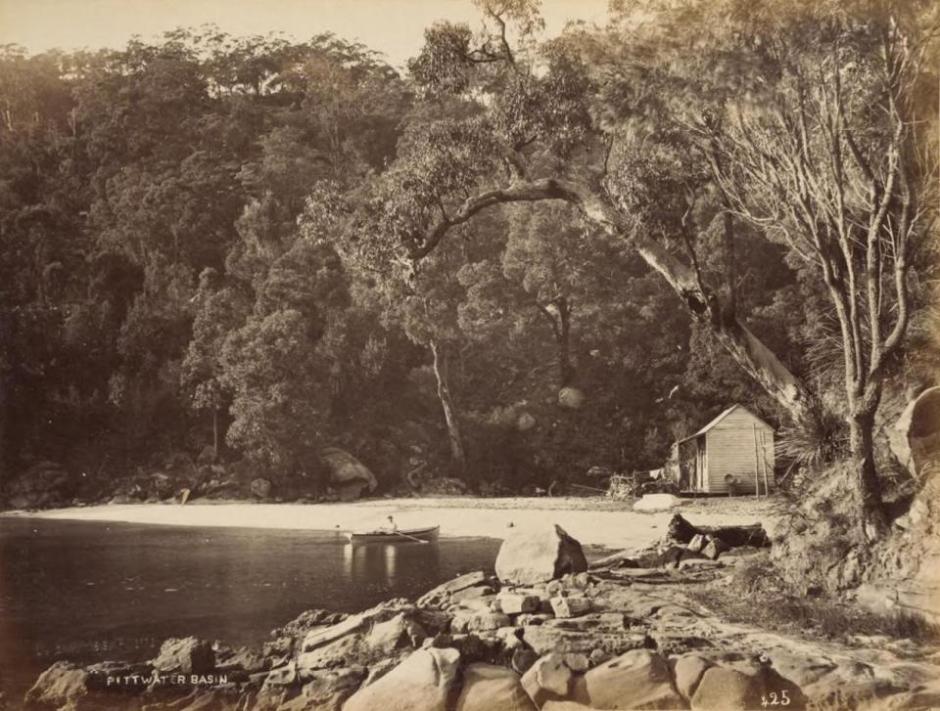
Rowboat at Pittwater Basin, New South Wales, circa. 1880 by Charles Bayliss, Image No.: nla.pic-vn4277873, courtesy National Library of Australia.
Frederick Jackson, who did have land at The Basin, sold that to the Ku-Ring-Gai Chase Trust in 1916 (gazetted-dedicated in 1917), although the last resident allowed officially there, 'Sally' Morris of The Basin, resided in her home on the beach until she passed away.
Prior to that though, 7 1/2 acres and 15 acres were dedicated to the national park at Coaster's Retreat in 1911.
The area was first inhabited by Indigenous Australians, the Kuringgai (also spelt Ku-ring-gai, Kuring-gai, Guringai). The Kuringai were hunters and gatherers. The Basin, adjoining Coasters Retreat is particularly rich in Aboriginal Heritage sites including The Basin Track Engraving Site, featuring petroglyphs of hunters, kangaroos, fishing and Wallabies. On the headland north of Coasters Retreat, is the Red Hands Cave, featuring a hand print in red ochre. Other hand prints, and pictographs, middens and carvings can be found in the locality. On the foreshore at Coasters retreat is an Aboriginal carving of a Dolphin.
The lands of The Basin and Coaster's Retreat changing hands begins prior to that though. In 1833 Martin Burke applied for a grant of land at The Basin, which then comprised a small flat of land of about four acres and the tiered hillside where Chinese Market gardeners had constructed terraces to hold growing produce.
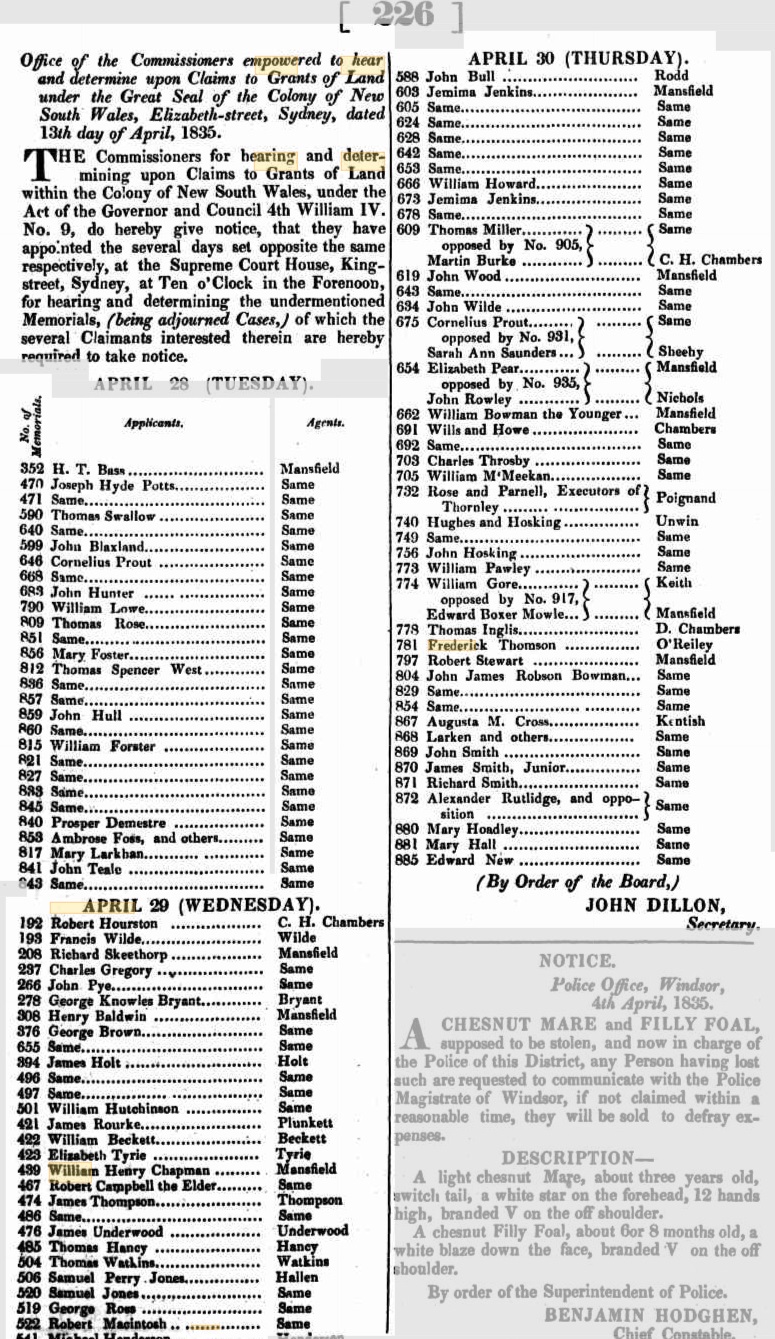
Government Gazette Notices (1835, April 22). New South Wales Government Gazette (Sydney, NSW : 1832 - 1900), p. 226. Retrieved from http://nla.gov.au/nla.news-article230655181
Robert McIntosh II (junior - who had married Jane Pymble in 1830) ended up purchasing the land at the Basin, which Martin Burke had applied for, but not proceeded to purchase. He applied to purchase it on May 30th 1834, and paid £17 10s for it on 31 December 1834. The deed was executed on 8 April 1835. [LTO SN38/91] He sold this land to William Oliver on 28 December 1839 for £50. [2.]
Patrick Flinn or Flynn applied for 50 acres at Coasters Retreat on January 21st 1839. This land was purchased by John Andrews on April 18th 1842. John Andrews, a former soldier of the NSW Army Corps by Governor Gipps, gave the name "Soldiers Point" on the western extremity of the south headland, with agriculture beginning on a small scale.
Crown Lands.-A sale of crown lands took place yesterday ; there were only ten lots, put up, of which seven were sold. In the parish of Manly Cove, 20 acres were sold to John Wheeler at £l 14s. an acre; 17 acres to Charles Chapman at 29s. ; 19 acres to John Wheeler at 27s. ; 100 acres to John Thompson at 14s.6d. ; 100 acres to C. Andrews and J. Skully at 12s. In the parish of Broken Bay, 50 acres to C. Andrews at £1; and 30 acres to William Oliver at £1 10s. The total, amount of the sales was £311 16s., of which £110 is soldiers' remission money, so that the actual sum paid into the Treasury will not exceed £200. For a section in the county of Wellington, 37acres on the Bathurst Road, and 50 acres at Broken Bay, there were no offers. COMMISSIONERS OF THE SUPREME COURT. (1842, March 10). The Sydney Herald (NSW : 1831 - 1842), p. 2. Retrieved from http://nla.gov.au/nla.news-article12874119
James McCawley, a soldier in the 28th Regiment of Foot, from North Gloucester, which came to Australia in 1835, purchased the land adjoining John Andrews. Shelagh Champion OAM and George Champion OAM state in their Profile of the Pioneers (2013):
Regulations allowed discharged soldiers to take part of their pay by remission of the purchase price of land. As a Private, McCawley was entitled to £25 remission. He purchased 50 acres adjoining John Andrews’ grant for £30, paying the remaining £5 to the Colonial Treasurer. The land was granted to him on 18 April 1842. [LTO SN75/7]
However, being chief constable at Cassilis, he never lived on the land. He sold it to Gordon Gwynne, surgeon of Parramatta for £23, and Gwynne sold it to John Williams of Baulkham Hills on 16 August 1843 for £15. [LTO Book 7 No.567] The land remained unoccupied. [2.]
%20Coasters%201885%20and%20earlier%20canceleed%20dec%201886.jpg?timestamp=1567538626319)
NSW Historical Land Records, Coasters Retreat and The Basin pre 1885 - land map cancelled December, 1886 - courtesy NSW Records and Parish and Historical Maps
In December 1854 the Olivers, who had been farming the land at The Basin, sold their holding to William Small for £300. In 1855 Mr. Small mortgaged The Basin land for £600 to the Oriental Bank Corporation.
Jim Macken, in his 'Sally Morris of The Basin' (2001) states that three Bills of Exchange were drawn by financier M. A. Worms but in June 1877 Mr. Small died intestate and the bank moved in to make a claim:
In the Supreme Court of New South Wales. ECCLESIASTICAL JURISDICTION.
In the goods of William Small, late of Brisbane Water, in the Colony of New South Wales, former, deceased.
NOTICE is hereby given, that after the expiration of fourteen days from the publication hereof in the New South Wales Government Gazette, application will be made to the Supreme Court of New South Wales, in its Ecclesiastical Jurisdiction, that letters of administration of the goods, chattels, credits, and effects of the above named William Small, deceased, may be granted to John Skinner, as Manager of the Oriental Bank Corporation, a creditor of the said deceased.—Dated this first day of April, in the year of our Lord one thousand eight hundred and seventy-eight.
WANT, JOHNSON, & WANT, Proctors for the said John Skinner. 2295 6s. 6d. ECCLESIASTICAL JURISDICTION. (1878, April 2). New South Wales Government Gazette (Sydney, NSW : 1832 - 1900), , p. 1370. Retrieved from http://nla.gov.au/nla.news-article223113095
PITT WATER, BROKEN BAY.
ORIGINAL GRANT of 50 ACRES, at the BASIN, being lot 24 sold, by proclamation of 17th June, 1834, to ROBERT MACINTOSH.
It is described as commencing at a marked tree in a small bay at Pitt Water, and bounded on the west by a line north 22 chains, on the north by a line east 25 chains to Pitt Water, and on the south-east and all other sides by that water to the marked tree
RICHARDSON and WRENCH have received instructions to sell by public auction, at the Rooms, Pitt-street, on FRIDAY, 31st May, at 11 o'clock.
The above-described romantically-situated 50 acres of good land at Pitt-water. This is a well-known property, being the camping grounds of the yachtsmen in a bay under the SOUTH-WEST shore of PITT WATER, about two miles from Barrenjoey. Plan at the Rooms. Terms at sale.
Messrs. WANT, JOHNSON, and WANT, Gresham street, Solicitors of the vendor. Advertising (1878, May 18). The Sydney Morning Herald (NSW : 1842 - 1954), p. 14. Retrieved from http://nla.gov.au/nla.news-article13422340
John Skinner, on behalf of the bank, sold Mr. Small's 50 acres of land to Frederick James Jackson, RSYS and RPAYC yachtsman and insurance broker, for £50 in 1881. A holiday house the Jackson's named 'Beechwood' was built at The Basin in 1881 and finished by 1882. This was used by the family and F J Jackson's sailing friends and fellow members of the Royal Sydney Yacht Squadron and the Royal Prince Alfred Yacht Club. Mr. Jackson was a founding member of both these clubs.
His most famous yacht was 'Violet' although he had others, among these Mischief, Gitana, Valeria, Ione.
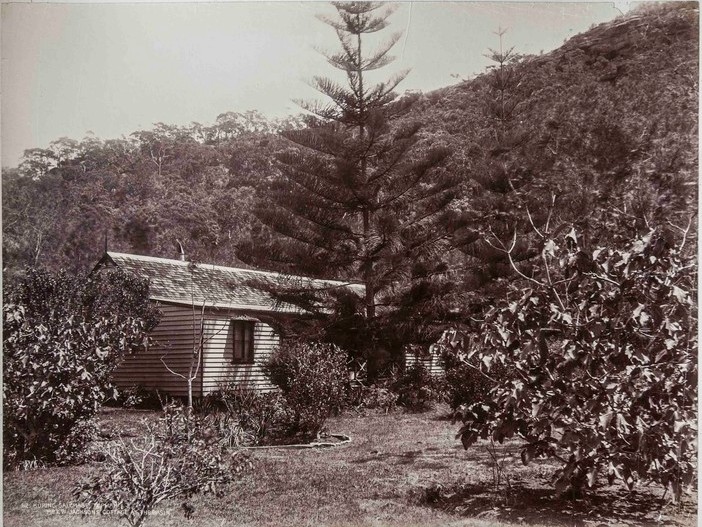
Topham - "Beechwood" also sometimes as 'Beachwood' Mr. F. W. Jackson's cottage at "The Basin"
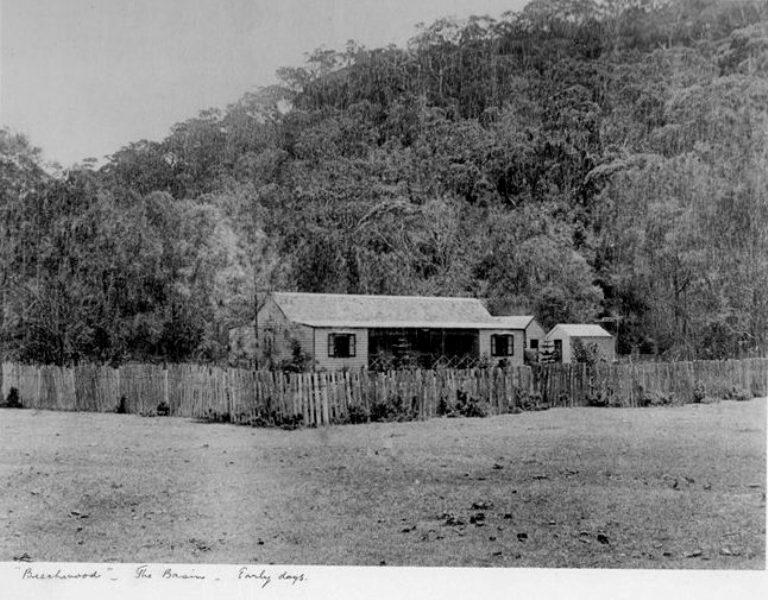
In 1910 Mr. F J Jackson brought his land under Torrens Title:
Frederick James Jackson 43 acres 1 rood 1 3/4 perches at Basin & Coasters Retreat in Pitt Water in Shire Warringah Parish Broken Bay County Cumberland Volume 2256 Folio 167
Date range:
09/03/1910 to 25/05/1912
Item Number Or Control Symbol:
PA 16450
Descriptive Note:
Primary Application - Frederick James Jackson 43 acres 1 rood 1 3/4 perches at Basin & Coasters Retreat in Pitt Water in Shire Warringah Parish Broken Bay County Cumberland Volume 2256 Folio 167
Access Direction:
Effect: Early; Duration:
NOTICE UNDER REAL PROPERTY ACT
APPLICATION having' been made to bring the lands hereunder described under the provisions of the Real Properly Act. Certificate of Indefeasible Title will issue, unless Caveat be lodged in accordance with the said Schedule to the said Act, on or before August 3. 1910;—
No. 16,450. APPLICANT:— Frederick James Jackson, Darling Point, Sydney. LAND:— County Cumberland, parish Broken Bay, shire Warringah, 43 acres 1 rood 1 3/4 perches at the Basin and Coasters Retreat in Pitt Water, part 50 acres (portion 14 of parish), granted to Robert Mcintosh; adjoining property of Trustees of Kuring-gai Chase.
Diagram delineating this land may be inspected at the Land Titles Office, Elizabeth-street, Sydney.
W. G. H. Williams.
Registrar-General.
June 15, 1910. Advertising (1910, June 18). The Daily Telegraph (Sydney, NSW : 1883 - 1930), p. 23. Retrieved from http://nla.gov.au/nla.news-article239418207
The application did not sit well with Sally Morris and Victor Le Gay Brereton, a solicitor and regular visitor to The Basin, acted on her behalf by applying for a restraining order. Jim Macken's 'Sally Morris of The Basin' states (page 18):
In answer to Sally's application for the restraining order Jackson swore an affidavit dated 25/7/1910 stating:
Purchased property April 1881. Conveyance dated 14/4/1881 - arranged with Mary Ann Morris to be caretaker for one pound per month and permitted her to run her cattle on the land. In the year 1882 I erected upon the property a seven room weatherboard dwelling house and out buildings. I or some of my family have resided in the said house once a month ever since. In addition to my paying her one pound per month she has rendered services to my family in the said house for which she was paid in addition.
From the year 1886 I employed a Chinese gardener upon the property who lived in a cottage on the land and who worked continuously upon the orchard and garden upon the property during the whole of these years. [3.]
In the ANMM collection's album 'Photographs of boating on Pittwater including steam yacht ENA' circa 1890, one of these images appears to show the terraces of gardens that once went upwards on the hills above the Basin, as mentioned by Jim Macken in his Sally Morris of the Basin:
.jpg?timestamp=1567062868843)
The dispute was resolved by agreement in February 1912 with Mr. Jackson granting Sally a lifetime lease over the land she inhabited in exchange for which she allowed the land to be brought under the Real Property Act. A formal lease was issued, dated October 1914, of the land on which Sally's house stood, gave her the lifetime lease promised.
Mr. Jackson's The Basin holding was transferred to the Kuring-Gai Chase Trust in July 1916 - the Notice reflecting Mary Ann's established lease:
Department of Lands,
Sydney, 1st December, 1916,
Proposals under section 25, Crown Lands Consolidation Act, 1913, in respect of a Public Recreation Ground (addition) at The Basin, Pittwater.
WHERE AS I am of opinion that it is expedient in the public interest to resume an area of 42 acres 2 roods 7 perches of land at The Basin, Pittwater, dedicated 28th July, 1915, for Public Recreation (addition), and described in the Schedule hereto: Now, therefore, notice is hereby given, in accordance with the provisions of the 25th section of the Crown Lands Consolidation Act, 1913, that it is proposed to deal with the said land in the manner following, that is to Bay,—to revoke the dedication of the said area of land heretofore made, and to re-dedicate the said area for Public Recreation as an addition to Ku-ring-gai Chase. [Ms. 1916-12,505]
W. G. ASHFORD, Minister for Lands.
Schedule referred to.
Description of an area of 42 acres 2 roods 7 perches at The Basin, Pittwater, dedicated 28th July, 1915, for Public Recreation (addition), the dedication of which is intended to be revoked, and which is intended to be rededicated for Public Recreation as an addition to Ku-ring-gai Chase.
All that piece or parcel of land containing 42 acres 2 roods 7 perches or thereabouts, situated at The Basin, Pittwater, Warringah Shire, parish of Broken Bay, county of Cumberland, being the land comprised in Certificate of Title, registered volume 2,256, folio 167, as shown upon plan catalogued Ms. 3,316 Sy. Exclusive of two areas (I rood 10£ perches and 1 rood 19i perches), and a light-of-way 12 feet wide connecting same, which- form the subject of Real Property Act lease No. 661,6*20 to Mrs. M. A. Morris for the term of her life.
Government Gazette Notices (1916, December 1). Government Gazette of the State of New South Wales (Sydney, NSW : 1901 - 2001), p. 7108. Retrieved from http://nla.gov.au/nla.news-article225964801
On the Coaster's Retreat side; Joseph Shaw was residing at Pittwater when John Andrews agreed to sell him six acres “to commence and be taken from the western boundary” of his farm at Coasters Retreat, on May 4th 1849. Andrews agreed to give Shaw legal title “at any time he may require” on condition of the purchase money being paid. John Collins drew up and witnessed the agreement. [LTO Book 82 No.492] James Shaw, dealer in shells for lime at Pitt Water, was listed in the Sydney Commercial Directory for 1851. Joseph Shaw, with a freehold house and land at Pitt Water, was listed in the electoral roll (St. Leonards) for 1859-60. Three children of Joseph and Susan Shaw are listed in the records: Joseph (b.1847); James (b.1849); and Martha (b.1852).
In October 1859:
John Andrews, of Pitt Water, was charged, on the information of Joseph Shaw, with having wilfully and maliciously killed a calf, the property of informant. Mr. Borton appeared-for plaintiff; Mr. Moffatt for defendant. Several witnesses were examined, from whose evidence it appeared that about midnight of the 21st day of last month, prisoner entered plaintiff's ground adjoining his own at Pitt Water, and with a stick beat a calf belonging to complainant, from the effects of which the animal died the following day. Its head having been much bruised and its neck broken. The attorney for the prosecution having omitted to place complainant in the box to swear in support of the information, and to identify prisoner as the John Andrews there mentioned, defendant's attorney on those grounds raised an objection, which was ruled by the Bench to be fatal to complainant's case, and it was therefore dismissed. WATER POLICE COURT. (1859, October 5). The Sydney Morning Herald (NSW : 1842 - 1954), p. 3. Retrieved from http://nla.gov.au/nla.news-article13031574
The agreement for sale, indicating that Shaw paid £6 for the six acres of land at Coasters Retreat, was registered on April 8th 1863, suggesting that this had been, and was then, the Shaws’ place of residence. Joseph Shaw could not sign his name, and John Collins witnessed his mark. However, in a statutory declaration dated 6 July 1889, Collins’ widow Honorah stated, “At the time the conversation took place between Joseph Shaw and John Collins, Shaw said, ‘I have no money to give you for the land,’ when Collins replied, ‘I do not want any.’ My late husband put the receipt on the document at Andrews’ request.”
On November 4th 1859 John Andrews sold his grant to John Smith for £150. When Mr. Smith made a trip to Sydney then returned he found others in residence:
Owen Golden, James Scott, and Margaret Downs were, on the information of John Smith, charged with having committed an assault upon him. Smith stated that he was a farmer, residing at Pittwater. On the 14th of November last he went down to Pittwater to see some land he had purchased from John Andrews, when he found the prisoner Downs living there. He asked her if she was going to leave the place, as he wanted the land. She replied, " I will not leave it so long as there's a stick stands up in the building."
The two other defendants were present. Smith showed them his title and deed of purchase, asking them to read the documents; but they said there was no necessity. He then told them he should take the door down, and he tipped it off the wire, and took it to his house, which was at a short distance. Subsequently he went back, and knocked one of the slabs off the house, and went inside. Golden then took up one of the laths from the sofa, and struck Smith with it on the arm; Downs seized the kettle and threw some boiling water over him. Whilst he way trying to remove a slab near the chimney Downs attacked him with a piece of burning wood ; but he kept her away with an axe until the three defendants set upon him, got him down, and took the axe from him. The house was empty when Smith purchased the land (which was a grant to Andrews), and whilst he was in Sydney prisoners took possession of it; the house was about fifteen rods within the boundary. The only thing that Scott did was to take the axe from Smith; Golden struck him on the wrist with a batten. John Andrews deposed to having sold the land and house to Smith, and when he put Smith in possession of them no one was living in the house.
Some seven or eight years ago it was in the possession of a man named Joseph Shaw, to whom he agreed to sell it, with six acres of land ; Shaw built the house and was to give Andrews £6 for it, for the fulfilment of which he gave £1 as a deposit. There was a written agreement which Shaw kept, but he deserted the place in September last. Andrews then sold the place to Smith, the agreement with Shaw not having been completed. Smith (who lived with Andrews) on the day of the assault came home with his shirt nearly torn off his back, and his shoulders and loins so scalded that the skin came off in a day or two. He had also a cut on his arm which he could not use for several days, as well as a sear on his cheek like a burn. Downs, in defence, said her husband took possession of the house from Mr. Ross, custom-house officer, at Broken Bay. Scott was discharged, and Golden and Downs committed for trial at the next Quarter Sessions. Bail allowed. WATER POLICE COURT. (1860, June 5). The Sydney Morning Herald (NSW : 1842 - 1954), p. 3. Retrieved from http://nla.gov.au/nla.news-article13041403
The original John Smith passed away from tuberculosis on April 13th, 1862, aged 37 and was buried on the land.[3.]
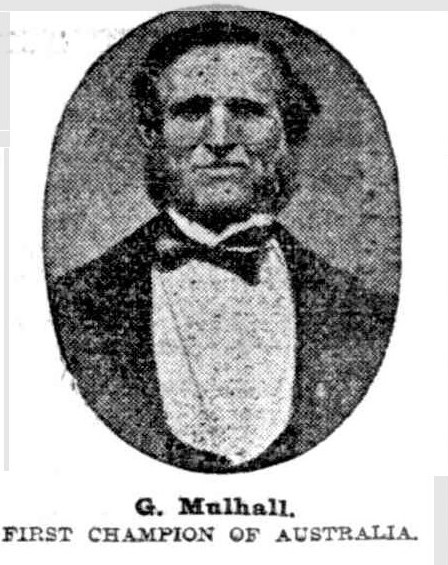 The 1860's also marked the regular commencement of 'excursionists' making visits to Pittwater with The Basin (then also called 'Blind Cove') at times included. The mouth into the inner Basin being a lot wider and deeper than it is today, larger steamers could get in and out safely.
The 1860's also marked the regular commencement of 'excursionists' making visits to Pittwater with The Basin (then also called 'Blind Cove') at times included. The mouth into the inner Basin being a lot wider and deeper than it is today, larger steamers could get in and out safely.
This report also mentions the first Lightkeeper at Barrenjoey when that light kept was a fire in a basket and George Mulhall, first rowing champion of Australia:
EXCURSION TO BROKEN BAY.
One of the many agreeable means of recreation afforded to holiday-keepers on Monday was an excursion to Broken Bay, in the A. S. N. Company's large and powerful paddle-steamer Telegraph. The citizens of Sydney are unquestionably eager to avail themselves of every opportunity of breathing the fresh air, and of enjoying the beauties of the harbour or inIand scenery but these opportunities have been, hitherto chiefly confined to trips about the harbour and the Parramatta River, and upon the railway.
In deciding to despatch one of their best steamers to Broken Bay, the directors of the A. S. N. Company ' judiciously provided an entire novelty in holiday excursions, and tempted the public by offering, in addition to a trip up the harbour, and a short taste of the ocean, a visit to one of the many romantic inlets on our coast, whose charms would be more appreciated by the citizens if their own harbour were less beautiful. Every nook and corner of the more popular places of holiday resort being now thoroughly familiar with most of the Sydney excursionists, the chance of seeing a new spot, and of spending the whole day upon the water, was extensively welcomed.
The Telegraph left the Company's Wharf, at half past nine o clock, with a fair complement of passengers, and on reaching the Circular Quay, found another company waiting her arrival. The number of excursionists amounted to nearly four hundred, amongst them were several of our most influential citizens, accompanied by their wives and families. So for as space was concerned, the commodious steamer could have accommodated a much larger company, and had it been foreseen how many would have availed themselves of the trip, a more satisfactory arrangement would have been made for the excursionists in the article of refreshments, provision having only been made for the wants of about two hundred persons.
In every other respect the excursion was extremely successful. More desirable weather could not have been wished for a trip, which, under any circumstances, must have been attended with discomfort to 'bad sailors.' The breeze scarcely ruffled the bosom of the Pacific, and the motion of the steamer ' was, consequently, so gentle, that scarcely any even of the ladies, appeared to be uncomfortably affected by it.
From the North Head to Barenjo Head— the South Head at the entrance to Broken Bay — the distance is about fourteen miles, and was accomplished by the Telegraph in little more than an hour.
The appearance of the scenery on rounding the Head was the admiration of the excursionists, many of whom remarked a resemblance between its main features and those of Middle Harbour ; the lofty abrupt rocks, covered with rich foliage down to the water's edge, and the indentations being frequent and irregular. Upon entering the bay the steamer proceeded to Blind Cove, one of the most romantic inlets of the bay, and the anchor being dropped, a stage was improvised for allowing such of the excursionists as chose to explore the bush. A few availed themselves of the opportunity, and either strolled about the bush or partook of the refections they had provided themselves with under the shady trees. They remained on shore for about an hour, during which time the steamer went for a short distance up the river Hawkesbury— George Mulhall acting as pilot in the navigation of the bay.
The Telegraph left the bay shortly before five o'clock, and landed her passengers at the wharf, at half past six, all much delighted with their excursion. Everything seemed to conspire to the enjoyment of the day ;— the auspicious occasion — the merry company — the lively strains of music — the balmy weather — the tranquil, beautiful sea — the wild romantic scenery, all the more impressive because scarcely touched by the hand of industry — and, not least, the attentive exertions of Captain O'Reilly and his officers. In only one respect, as we have said, were the arrangements defective, and as yesterday's success will no doubt lead to a repetition of the excursion on same future holiday, it will be easy to provide against any shortness in provisions by ascertaining beforehand the number of excursionists and providing accordingly.
While the steamer was in Broken Bay a portion of the company, amongst whom were Mr. S. D. Gordon, Mr. R. Hill, Mr. Wilson, M.L.A., and Mr. J. Fairfax, were invited to partake of the hospitality of Mr. Clark . Irving. During the convivialities which followed, the healths of Mr. Irving and Mr. Robey, as directors of the A. S. N. Company, and of Captain O'Reilly, were drunk, and were suitably responded to. In acknowledging the former toast, Mr. Irving said, on behalf of the directors, that they showed every disposition to meet the wishes of the public in regard to the arrangements for transit, and that he confidently anticipated that, within seven years, the A. S. N. Company would carry the English mails, the route being by way of Queensland, which colony, and probably New Zealand also, would unite with New South Wales in the postal contract. EXCURSION TO BROKEN BAY. (1861, April 6). Sydney Mail (NSW : 1860 - 1871), p. 2. Retrieved from http://nla.gov.au/nla.news-article166689845
The NSW Dept. of Environment and Heritage records of Maritime history and information on dive sites states:
On the fine, clear morning of 9 October 1867, the 367 iron paddle steamer Telegraph ran onto rocks offshore from Camden Haven. It was a significant loss as the steamer was regarded as "one of the finest and decidedly the fastest operating" on the coast.
Owned by the Australasian Steam Navigation Company (ASN), a later inquiry alluded to a misunderstanding over who was in command at the time. Captain Fitzsimons was adamant that the Chief Officer, Rozea, had charge of the boat and that he was too near the land. As Captain Fitzsimons came on deck he exclaimed, "Good God Rozea, you are too close in!". The captain later suggested that perhaps the passengers had coerced the Chief Officer to steer inshore, so as to view the wreck of the Prince of Wales. In any event, the Telegraph grounded on the rocks, allowing passengers and crew to row ashore. One passenger took great pains to guard his cargo of sheep once they had swum from the wreck.
In time the steamer broke in two although some cargo and fittings were salvaged. The 67.36 m Telegraph was built at Glasgow, Scotland, in 1854. Today the site is named Telegraph Rock and the wreck is often visited by scuba divers.
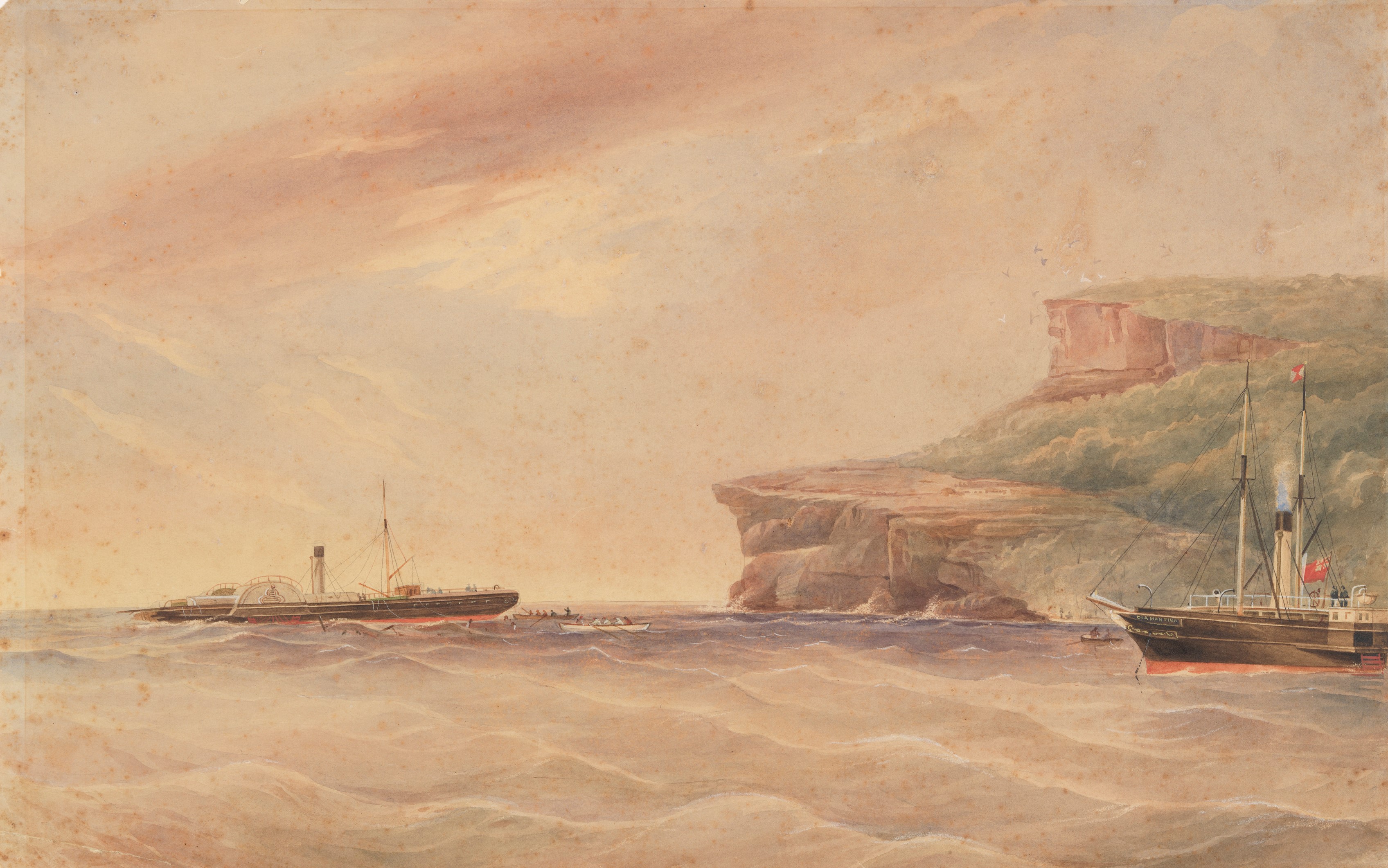
Wreck of the Telegraph off Camden Head [1867] by Frederick Garling, 1806-1873. Item No.: c12746_0003_c, courtesy Dixson Galleries, State Library of New South Wales
ANNIVERSARY DAY.-STEAM EXCURSION TO BROKEN BAY.-The splendid powerful steamship KEMBLA will, by special desire, make an EXCURSION to BROKEN BAY, PITTWATER, and the LOWER HAWKESBURY. Excursion Return Ticket, 5s. Advertising (1862, January 18). Empire (Sydney, NSW : 1850 - 1875), p. 1. Retrieved from http://nla.gov.au/nla.news-article60508518
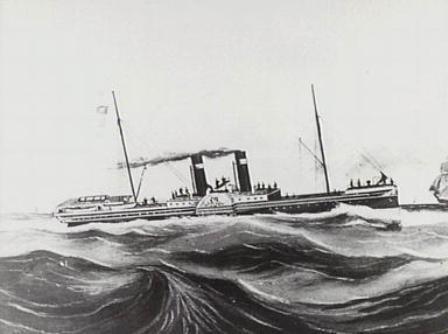 Right: The Kembla was originally a 325 gross tons, 204 net. Lbd: 185'1" x 22'1" x 11'5". Iron paddle steamship built by J Reid & Co., Glasgow for the Illawarra S N Co., Sydney.
Right: The Kembla was originally a 325 gross tons, 204 net. Lbd: 185'1" x 22'1" x 11'5". Iron paddle steamship built by J Reid & Co., Glasgow for the Illawarra S N Co., Sydney.
Of 2 cylinder LP producing 165 horsepower and capable of 14 knots.
She was lengthened in 1873 becoming of 449 gross tons, 283 net with Lbd: 209'2" x 22'6" x 11'5".
Later owned by C J Stevens who formed the Newcastle Steamship Co Ltd.
These were both fair sized vessels.
On October 10th 1872 Andrews’ grant was conveyed to John Collins in exchange for a smaller block with a cottage on it at Careel Bay. A query arose later as to whether the Shaws had some legal right to the land, but this was discounted by the authorities, on Mrs Collins’ statement. [2.]
The Shaws must have been close friends of the Oliver family, who lived nearby, as Martha married Thomas Albert Oliver in 1871, and James married Ann Oliver in 1874. A Joseph Shaw died in 1872, aged 77, and a Susan Shaw died in 1876, aged 72. James Shaw, residing at Towler’s Bay, Pitt Water, was listed in the 1869-70 electoral roll; James Shaw and Joseph Shaw junior were listed in 1873-74. A Conditional Purchase of 40 acres of land at Towler’s Bay by Joseph Shaw lapsed, and was taken up by Arthur Wood, being granted to him on 10 July 1889. [2.]
Coasters Retreat
The Andrews land was brought under Torrens Title in 1889:
NOTICE UNDER REAL PROPERTY ACT.
APPLICATIONS having been mode to bring the lands hereunder described under the provisions of the Real Property Act, Certificates of Indefeasible Title will issue, unless Caveats be lodged in Form B of the said Act, on or before the date named opposite each case respectively.
No. 7,492. Pittwater, 67 acres 2 roods 23 perches, near the Basin, comprises the land granted as 50 acres to John Andrews.
Applicant - Patrick John Collins of Pittwater. NOTICE UNDER REAL PROPERTY ACT. (1889, October 18). New South Wales Government Gazette (Sydney, NSW : 1832 - 1900), p. 7499. Retrieved from http://nla.gov.au/nla.news-article222101508
John Collins’ widow Honorah had conveyed this land to her son, Patrick John Collins, on September 28th, 1887. [2.] Patrick John Collins of Pittwater, born 1850, was the son of John and Honorah Collins of Avalon.
In Volume-Folio 968-149 is charted the John Patrick Collins'Coasters' land holding of 67 acres, 2 roods and 23 perches changing hands, first to William Cope of Sydney, Solicitor on May 14 1890, then some to Howard Castle-Smith on April 28 1898 and the residue came under Executors on March 15 1935:
.jpeg?timestamp=1768425857424)
.jpeg?timestamp=1768425941908)
.jpeg?timestamp=1768425989801)
.jpeg?timestamp=1768426073996)
.jpeg?timestamp=1768426135641)
Worth noting is the McIntosh Little Mackerel lands being brought under Torrens a few years prior to this:
NOTICE UNDER REAL PROPERTY ACT.
APPLICATIONS Having been made to bring the lands hereunder described under the provisions of the Heal Property Act, Certificates of Indefeasible Title will issue, unless Caveats be lodged in Form B of the said Act, on or before the date named opposite each case respectively.
No. 6,858. Pittwater, 40 acres, near the Basin, on Little Mackerel Beach,—is part of 100 acres granted to Martin Burke. Applicant John Francis Charles M'Intosh, Dubbo. NOTICE UNDER REAL PROPERTY ACT. (1887, March 25). New South Wales Government Gazette (Sydney, NSW : 1832 - 1900), p. 2134. Retrieved from http://nla.gov.au/nla.news-article224183908
Coasters Retreat became enclosed by public park (and water) lands following the establishment of The Basin section of the Ku-Ring-Gai Chase National Park in January 1879, more calls for more land to be made public lands in 1884 and 1894, and acreage at Coaster's was dedicated in 1911 - see below. Those that had been visiting decades before were among the advocates for more land to be set aside for then and for future generations, as well as to suit their purposes of then:
Reservation at Broken Bay.
A deputation, consisting of the Hon. W. J. Trickett, M.L.A.; Mr. E. W. Knox; and Mr. James E. Fairfax, members of the Royal Sydney Yacht Squadron; Dr. Milford, commodore of the Prince Alfred Yacht Club, and Messrs. S. MacDonnell and E. M. Dietrich, of the Sydney Amateur Sailing Club, waited on Mr. Farnell, minister of Lands, on Friday to urge the importance of preserving for the benefit of the public the water frontage reservation at the Basin, Coasters' Retreat, Broken Bay, adjoining the piece of land at the head of the Basin dedicated for public recreation in January, 1879. It was pointed out by members of the deputation that the preservation of the 100ft water frontage was of the utmost importance to yachtsmen and boating men generally, as it facilitated their landing and the obtaining of fresh water, thereby enhancing materially the value of the recreation reserve as a public resort. Mr. Farnell promised to visit the place, with the view of having it dedicated in a similar manner to the reserve at Hunter's Beach. Reservation at Broken Bay. (1884, July 19). Evening News (Sydney, NSW : 1869 - 1931), p. 4. Retrieved from http://nla.gov.au/nla.news-article107267980
Department of Lands,
Sydney, 16th October, 1894.
PROPOSAL UNDER SECTION 105 CROWN LANDS ACT OF 1884, IN RESPECT OF THE PUBLIC RECREATION GROUND AT THE BASIN, PITT WATER.
WHEREAS His Excellency the Governor, with the advice of the Executive Council, being of opinion that it is expedient in the public interest to resume the whole of the 150 acres of land, dedicated on the 7th day of January, 1879, for Public Recreation at The Basin, Pitt Water, has directed that this notice, under my hand, shall be published in the Government Gazette, setting forth the mode in which it is proposed to deal with the land in question : Now, therefore, notice is hereby given, in pursuance of such direction, and in accordance with the provisions of the 105th section of the Crown Lands Act of 1884, that it is proposed to deal with the said land in the manner following, that is to say,—To revoke the dedication thereof heretofore made, and to dedicate the same for public recreation as an addition to an area known as the " Ku-ring-gai Chase," which it is proposed to set apart and dedicate for Public Recreation, in which Chase the said portion of 150 acres of land is to be included, and of which it is to form part.
[Ms. 94-6,806 Dep.] J. H. CARRUTHERS.
Description.
All that piece or parcel of land situate at The Basin or Coaster's Retreat, Pitt Water, parish of Broken Bay, county of Cumberland, containing by Dedication List No. 1, of 7th January, 1879, 350 acres, but by admeasurement 224 acres: Commencing at the south-eastern corner of John Andrews' 50 acres, portion 15; and bounded thence by that portion and James M'Cawley's 50 acres, portion 3, northerly, westerly, and south-westerly to the north-western corner of the latter portion thence by the western boundary of portion 3 southerly to its south-western corner ; thence by a line bearing west 40 chains; thence by a line bearing north 61 chains 8 links; thence by a line east 35 chains 37 links to the north-western corner of R. M'Intosh's 50 acres, portion 14 ; thence by the western boundary of that portion southerly to a point distant 100 feet rectangularly from the high-water mark of Pitt Water; thence by lines parallel to and distant 100 feet from high-water mark bearing generally south-easterly and north-easterly to the northern boundary of R. M'Intosh's 50 acres, portion 14 before mentioned; thence by part of the northern boundary of that land, being a line easterly to the high-water mark of Pitt Water before mentioned thence by that high-water mark generally south-westerly, north-westerly, westerly, easterly, north-easterly, and southerly to a point east of the south-eastern corner of John Andrews' 50 acres, portion 15 before mentioned and thence by a line bearing west, to the point of commencement,—as shown on plan catalogued C. 39-2,063. PROPOSALS UNDER SECTION 105 CROWN LANDS ACT OF 1884, IN RESPECT OF THE PUBLIC RECREATION GROUND AT THE BASIN, PITT WATER. (1894, October 16). New South Wales Government Gazette (Sydney, NSW : 1832 - 1900), p. 6522. Retrieved from http://nla.gov.au/nla.news-article220939379
The above three people Mr. Smith found on the property he had bought were not the only people living in this offshore idyll. In the National Library of Australia's 'TROVE' and in Jim Macken's 'Sally Morris of The Basin', records from the earliest times of Europeans being in this locality the sheltered area being used as a retreat for 'coasters'.
There are also reports of people passing away in the area and some stones in the area bear carved memorials of sailors who have been interred.
CRUISING AT BROKEN BAY
From all the various amusements excursions heralded by more or less enticing announcements we may perhaps turn aside and give a short record of our yachtsmen and boat sailors who, whenever three or four days can be gained, invariably steal away along some 17 miles of open sea, and make Broken Bay a second Port Jackson. Tuesday morning the first of a fleet of 25 boats, or 20 excluding yachts, started with a fresh south-west wind, and arrived at midday under Barrenjoey, where boats generally send a wire back to Sydney announcing a late arrival. This was the Wanganella. On Wednesday evening she was joined by the Muriel, Pleiades, Iris, and Corinne. The Waitango arrived at midnight Wednesday, and before noon on Thursday the Maritana, Dreamland, Lottie, Snowdrop, Weringa (Mr. Charlton), Viking, Curlew, Cutty Sark, Asteroid, Pearl, Sibyl, Agnes, Zuluiku, Psyche, Colleen Bawn, had sailed round; while on Friday the Violet, Mistral, and Sao arrived. Besides these, which sailed round, many brought skiffs on steamers, which ensures a camp, if winds are not suitable for sailing round. However, fortunately, the wind was fair both ways, and the sea for the most part smooth, with a fair swell.
If any boats have been omitted from this list it is because they were not seen among the more popular haunts; but as it is, it may be taken as showing; that our Sydney amateurs have learnt something practical as well as racing in smooth water, as the fastest boats we have of all the lengths 20 feet and over prove themselves quite safe outside with pleasure sails.
Crews of two up to six or seven seemed to be the usual party, while the smallest boats were the Iris, 10 feet, aand Cutty Sark 20, Corinne 21 feet, and others, as will be seen from the list. From Beroura Creek, some 20 miles or more up, down to Pittwater, and between those places, Cowan Creek, Wagonga Creek, and the now-famous rendezvous, the Basin, boats covered in could be seen.
.jpg?timestamp=1567242416007)
The weather was very cool, but the wind very unsteady and shifting. Fish did not seem very plentiful. On Saturday evening most of the boats came down the river to the Basin, where there were 12 boats and three yachts at anchor; in fact, nowhere in Sydney harbour was there ever such a fleet of boats and boating men as occupied the bay that evening.
On Sunday morning, from daylight until noon, the boats began to drop down to the Heads, the Cutty Sark getting away at 6 a.m., and must have been one of the first back. About noon, when the sea breeze was well set, there were 11 boats, not counting yachts, between North Head and Broken Bay-a long line right up the coast. The Dreamland and Wanganella happened to jibe round Barranjoey together, and were about 12 minutes apart at North Head ; and there must have been other pairs of boats on the way down pretty well matched. By 2 in the afternoon all except one or two were back, some going to Manly to dine, and others coming straight down to their moorings. CRUISING AT BROKEN BAY. (1884, December 30). The Sydney Morning Herald (NSW : 1842 - 1954), p. 8. Retrieved from http://nla.gov.au/nla.news-article28365019
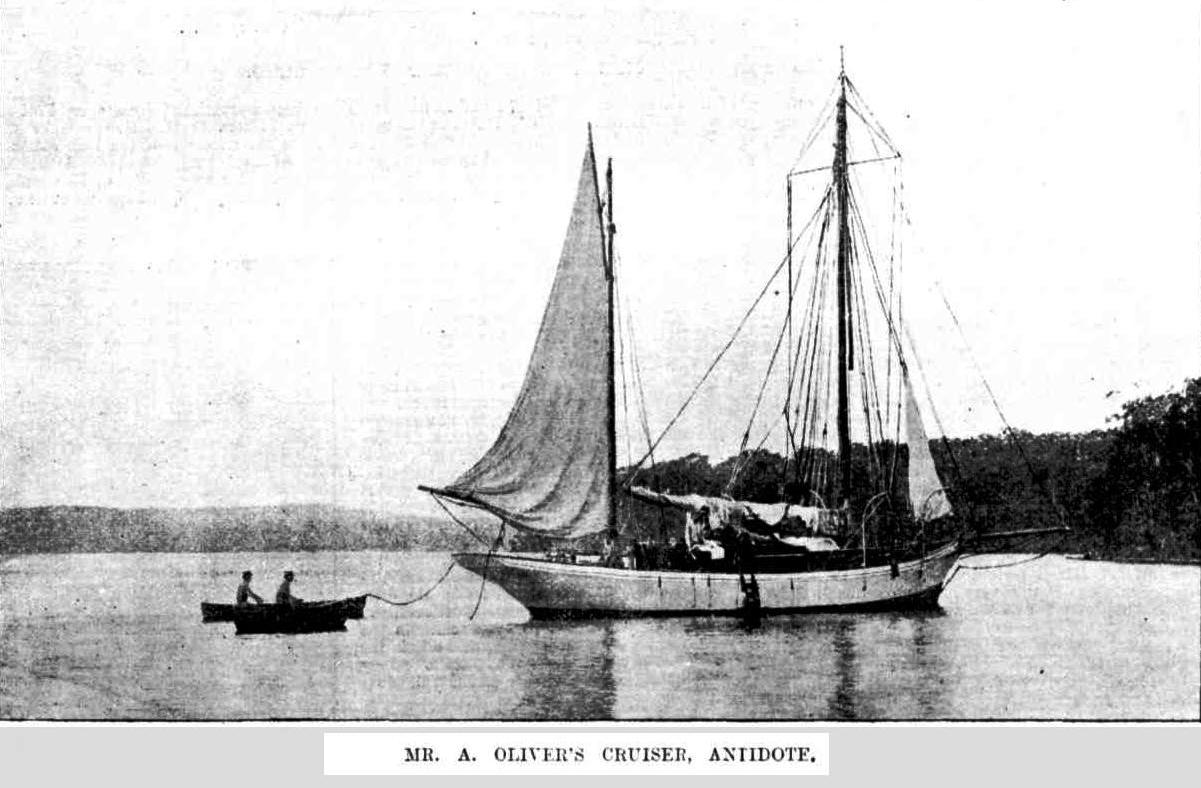
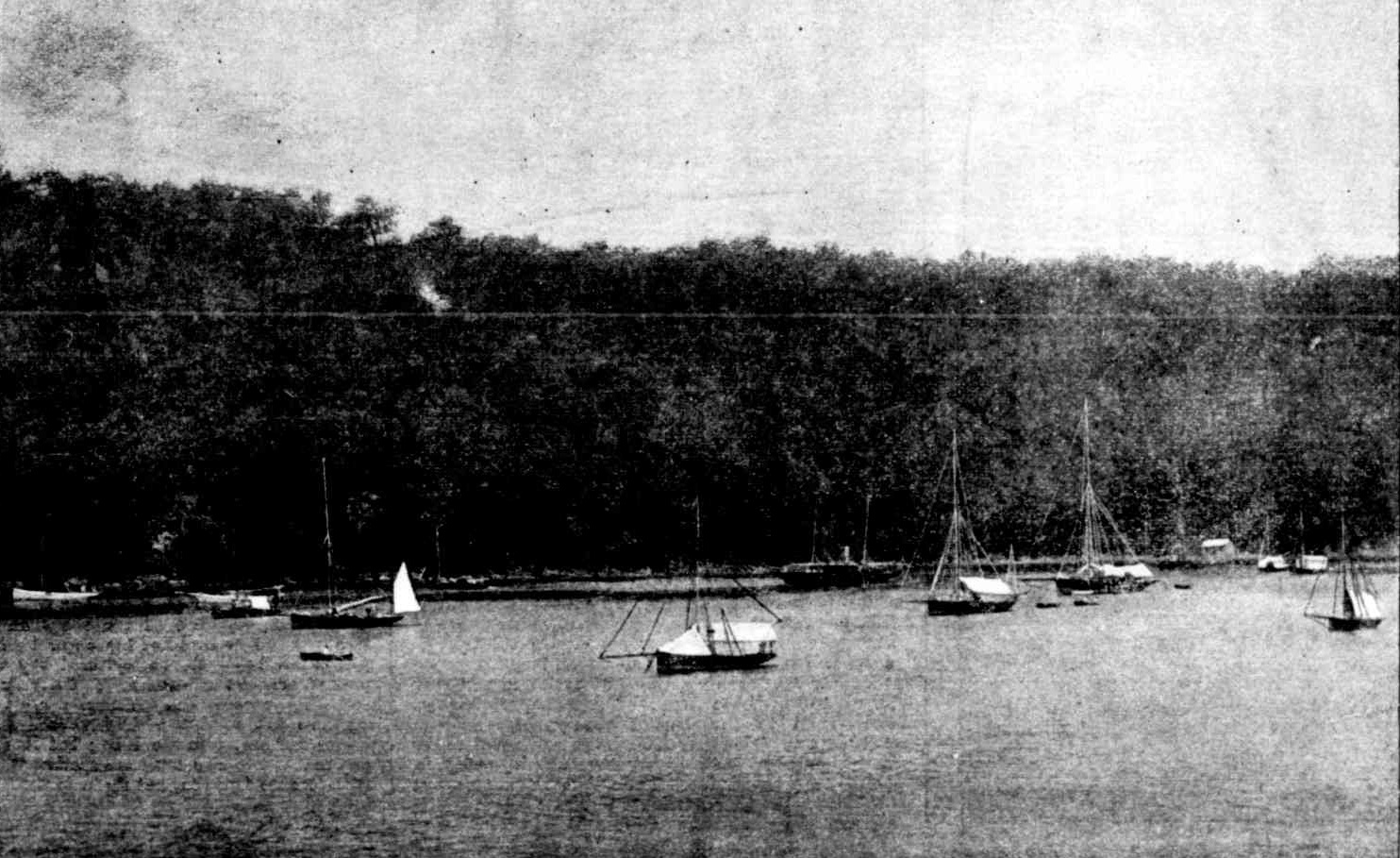
A FAVOURITE HOLIDAY RESORT
THE BASIN, BROKEN BAY
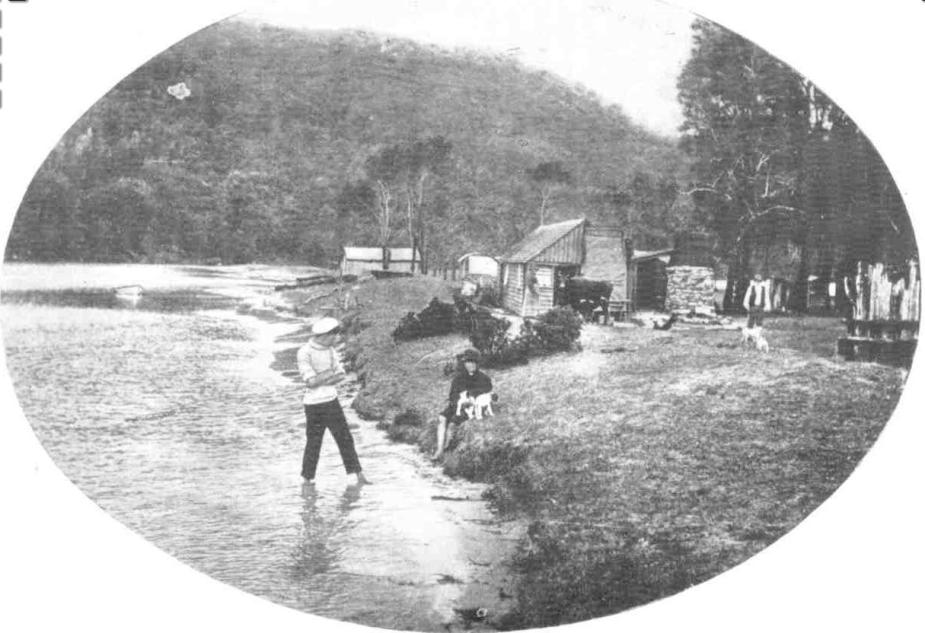
A FISHERMAN'S HOME AT THE BASIN, WHERE MRS. MORRIS HAS RESIDED FOR 37 YEARS.
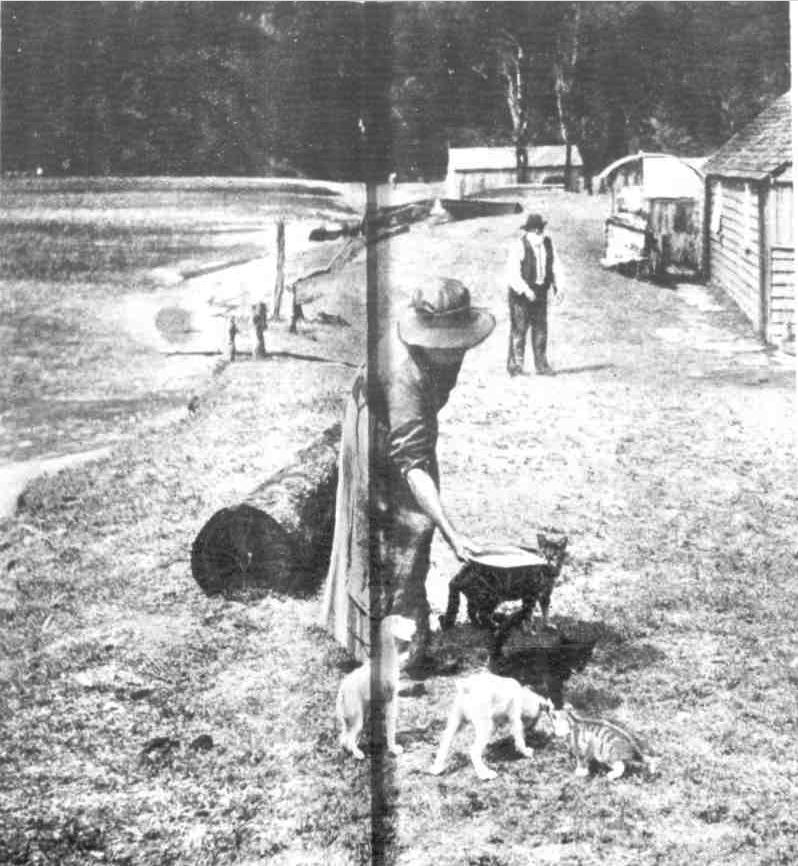
MRS. MORRIS AND HER PETS.
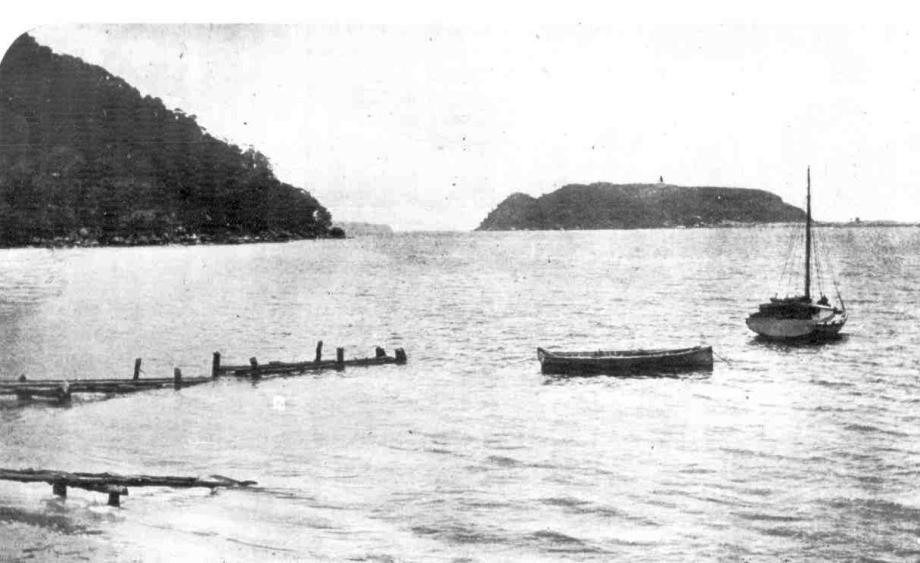
ENTRANCE TO THE HAWKESBURY RIVER. -THE BARRANJOEY LIGHTHOUSE.
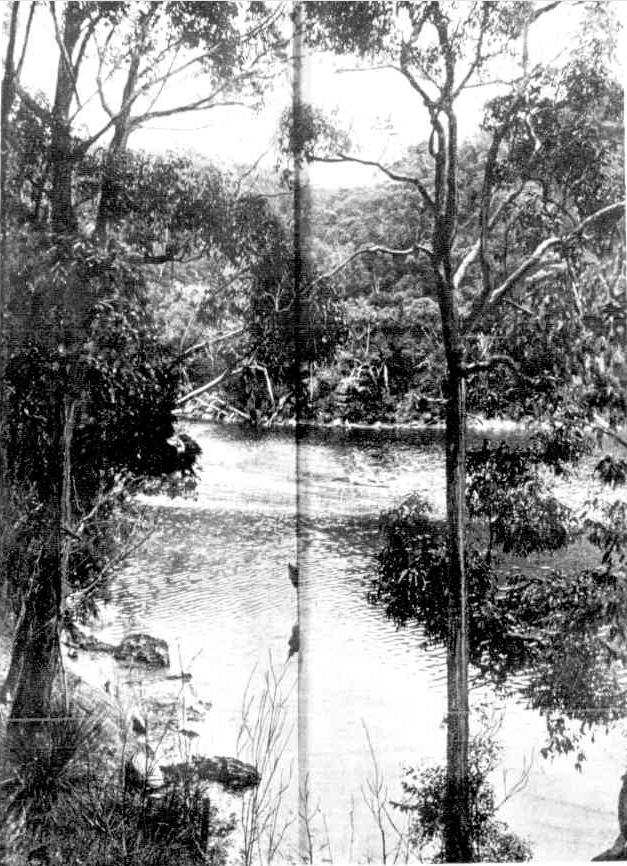
HEAD OF THE BASIN. THE BASIN, BROKEN BAY, NEW SOUTH WALES.
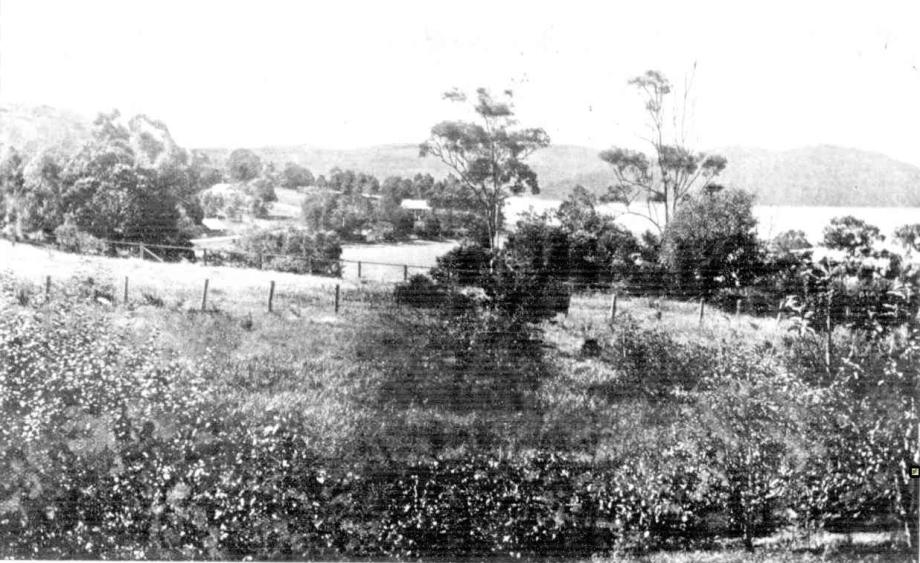
BAY VIEW, PITTWATER. (possibly included here as the photographer was transported to The Basin from the Bayview Wharf)
AN IDEAL CAMPING GROUND, HAWKESBURY RIVER.
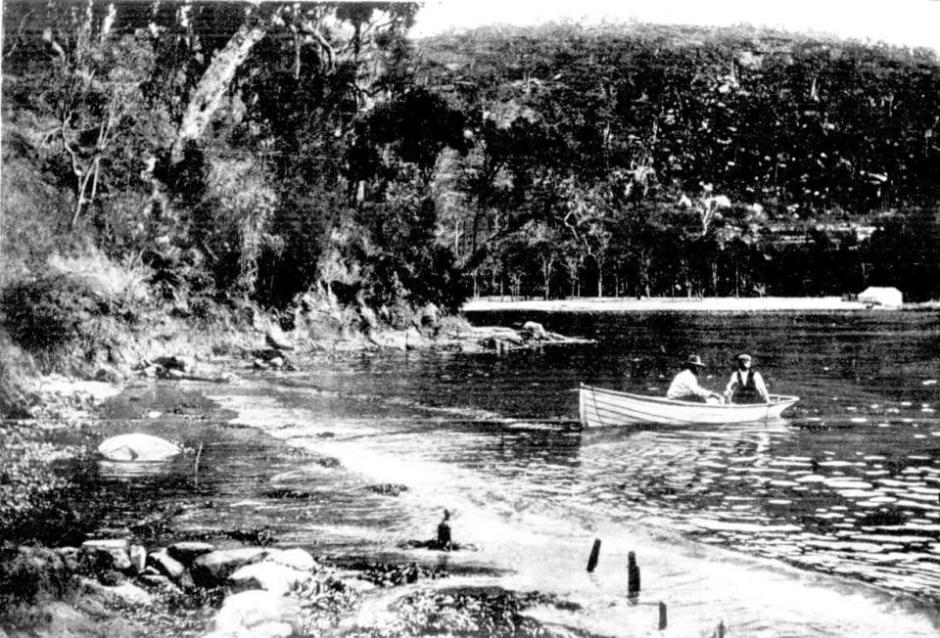
Above: "AN IDEAL CAMPING GROUND, HAWKESBURY RIVER. "1903 The Sydney Mail and New South Wales Advertiser article
Below: "GRILLED FISH FOR BREAKFAST." 1903 The Sydney Mail and New South Wales Advertiser article
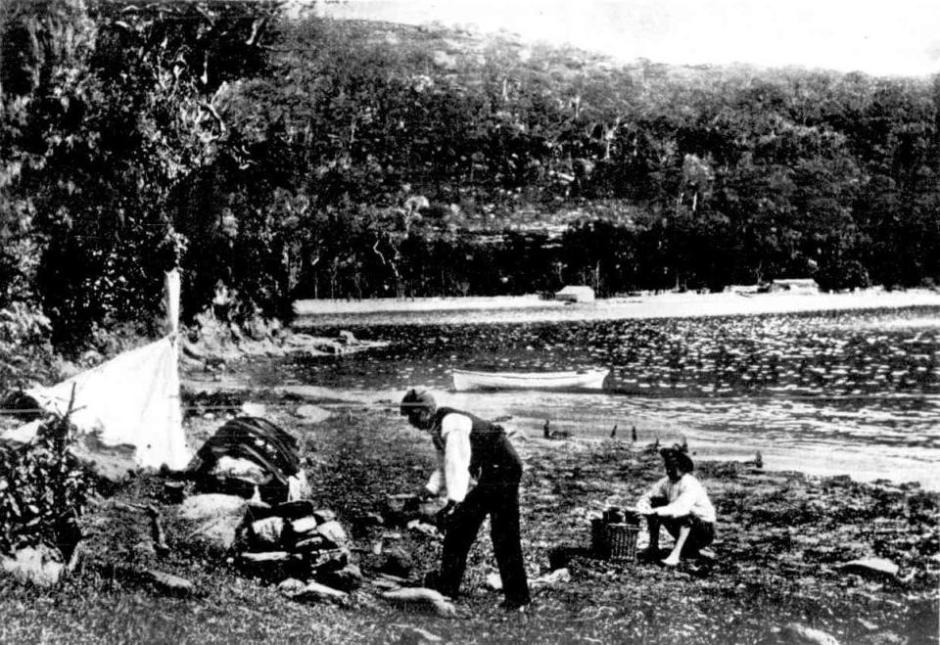
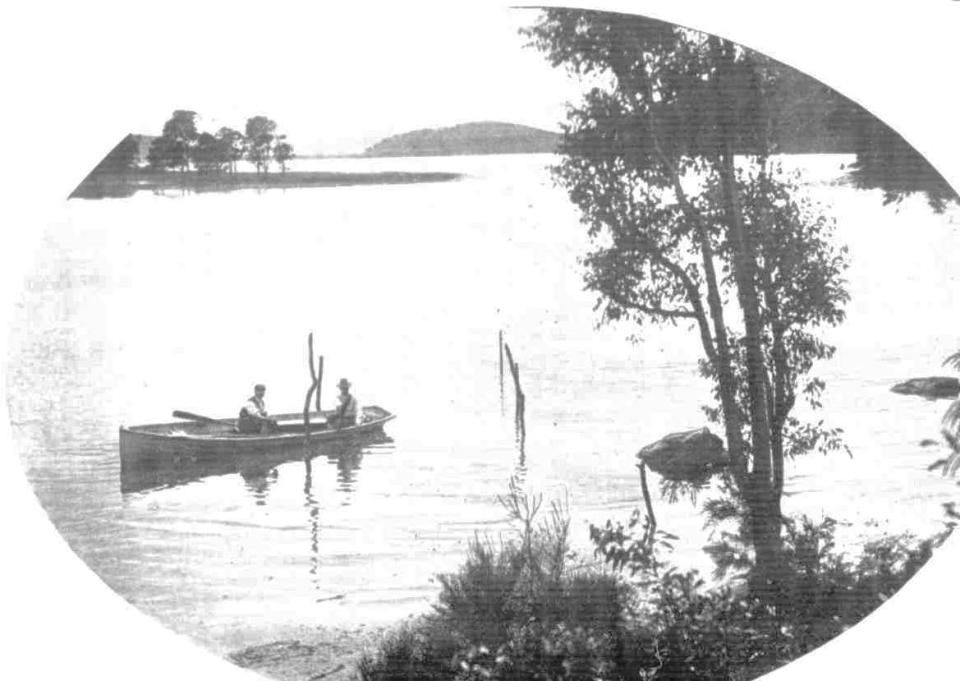
THE BASIN, BARRANJOEY. 1903 The Sydney Mail and New South Wales Advertiser
A FAVOURITE HOLIDAY RESORT. (1903, December 30). The Sydney Mail and New South Wales Advertiser (NSW : 1871 - 1912), , p. 1706. Retrieved from http://nla.gov.au/nla.news-article164902107
In 1911 acreage was dedicated to the park at Coaster's Retreat, amounting to 22 1/2 acres in all:
Department of Lands, Sydney, 17th May, 1911.
Proposals under section 105, Crown Lands Act of 1884, and section 7, Public Trusts Act, 1897, in respect of land dedicated for Public Recreation at Coaster's Retreat.
WHEREAS by a notice published in the Government Gazette of the 7th January, 1879, it was notified that the land at Coaster's Retreat, area 150 acres, had been duly dedicated for a Recreation Ground: And whereas His Excellency the Governor, with the advice of the Executive Council, being of opinion that it is expedient in the public interest to resume such portions of the said land so dedicated, as are described in the Schedule hereunder written, and the areas of which are about 71 acres and 15 acres respectively, has directed that his notice under my hand shall be published in the Government Gazette, setting forth the mode in which it is proposed to deal with the land in question : Now, therefore, notice is hereby given, in pursuance of such direction, and in accordance with the provisions of the 105th section of the Crown Lands Act of 1884, and the 7th section of the Public Trusts Act, 1897, that it is proposed to deal with the said land in the manner following, that is to say,—to revoke the dedication thereof heretofore made so far only as it affects the parts of the said area containing about 7 1/2 acres and 15 acres, respectively, and described in t he Schedule hereunder written, and to re-dedicate the said areas of about 7 1/2 acres and 15 acres, respectively, for Public Recreation as an addition to Kuringgai Chase.
[Ma. 1911-5,006] NIEL NIELSEN".
Schedule referred to.
Descriptions of areas of about 7 1/2 acres and 15 acres respectively being parts of area of 150 acres at Coaster's Retreat, originally dedicated for Public Recreation, the dedication of which parts it is intended ti revoke and which it is intended to re-dedicate for Public Recreation as an addition to Kuring-gai Chase.
(1) All that piece or parcel of land containing 7 acres 1 rood or thereabouts, situated at Coaster's Retreat, Pitt water, parish of Broken Bay, county of Cumberland : Commencing on original high-water mark of Pitt water, at the north-eastern corner of R. Mcintosh's 50 acres grant, dated 8th April, 1835, portion 14 on map ; and bounded thence by part of the northern boundary of that grant bearing west 1 chain 49 links; thence by lines bearing south 6 degrees 45 minutes cast 2 chains 10 links, south 5 degrees 14 minutes west 2 chains 98/,, links, south 43 degrees 47 minutes west 5 chains 59 ^ links, south 77 degrees 7 minutes west 3 chains 23 links, south 31 degrees 48 minutes west I chain 10 links, sou'.h 2 degrees 4 minutes west 1 chain 20 links, south 58 degrees 43 minutes east 1 chain 4i links, south 2 degrees 32 minutes west 3 chains 40 links, South 31 degrees 30 minutes west 7 chains 81 *ri links, south 38 degrees 20 minutes west 9 chains 49yr, links, north 28 degrees 6 minutes west 8 chains 70-fa links, and north 47 degrees 40 minutes west 2 chains 38 fC) links to the western boundary of R. Mclntosh's 50 acres grant before mentioned; thence by part of that boundary bearing south 1 chain 59 links to original high-water mark of The Basin ; thence by that highwater mark and the original high-water mark of Pittwater before mentioned bearing generally south-easterly and northeasterly to the point of commencement, as shown upon a plan in the Department of Lands catalogued Ms. 3,265 Sy. ;—being the land comprised in the 100 feet reservation from highwater mark in portion 14, R. Mcintosh's 50 acres grant before mentioned.
(2) Also, all that piece or parcel of land containing 15 acres or thereabouts, situated at Coaster's Retreat, Pittwater, parish of Broken Pay, county Cumberland: Commencing at original high-water mark, Pittwater, at a point east of the south-east corner of portion 15, John Andrews'50 acres grant; thence west 1 chain GO/,-, links to that corner; thence by lines (forming the eastern, northern and the north-western boundaries of that portion and part of the northern boundary of portion 3, James McCawley's 50 acres grant), bearing north 3 degrees 25 minutes west 91 links, north 24 degrees 4 1/2 minutes east 2 chains (50 links, north 4'J degrees 20 minutes east 3 chains 6 links, north 35 degrees east 3 chains 26^,, links, north 4 degrees 30 minutes west I chain 93 ,V, links, north 31 degrees 10 minutes west 2 chains lUir„ links, north 22 degrees 30 minutes west 3 chains 52.. links, north 23 degrees 16 minutes east 4 chains 51),',, links, north 10 degrees 17 minutes ca*t 3 chains links, north 37 degrees 30 minutes west 3 chains 49 links, north 56 degrees 42 minutes west 1 chain 39 jJ0 links, north 09 degrees 16 minutes we*t 1 chain 61^ links, south 88 degrees 13 minutes west 6 chains 81 ,*0 links, south 55 degrees west 5 chains 30^,, links, south 36 degrees 30 minutes west 4 chains 48 links, south 64 degrees 20 minutes west 2 chains 11 links, south 23 degrees 30 minutes west 1 chain t'0 links, south 52 degrees 35 minutes west 3 chains y\, links, south 51) degrees 46 minutes west 4 chains 38,",, links, south 45 degrees 58 minutes west 4 chains 6 j*,, links, south 35 degrees 18 minutes west 4 chains 17 ^ links, south 20 degrees 50 minutes west 1 chain 91^ links, south 46 degrees west 1 chain 83 r*0 links, south 72 degrees 4 minutes west 3 chains 99/,, links, south 66 degrees west 5 chains 67i links, south 4"> degrees 50 minutes west 1 chain 50 links, south 31 degrees west 2 chains 50,2o links, south 59 degrees west 1 chain /u link, south 8t degrees 40 minutes west 1 chain 05 A*u links, north 33 degrees 3 minutes west 5 chains 59",, links, north 75 degrees 15 minutes west 1 chain 23 ,',3 links, and south 62 degrees 53 minutes west 6 chains 66-j^j links to the north-west corner of portion 3 aforesaid; thence north 1 chain C6i70 links to original high-water mark, Pittwater; thence by that high water mark generally easterly north-easterly, again easterly, and southerly to the point of commencement, as shown on plan catalogued C. 39-2,063, Department of Lands and being the Crown Land intervening between original high-water mark and land granted to John Andrews and James McCawley respectively, as aforesaid. Government Gazette Notices (1911, May 17). Government Gazette of the State of New South Wales (Sydney, NSW : 1901 - 2001), p. 2867. Retrieved from http://nla.gov.au/nla.news-article226772440
In 1914 Bonnie Doon Wharf was built by the Ku-Ring-Gai Chase National Park to provide access for campers and visitors.
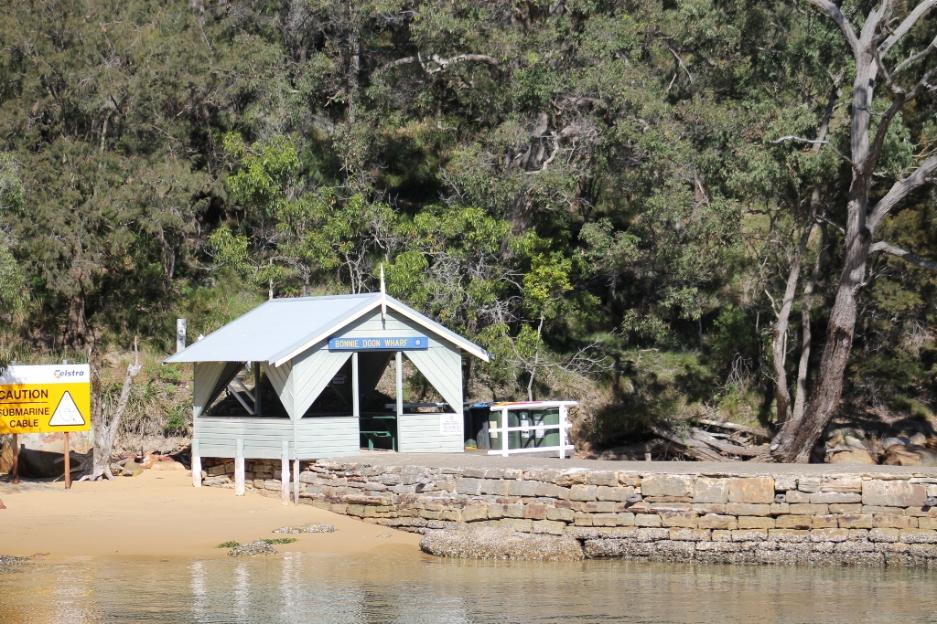
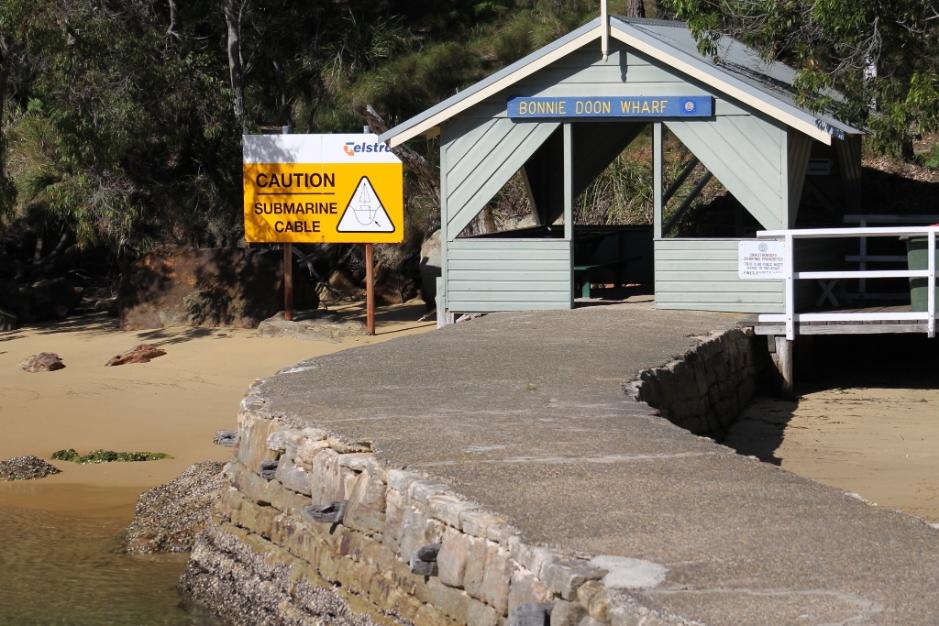
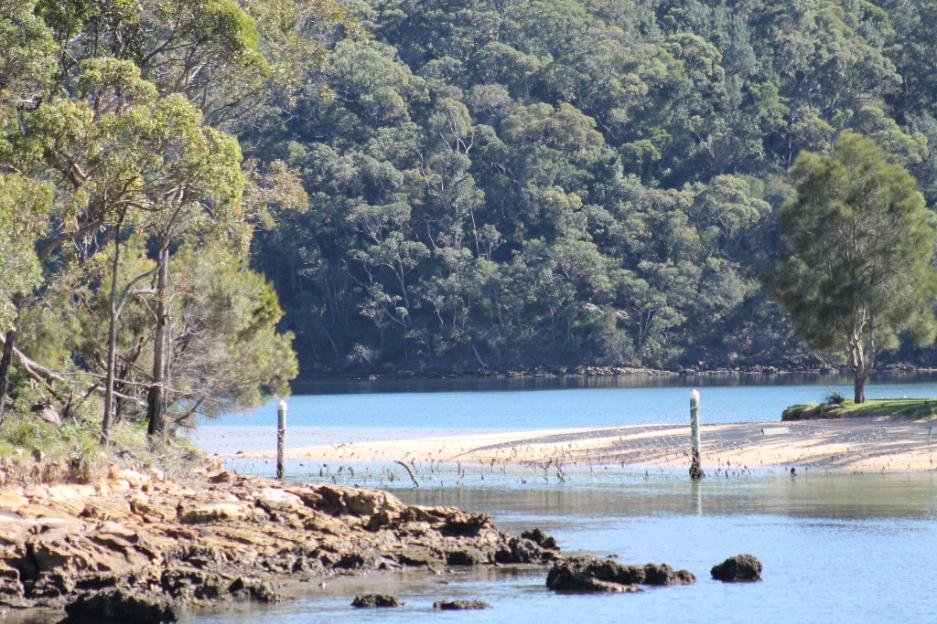
THE BASIN
MAN INTERFERES WITH NATURE TRUST INVITES SUGGESTIONS
Nature unadorned and unaided by her highest animal development sometimes blunders, and humanity sometimes blunders in trying to help her. In most of her domains Nature discords symmetry and arranges her beauties in orderly confusion, but when man tries to help her to readjust her boundaries, he unfortunately generally thinks and plans in straight lines — harsh utilitarian contours— that rob her of her pristine loveliness. At the basin in the Pittwater Arm of Broken Bay Nature has given humanity a rich inheritance, and, because one of her elements has been breaking the bounds of others, mankind, as represented by the Kuring-gai Park Trust, has come to her assistance, with success in some respects, and with artistic failure in others. The Basin has been misbehaving itself. Ordinarily it is a delectable lake-like expanse of deep marine water, nestled in a huge amphitheatre clothed with eucalypts and other rich forest growths, situated near the mouth of the Pittwater Arm of Broken Bay, on the Kuring-gai Chase. During many years, however, it has been quietly eating into part of the peninsula that nearly encloses it, and the trust has felt called upon to protest. In doing this the Trust has done well, but its aid has been chiefly solid and mathematical, rather than artistic. When it builds a retaining wall it forgets that exactly the same rigidity may be achieved by curves and irregularities of upper structure as by lines of block masonry. The artistic conception is dwarfed by the useful and possibly the expedient.
Much splendid work has been done, and is still being done, under the direction of the trust in and outside the Basin. The channel entrance, which was threatened with shoaling by the sand from a little outer bay, is now protected, and. probably something more will be done to prevent the Basin from cutting further into the peninsula from inside. Across the outer Inlet a retaining wall of sandstone blocks has been constructed, but provision has not been made for the scour from the hills to get rapidly away, and the consequence is that the reclaimed land is often a knee-deep bog. A channel to let the water away is needed, and the lines of the wall itself should be in keeping with nature's beautiful outlines round the Basin. Only in basalt country does one see squares and oblongs, and' the country round this attractive spot is not basalt, but irregular sandstone, with intrusions of other rocks. To relieve the uncouth symmetry of the retaining wall, natural rock buttresses might have been substituted for the top ungraceful oblongs.
ALRIGHT IN TIME.
Mr. Harrison, secretary of the trust, maintains that the wall has improved one of the camping grounds just outside the channel entrance, and that in time the land at present boggy just inside the wall will drain and give more well-grassed camping space. He says that most of the yachtsmen and motor-boat owners who frequently visit the Basin are pleased with a newly-erected wharf and shelter-shed near the little southern outer beach, even if it has spoiled a fisherman's hauling ground. The main outer beach is not being touched.
RUSTICITY SACRIFICED.
The red-roofed shelter is certainly a pleasant color relief to the rest of the structures, and on the whole the artistic sense of visitors is not outraged by that improvement. Inside the basin a wharf has been completed. It, too, is needed, but it is at present devoid of grace. It is not perhaps too late for the suggestion of some regular visitors to be acted, upon, that it be given a rustic finish. Utility may be combined with grace by the utilisation of natural timber shapes, instead of sawn rectangular timbers. Even sawn triangles look better than quadrilaterals in certain places.
SWIMMERS' WANTS.
Another Improvement meditated is an enclosure for swimmers in the basin near the new wharf. This is necessary; but again, the wall proposed to be erected is to be topped by quadrilaterals, and be an evidence of the acquaintance of mankind with Euclid's squares, instead of Nature’s harmonious irregularities. It is not too late for the trust to instruct its workmen to construct the wall so that its top, at least, may be rocks from the hillside, and not a footworn horizontal pathway. It is not necessary for anyone to walk along it, but if of squared masonry It will invite wandering feet.
DIFFERING OPINIONS.
At the seaward end of the outer beach, where parties find safe swimming water, the trustees are proposing to place another wharf of stone, and to run from it a netting to prevent sharks entering a bathing enclosure. Opinions amongst yachters and motor-boaters vary respecting this. Some condemn the proposals entirely; preferring the natural surroundings. Others say the idea is good, as they have always felt they would like to swim in a bit deeper water, but they feared the huge sea-sharks that swim around Barranjoey and West Head and chase whiting and red-bream up into the Basin. The trustees are not obstinately wedded to any proposal. Inquiry shows that they welcome ideas, especially artistic ones allied with practicability, but they do not have them given to them often. They find critics wait till something is done, and then fall upon it with scorn. Any yachtsman, therefore, who has a thorough appreciation of the necessities of the Basin and puts his ideas into writing, will receive attention. For instance, another improvement meditated is the planting of trees about tho 20 acres surrounding Peggy's house. The trees on the camping area are not as beautiful as they might be. One proposal before the trustees was to plant an avenue of pines along tho outer edge of the camping ground — the straight line business again— and another to plant here and there a few silverbark tea trees, Port Jackson fig trees, and flame trees. The latter proposal seems to find the greater favor amongst those who visit the Basin oftenest.
WATER FOR CAMPERS.
One thing needed greatly has apparently not yet been authorised by the trustees, and that is a cement water well, . as Irregular in shape as may be possible, on' the line of the little creek at the northern end of the peninsula. Once the old users of the place had a cask there to hold the water, but it has fallen to pieces, and in dry weather campers have to pull a long way across the Basin to a spring up the hill-side. No doubt the trustees will see to this. They are anxious to please and anxious to adorn, not to disfigure nature. By the way, nobody wants to shift Peggy, who has a life tenancy of part of the peninsula at 1s a year rental, and who is one of the picturesque identities of the place. She is Mrs. Mary Ann Morris, and she has lived there for 47 years. THE BASIN (1915, May 30). The Sun (Sydney, NSW : 1910 - 1954), p. 23. Retrieved from http://nla.gov.au/nla.news-article229334724
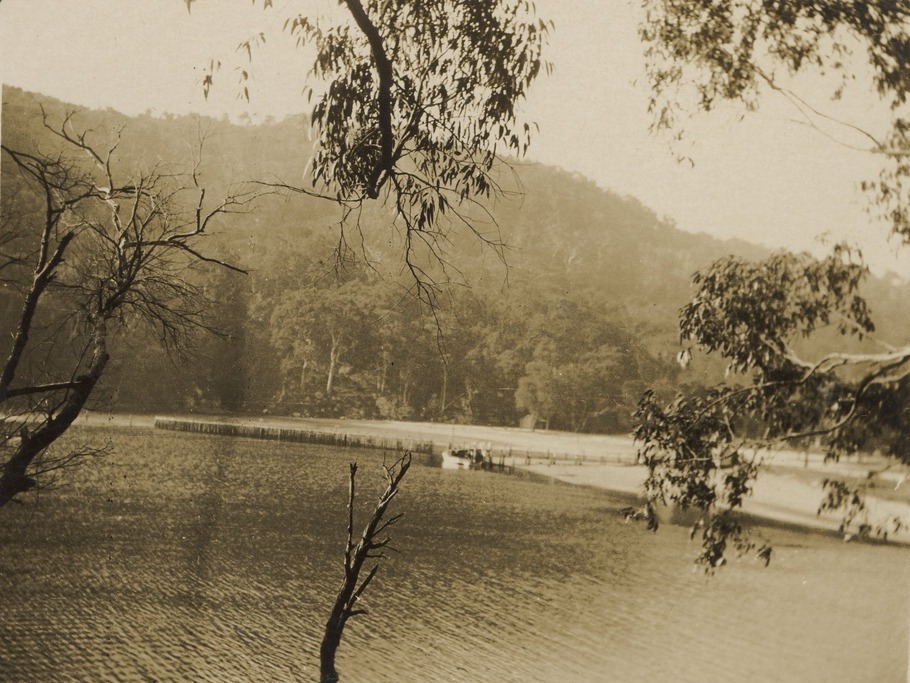
"The Basin Swimming pool Pittwater" - "Looking across water towards bushland rising in background, fence visible across surface of water." Title continues: "The fence is to keep the sharks out." [ca. 1926-ca. 1928].by Gladys E. Moss, 1900-1950, photographer. "The Basin; Pittwater" - Title inscribed on album page beneath image.- Courtesy State Library of Victoria, Image No. :701711210
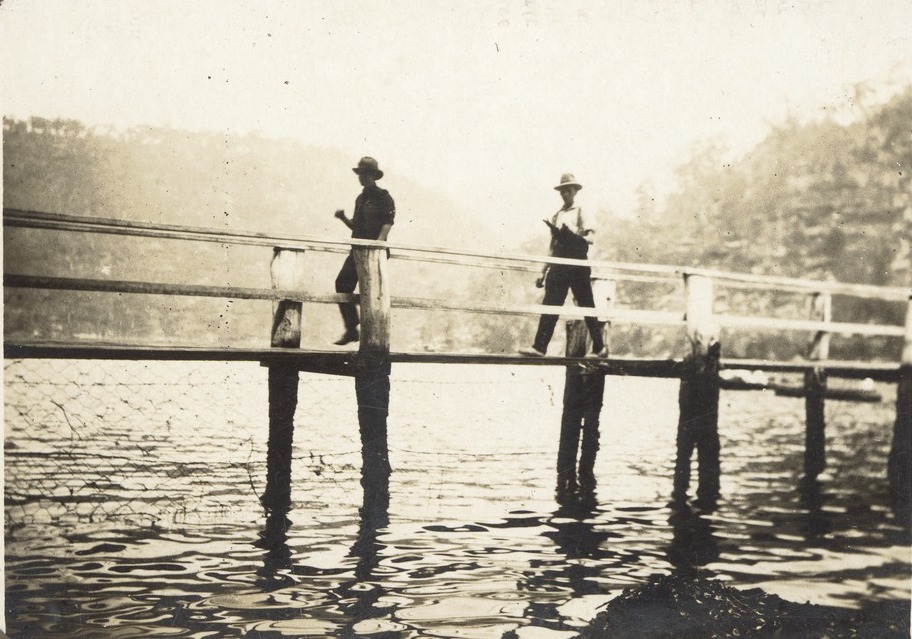
"Looking along water towards two men walking across wooden bridge". Inscribed on album page next to image: "The netting under the footbridge keeps the sharks from the bathing-pool on this side. The rock in the foreground is jagged with oysters." [ca. 1926-ca. 1928].by Gladys E. Moss, 1900-1950, photographer. "The Basin; Pittwater" - Title inscribed on album page beneath image. Courtesy - also described as 'an inlet of Cowan creek' for this Image No.: 701711211, Courtesy State Library of Victoria.
In 1921 the first Howard Castle-Smith subdivision of the acreage at Coaster's Retreat was offered for sale:
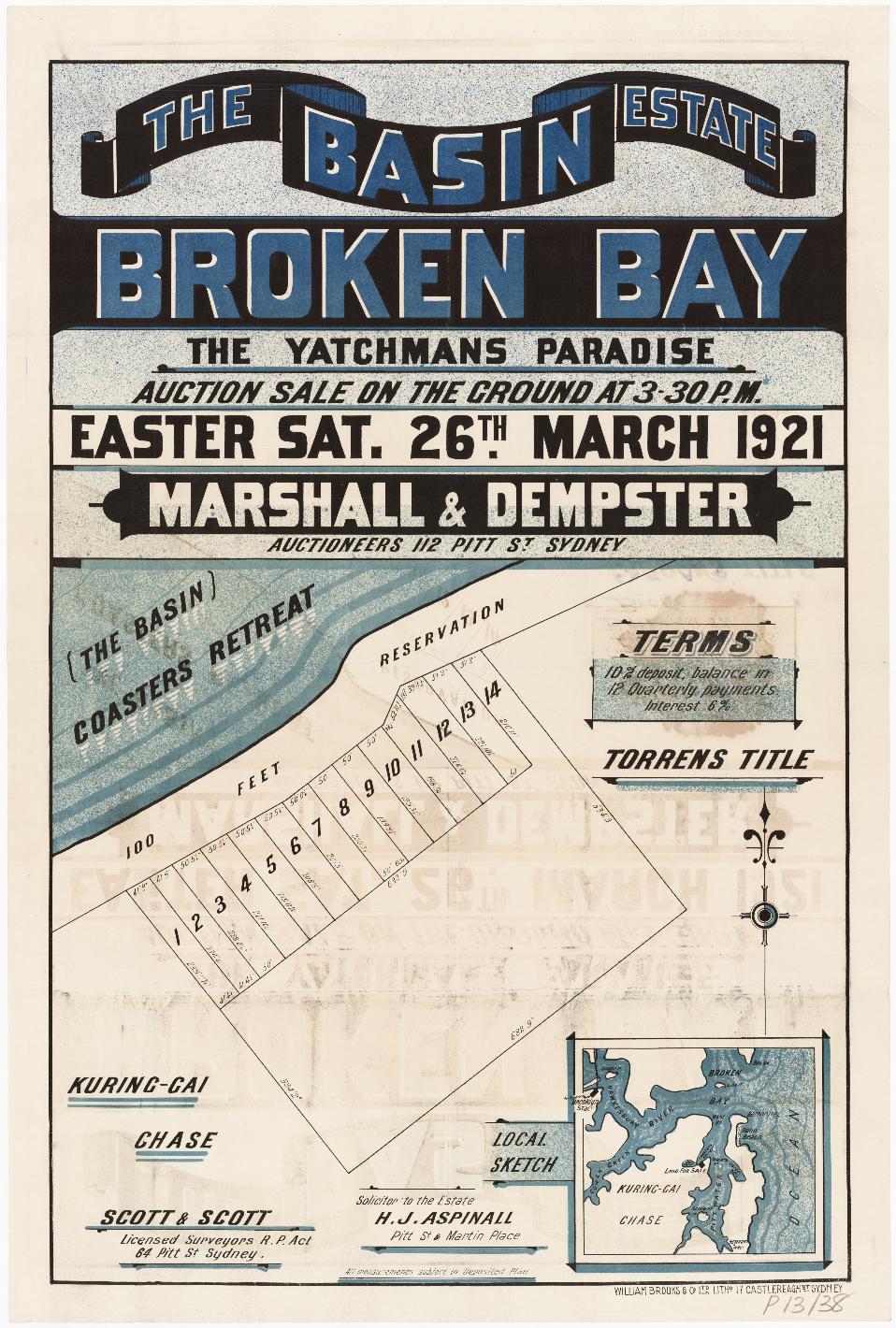
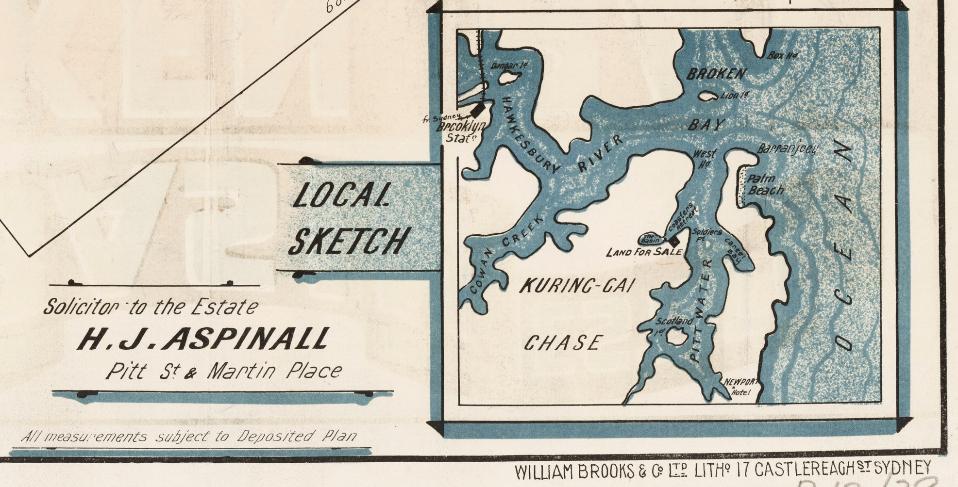
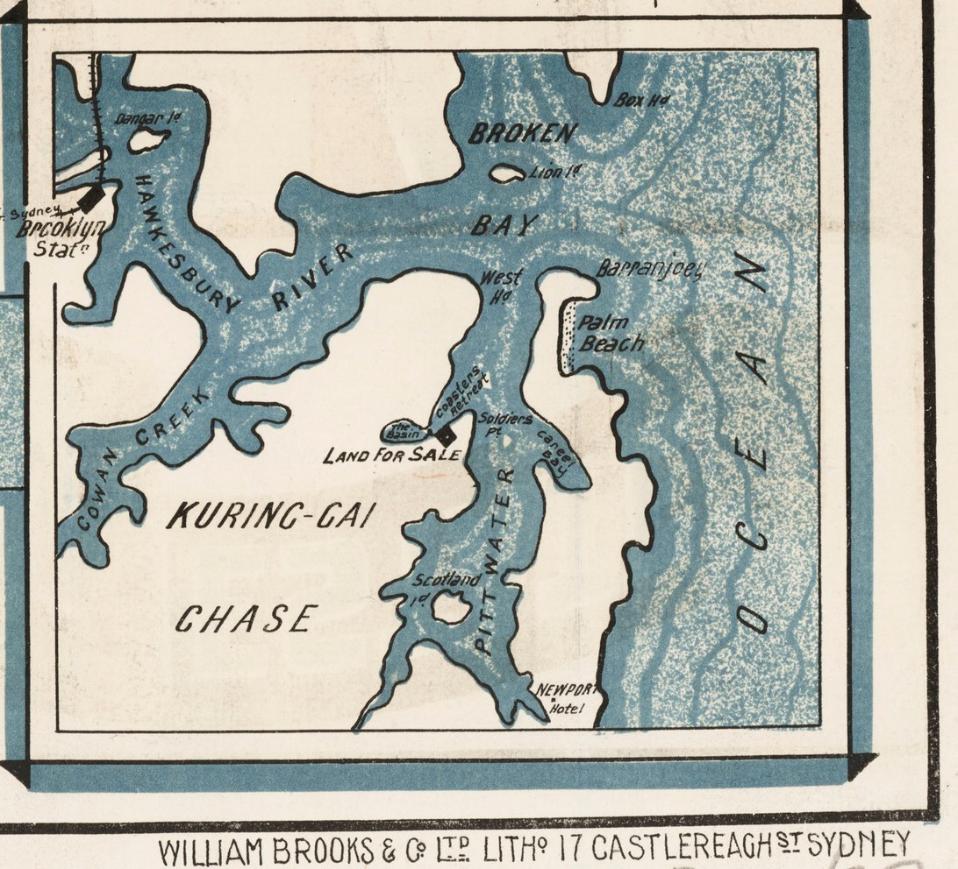
BROKEN BAY. BROKEN BAY.
THE BASIN. THE BASIN.
THE YACHTMAN'S PARADISE.
THE BASIN ESTATE.
SURROUNDED BY KURING-GAI CHASE, AND THE
ONLY LAND AVAILABLE FOR SUBDIVISION.
FOURTEEN CHOICE BUILDING BLOCKS.
Fronting WATER-FRONTAGE RESERVE in this
much-sought after position.
TORRENS TITLE.
TERMS; 10 per cent, deposit, balance 12 quarterly
payments at 0 per cent,
Lithos on application.
SPECIAL LAUNCH WILL LEAVE NEWPORT AT
2 P.M., RF.TURNING ABOUT 5 P.M. TICKETS ON
APPLICATION TO AUCTIONEERS.
This Fine Estate, with Northerly aspect, will be
submitted to Public Auction In Lots, on
EASTER SATURDAY, MARCH 26,
On the Ground, at 3.30 p.m.,
by
MARSHALL AND DEMPSTER,
AUCTIONEERS,
112 PITT STREET, OPP. G.P.O.
H. J. ASPINALL,
Solicitor for the Estate. (C6) '
SCOTT and SCOTT, Surveyors to Estate. Advertising (1921, March 23). The Daily Telegraph (Sydney, NSW : 1883 - 1930), p. 21. Retrieved from http://nla.gov.au/nla.news-article239729367
The residue became the holding of Alfred Edward Bennett on March 12 1935, from whom we get the name 'Bennett's wharf' to provide access to these lots and homes. The land sales are listed in Volume-Folio 4683-100 and continue until 1949:
.jpeg?timestamp=1768426785415)
.jpeg?timestamp=1768426864969)
.jpeg?timestamp=1768426915025)
.jpeg?timestamp=1768426948647)
.jpeg?timestamp=1768426979843)
.jpeg?timestamp=1768427011950)
Warringah Shire Council Minutes of Meetings provide:
At the Ordinary Meeting held February 5, 1946:
(34) Kuring-Gai Chase Trust, 30/1946, referring to letter from A. E. Bennett forwarded to the Trust by the Council, regarding unsightly lavatories at The Basin, and suggestion that the 100- ft. reservation on the southern side of The Basin might be transferred to the Council; the Trust's reply being to the effect that Mr. Bennett should know the difficulties regarding building, and that if there are any unsightly buildings on the Trust's land, the necessary steps will be taken when labour and materials are available, and emphatically stating that The Trust would not agree to any transfer of the 100-ft. reservation. Resolved, - That a copy of the Trust's letter be sent to Mr. Bennett. (Crs. Raffo Walehum)
The Meeting held November 11 1947 records:
The Shire Clerk reported verbally that three Court actions against the Council had been listed for hearing, viz - (2) W. Parley - Land & Valuation Court 15/12/17 - Appeal Buildings against Council's refusal to approve of a building application: (3) A. E. Bennett (land & Valuation Court 15/12/17) - Appeal against Council's failure to approve of a subdivision at SubDd. A. Coasters' Retreat, Pittwater: Resolved, - That the Kuring-gai Chase Trust be asked to support the Council before the Court in this case. (Crs. Harris, Dunbar)
The Meeting held October 27 1958 records:
Cumberland County Council: forwarding for Completion under Seal, Declaration of Trust in respect of Transfer of Lot 3, DP 23104, Lovett Bay. Resolved; that this Document be Completed.
Coasters’ Retreat Progress Association 16/10/58 regarding pathway between Bennett’s wharf and Bonnie Doon wharf, and council’s reply that the reserve through which is formed is under the control of the Kuring-Gai Chase Trust, it cannot expend its funds upon maintenance thereof; requesting that the council give specific details of the various rating assessments issued to owners in that area, and inquiring if the fact that the various lots front an unmade pathway, out of the control of council, is taken into consideration when rates are assessed. Response; That Kuring-Gai Chase Trust be informed that the Council regards this work as its (The Chases’) responsibility, and that the Council offer to carry out the works on the Trusts’ behalf on payment of the amount due; and the Engineer prepare an estimate top be forwarded with the letter; that the Council advise the Coasters’ Retreat Progress Association of the action taken by the Council and that all facts are taken into consideration when the Valuer General assess rateable values. (Crs. Fisher/Reynolds.)
Coasters’ Retreat Progress Association – 16/10/58- asking that a Building Inspector make an early inspection of structures in the area from Soldiers’ Point on the western shores of Pittwater to Bonnie Doon wharf, residents being concerned about the erection of structures which obviously have not been subject of Council’s consideration. Received; Chief Health and Building Inspector stated this inspection had already been carried out.
At the Meeting held on October 3, 1961:
(AS) Ampol Petroleum Ltd., 28/9/61 ; re proposed fuel installation for Basin Mackerel Beach Ferry ; advising further discussions with the Ferrymaster and committee members of the Broken Bay Game Fishing Club have resulted in the latter party's unwillingness to enter: into a signed agreement regarding this installation but that Mr. Buhl is agreeable to having responsibility for both petrol and distillate and can arrange with the Game Fishing Club to draw supplies for their members. Adding-that after conferring with the Shire President: the proposed agreement (amended) is forwarded, for Council' .s approval. Note Council resolved 0/M. 18.9.61 F/0.26 ',That the Engineer's report be received and adopted and that (a) additions to jetty be approved, subject to approval of structural details by. Shire Engineer and work being effected without cost -to Council; (b) installation of petrol pump be approved; (c) erection of timber shed be refused as undesirable for the locality; (d) Agreement be entered into by applicants with. Council. Resolved; That this matter be referred to the Finance Committee and that a report be brought forward from either the Shire Engineer or the Shire Clerk in relation to the Agreement ' and the plans. (Crs. Wade/Bertram.)„
Adjourned Ordinary Meeting, 9/3/1962:
BUSINESS WITHOUT NOTICE : INTRODUCED BY THE PRESIDENT. BASIN & MACKERAI BEACH FERRY SERVICE. The President announced that he had received a letter dated 7th March, 1962 from C.P. and D.W. Buhl, The Basin & Mackerel Beach Ferry Service, requesting that Council consider the granting of a franchise to operate from the Public Wharf at Pittwater Park, Palm Beach, such request having arisen out of the persistent habit of another ferry service outside the area picking up passengers from the public wharf and conveying them to the Basin picnic grounds at weekends and on public holidays. 37.Resolved, _That this matter be referred to Council's solicitors for report re the granting of a licence.
At the Meeting held on February 19, 1973:
BASIN-MACKERAL BEACH FERRY SERVICE. Letter, 5.2.1973, W.J. Hensley, stating the owner of the Ferry Service, Mr. McKay of Coaster's Retreat, advises he cannot continue the winter service as it is quite unprofitable. Before discussion on this item, the President announced that a phone call had been received from Dr. Hensley requesting that the Council agree to meeting the Progress Associations, and Mr. McKay, Ferry Operator, on Tuesday, 27.2.1973 at 7.30 p.m. 54. Resolved _That a meeting as arranged, be held on the 27.2.1973 in the Shire Hall, commencing at 7.30 p.m. comprising from the Council all interested Co;ncillors. (Crs. Dawson/Creagh)

Don Mackay's ferry SWANHILDA, ex ENA, in Coasters Retreat, Pittwater. Unique IDA-00079884 Series: Graeme Andrews Working Harbour Photograph Collection, Date Between 1st January 1970 and 31st December 1970, courtesy City of Sydney Council historic archives

Photo: RALUANA (1968). MV. McKay ferry, Pittwater. Unique IDA-00081097 Series; Graeme Andrews Working Harbour Photograph Collection, Date Between 1st January 1973 and 31st December 1973, courtesy City of Sydney Council historic archives
The oldest house, stated by residents who have lived ere for generations and named 'Negunya', was built by the Norton-Russell family in 1922. The word 'gunya' is an alternative spelling of 'gunyah', defined as; 1. an aboriginal hut. 2 Australia : a small hut or crude shelter built for use in the bush the camp consisted of dome-shaped bough gunyahs, roofed with sacks. Whether this is where this name was derived from is not confirmed.
The second oldest house was built by the Alldritt Family in 1926, following the 1921 Subdivision of the original land grant. Aldritt descendants are still living and working on Pittwater.
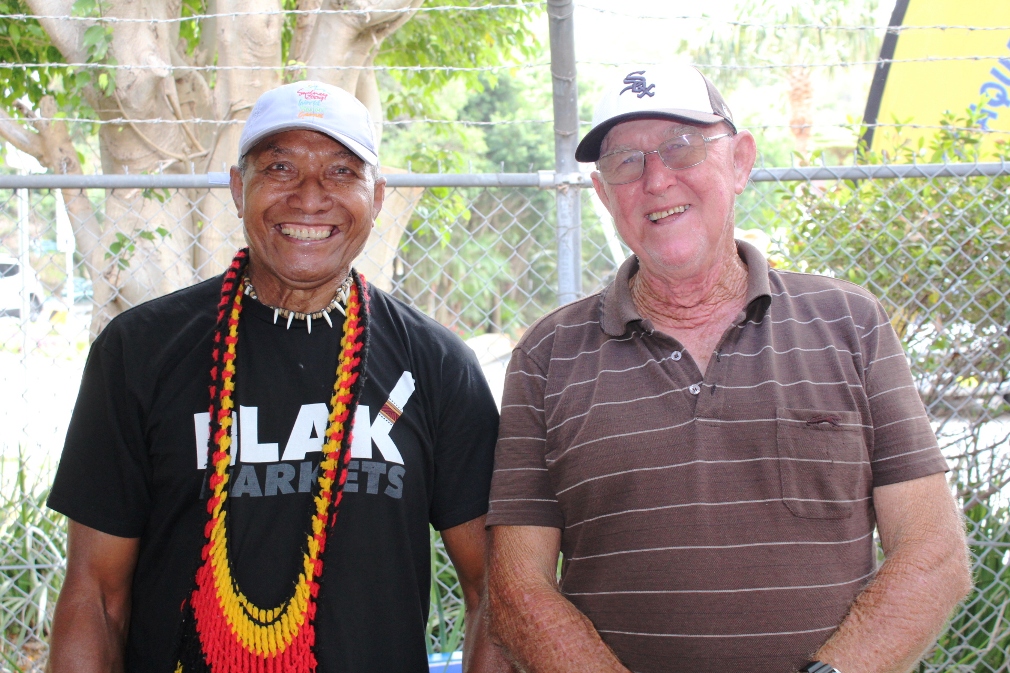
The Norton-Russell family were descendants of George Norton Russell, (also spelled Morton in some records) and his son George Albert Norton-Russell:
MARRIED.
By the Rev. John M'Garvie, D D., by special license on Monday last, George Morton Russell, Esq., of Her Majesty's Customs, to Miss Eliza Hart, of Hunter-street, Sydney. Family Notices (1841, November 3). The Sydney Herald (NSW : 1831 - 1842), p. 3. Retrieved from http://nla.gov.au/nla.news-article12872047
DEATH.
On the 28th instant, at his residence, Cliftonville Cottage, Kingston, Newtown, George Norton Russell, Esq., late of H. M. Customs, aged 71 years.
FUNERAL.—The Friends of the late GEORGE NORTON RUSSELL, Esq., are respectfully invited to attend his Funeral ; to move from his residence, Cliftonville Cottage, Kingston, Newtown, at 8 o'clock, TUESDAY MORNING. R. STEWART, undertaker, Pitt-street. Family Notices (1865, October 30). The Sydney Morning Herald (NSW : 1842 - 1954), p. 8. Retrieved from http://nla.gov.au/nla.news-article31125821
RUSSELL—DUNNICLIFF—November 15, by the Rev. William Bradley, George Albert Norton Russell, to Henrietta Dunnicliff. Family Notices (1875, November 27). The Sydney Morning Herald (NSW : 1842 - 1954), p. 6. Retrieved from http://nla.gov.au/nla.news-article13366819
George Albert Norton Russell and Henrietta had five children, Beatrice Mary (born 1876) Alice Marion (born 1877), George Norton (born 1878) and twins Aubrey Albert and Percy Norton (born 1882).
Percy would marry, in 1925, Nancy Evelyn Goulding (born December 22nd 1903). Nancy was the daughter of William James "Bill" Goulding and Amy Louisa (nee Turner). Nancy's mother Amy was the daughter of Albert Henry Turner and Nancy Nelson Wilson, and so a granddaughter of Thomas Wilson and Priscilla Sarah Conduit.
Apart from appearing in the papers during August 1908 due to a family dispute, 'Bill' Goulding was a champion rower and part of the crew that won the 1893 Intercolonial race on the the Parramatta River:
Percy's side of the family had been appearing in Sydney newspapers for different reasons:
Ladies Page.
Gipsy's Notes.
Private Theatricals.
At "Pelham Hall," Woollahra, the residence Mr. G. Norton Russell, a most enjoyable evening was spent on the 25th ultimo by about one hundred guests, who came attired in the prettiest costumes that papas' and husbands' purses, and dressmakers' taste could combine. In the early part of the evening the comedy of "Our Boys" was witnessed. Mr. Cansdell was Sir Geoffrey Champneys; Mr. George Norton Russell, an excellent Talbot ; Dr. Warren, Charles Middlewick; Mr. Victor Cohen, the irascible old butterman ; the latter gentleman and Miss Florence Sandeman (Belinda) had most of the fun for their share, and carried the audience's sympathy from beginning to end. Miss Eleanor Sandeman looked charming, and and was a most engaging Violet Melrose. Miss Valentine undertook the role of Mary Melrose, and Miss Cheesebrough that of Clarissa Champneys. Not a hitch occurred, and for private theatricals that is a consideration especially to be valued. The performance was far above ordinary amateur efforts, and the majority of those present were almost sorry when the theatre was over. Flighty young things, who think a waltz with their favorite he or she the most delightful occupation imaginable, rejoiced, shook the creases out of their airy ballet skirts, bestowed sundry meant to be secret pats to fringes, cast sidelong glances the mirrors, and anon were whirling round to glorious music. The host and hostess knew the wisdom of sending their friends away wishing for more, rather than allow them to be too much, than satisfied, so a neat little reminder was appended on the card of invitation, that "Carriages might be ordered for 1 a.m." Not long after that hour darkness reigned at Pelham Hall. Ladies Page. (1885, April 11). Australian Town and Country Journal (Sydney, NSW : 1870 - 1907), p. 30. Retrieved from http://nla.gov.au/nla.news-article71025990
Among the private gatherings I may mention the pleasant dance given by Mrs. Harvey in her residence at Glebe Point ; that given by Mrs. G. Norton Russell in Pelham Hall, Woollahra, to celebrate the safe return of her husband from England ...Sydney Gossip. (1887, August 13). Australian Town and Country Journal (Sydney, NSW : 1870 - 1907), p. 34. Retrieved from http://nla.gov.au/nla.news-article71088181
YOUNG—RUSSELL.—April 5, 1893, at St. John's Church, Darlinghurst, by the Rev. Arthur W. Pain, B.A., Frederick J. S., younger son of John Young, Kentville, North Annandale, to Beatrice Mary, elder daughter of G. Norton Russell, Pelham Hall, Woollahra. Family Notices (1893, April 10). The Sydney Morning Herald (NSW : 1842 - 1954), p. 1. Retrieved from http://nla.gov.au/nla.news-article13904092
Woollahra was incorporated in 1860, and has a population of about 10,000. Its area is about 2222 acres, and the value of ratable property is £2,589,000. There are branches of the English, Scottish, and Australian, and Aus-tralian Joint Stock Banks, four Anglican, two Roman Catholic, two Congregational, one Presbyterian, and one Wesleyan chur-ches. There are three public schools within the borough, a brewery, an iron foundry, and several works of a less important character. Woollahra is admirab-ly served by the cable tram, which passes through its northern portion from the foot of King-street to the present terminus at Ocean-street. But the work of constructing the electric tram to Rose Bay, and which, of course, will connect with the Ocean-street line, is well under weigh, and should be completed shortly. Alderman T. Magney presides over the deliberations of the municipal council, and he has associated with him in municipal management Aldermen D. Davis, F. H. Quaife, M.D., Richard Teece, E. Mac-Donald, W. F. Latimer, George Dyson, W. Thomas, J. Thompson, junior, E. W. Knox, George Norton Russell, and the Hon. W. J. Trickett. Mr. Charles Vivian is council clerk, and he is assisted by Messrs. E. Kelly and H. Quin-an. The parliamentary representative is Mr. John Garland, a supporter of the present Administration, who defeated Sir William P. Manning, the Bartonian candidate, at the general election. ....
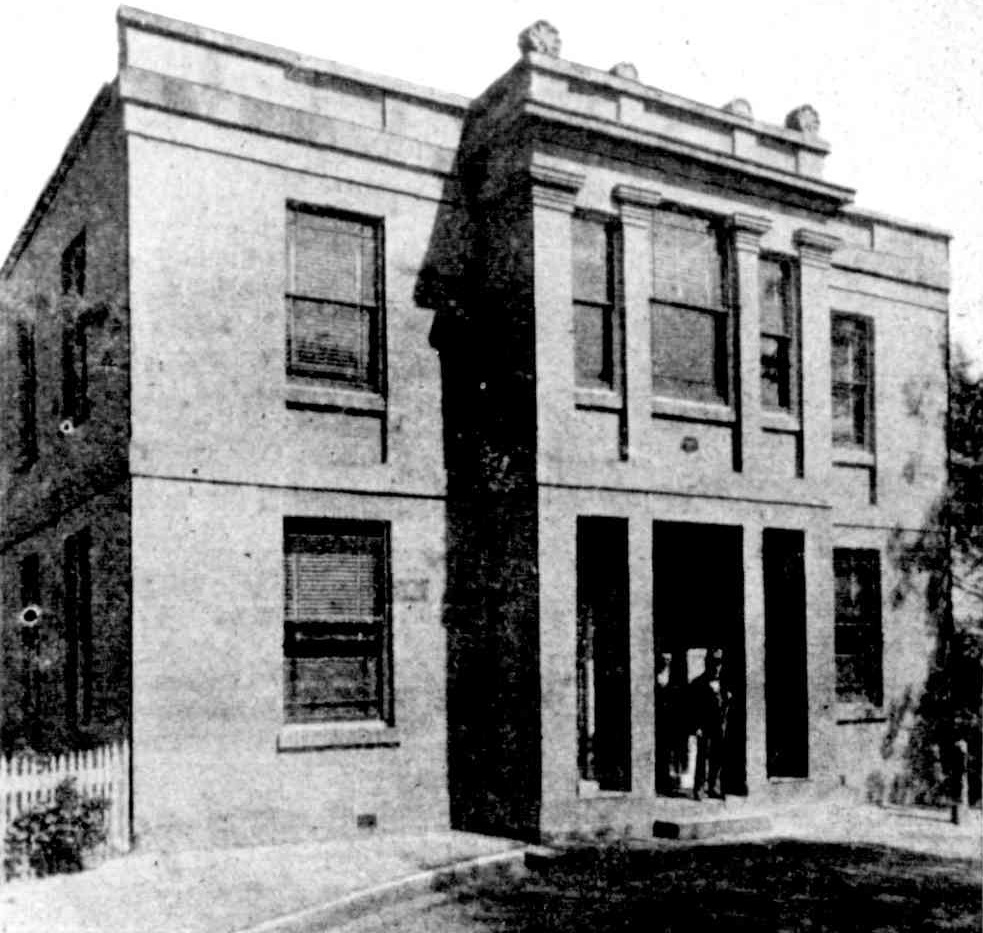
Woollahra Council Chambers.
THE EASTERN SUBURBS OF SYDNEY. (1898, October 1). Australian Town and Country Journal (Sydney, NSW : 1870 - 1907), p. 31. Retrieved from http://nla.gov.au/nla.news-article71318565 - NB: Pages of old photographs of buildings/businesses in this article
MRS. NORTON-RUSSELL'S DANCE By GERDA.
Mr. and Mrs. Norton-Russell, of Pelham-hall, Woollahra, entertained about 160 guests at Need's rooms, on September 20. The ballroom was decorated with yellow and white muslin, bungalow palms shading the mirror panels, other palms being arranged on the top of the mirrors in bunches. Between the mirrors were white lace curtains, draped with clematis and vines. The large stools that lined the room were covered with yellow. In the smaller part of the L-shaped room was a refreshment table, covered with yellow flowers. The back of the room was entirely filled in with ferns and arum lilies. The arch way between the two rooms was covered with quantities of yellow and white muslin and vines. The green ferns, grasses, and mosses in the conservatory were lightened by Chinese lanterns and little oil lamps. Chinese lanterns and flags decorated the entrance passage. In the supper- room the long table was adorned with pale pink azaleas and grasses intertwined with pink ribbons and crinkled paper. The lamps in all the rooms were covered with pale pink shades.
Some very handsome dresses, including many black ones, were worn. Mrs. Norton-Russell's black satin had an overdress of black and steel-sequined net, with a train of black satin frills; the bodice was of black satin, adorned with sequin trimming and steel fringe; a pearl necklace and ornaments were worn. Miss Norton-Russell wore a soft maize silk, all tucked, a polonaise vandyked over silk frills; the bodice was trimmed with ecru lace and a big yellow flower; she wore a wreath of yellow bebe roses in her hair. Mrs. Bulloch (sister) had a black grenadine, over silk, trimmed with black bebe ribbon; the collarette was relieved with cream guipure, and cream roses were worn on the bodice. Mrs. Fred Young (sister) wore yellow brocade. Mrs. Bowker, mauve brocade, bodice trimmed with black and silver. Mrs. George Fuller, very handsome tucked mauve satin, trimmed with guipure lace. Mrs. Oscar Backhouse, in black, with a bolero of steel. Mrs. Willie Bloomfield looked very well in black, with red roses. Miss Walsh (Tasmania) was also in black with a big chou of pale green satin in her dress, another in her hair. The Misses Richards were much admired, one in pink, with a' green wreath in her hair; the other in white, with a short bolero of black sequins. Miss Lulu Bundle's white satin was very effective, the polonaise and the bodice were outlined with pink bebe roses; the sleeves, made of folds of white tulle, were also edged with roses; two clusters of pink hydrangeas were worn in her hair. Miss Linda Bundle wore white satin, made in Empire style, trimmed with lace frills; pink flowers in her hair. Miss Enid Russell's pretty white frock was covered with white gauze, the bodice trimmed with pink. The Misses Whittingdale Johnson wore black. Miss Friend, buttercup brocade. Miss Gwen Friend, white. Mrs. Augustus Hill, cream silk with cream lace overskirt; the bodice trimmed with lace] and tulle. Miss Augustus Hill, white lace, over white silk, blue leaves on the bodice i and m her hair. Miss Muriel Marks, a I beautifully-embroidered white dress, over! pink; big, black flower in her hair. Miss Morgan-Martin, white, with a wreath of pink bebe roses in her hair. Miss Randal. Carey, white satin and red roses. Miss Mabel Randal Garey, prettily-tucked blue, Mrs. Collins, pink glace silk trimmed with a lot of white. Miss Cordeaux (Mossvale), pink covered with white chiffon. Miss Winifred Docker, buttercup silk. Miss Anice ])ocker, white. Miss Dight, black with red roses. Mrs. Kerr, black. Mrs. Lane Mullins, white. Miss Grace Mac douald, white. Miss Maddrell. black with red roses. Miss Machardy, black. Mrs. Atcheson, black; her sister. Miss Plunkett, white. Miss Reading, pink. Miss Gladys Teeee, white. Miss Venables looked well in white trimmed with the palest pink flowers. There were also present Com mander Corbett, R.N. (H.M.S. Parramatta), the officers of H.M.S. Katoomba, Mr. Kilpatrick, R.N. (under-secretary to Admiral Beaumont). Captain and Mrs. Sandford, Captain and Mrs. Selwyn Smith, Captain Russell Watson, Lieutenant Dufrayer, Mrs. Barlow, Mr. W. J. Trickett, Mr. Cecil Trickett, Mr. Claud Reading, Mr. Frank Reading, the Misses Robertson, Mr. H. Robertson, Mr. H. Y. Russell, Miss Salinond, Miss Palmer, Mr. Lance Addison, Mr. R. C. Teece, Mr. Williamson, Miss Williamson, Dr. Bowkcr, Mr. Fuller, Mr. Oscar Backhouse, Mr. Willie Bloomfield, Mr. Macarthy, M. Boudet, Mr. Hickson, Dr. J. M. Greed, Miss Creed, Sir. and Mrs. Frank Muller, Mr. Brock. Mr. Essex Webb, Mr. Sydney Jones, M.B., Mr. Norman Simpson, Miss ... one Mullins, Miss Gurney, Mr. P. Maddryi, Mr. J. Maddrell, Mr. R. AIa\Wr8y. Mr. A. Gould, Mr. and Mrs. Plopijed Mr. and Mrs. Watson, Mrs. Terry. The Misses Terry, Mr. T. E. Terry, and the Messrs. Harold Percy and Aubrey Norton-Russell. MRS. NORTON-RUSSELL'S DANCE. (1901, September 28). The Australasian (Melbourne, Vic. : 1864 - 1946), p. 44. Retrieved from http://nla.gov.au/nla.news-article139747098
SOCIETY DOINGS IN SYDNEY
By GERDA.
Mrs. Norton Russell gave an at home at Pelham-hall, Woollahra, on February 4, in honour of the coming of age of Mr. Aubrey Norton Russell and Mr. Percy Norton Russell. The grounds were adorned with Chinese lanterns and fairy lights. Some of the guests danced in toe ballroom, but most preferred to remain the grounds, as .the day had been sultry. Mrs. Norton Russell looked well in black and silver. Miss Norton Russell wore primrose glace, trimmed with chiffon. - Mr. Norton Russell assisted in entertaining the guests. The company included Dr. and Madame Rou E'er, Rev. John and Mrs. Walker, Miss Lulu Rundle, Mr. and Mrs. Oscar Backhouse, Mr. and Mrs. Edward Reading, Miss Muriel Marks, Mr. and Mrs. F. J. Humphery. Miss Humphery, Miss Linda Teece, Mr. Roy Teece, Major Russell-Watson, Mr. Wardroper, R.N., Dr. and Mil. Collins, and many others. SOCIETY DOINGS IN SYDNEY. (1903, February 14). The Australasian (Melbourne, Vic. : 1864 - 1946), p. 44. Retrieved from http://nla.gov.au/nla.news-article138680495
An extremely enjoyable dance was given at Pelham Hall, Woollahra, last Friday evening. It was quite a dance for young people, for the invitations had been issued by Mr. Percy Russell and Mr. Aubrey Russell, and the hosts, assisted by Mr. and Mrs. Norton Russell and their daughter Alice, saw that the girls had their programmes well filled. The ballroom, with its pretty walls and coloured lights, looked most attractive, as did also the drawing-room, which was decorated with large bowls of arum lilies. The small conservatory which opens at the side was filled with palms and hanging baskets of maidenhair fern. Mrs. Norton Russell received the guests in a gown of heliotrope trimmed with bands of velvet the bodice being of velvet to match. Miss Russell was in white chiffon taffeta embroidered with narrow ribbon, the double skirt opening over a finely-tucked underskirt The bodice had a deep pelerine berthe of lovely lace mounted on lettuce-green accordion pleated chiffon.
Miss Georgie Neild was looking very charming in sapphire-blue chiffon, the full pleated skirt mounted on oyster glace, and trimmed at the foot with a band of sapphire velvet. The bodice had a deep berthe of rose point lace, and a velvet waistbelt to match. Miss Mary Collins wore white chiffon. Miss Winifred Smythe was in Pompadour giace. Pompadour chiffon was the choice of Miss Gladys Currie-Elles. Miss Kathleen Carlton was in white book muslin, as was also Miss Dora Bauer. White frocks were chosen by the Misses Freida and Hilda Humphery, and by Miss Mein, who added crimson roses. Miss Eunice Mort wore crimson chiffon, the same tone being also chosen by Miss Kettle (New Zealand). Miss Dita Kerr was in pale blue chiffon with white lace. Miss Agnes Purves wore canary chiffon mounted on silk to match. Miss Janet Walker was in pale blue. Others present were the Misses Collins, Mr. Roy King, Mr. and Mrs. Banner, Mr. Alec. Dean, Captain Babb (U.S.S. Baltimore), Mr. Wallace McCutcheon (United States), Mr. Alison Walker, Miss Lily Keele, Mr. Jack Raymond. Mr. Roy Kerr. Mr. Leonard Giblin, and Mr. Melbourne Smythe. The verandah was cosily enclosed, and here light refreshments were served. Supper was arranged in the dining room, the long table being decorated with vases of flowers. Social Gossip (1906, August 1). The Sydney Mail and New South Wales Advertiser (NSW : 1871 - 1912), p. 303. Retrieved from http://nla.gov.au/nla.news-article163683181
Henrietta passes away:
NORTON RUSSELL.---August 19, at Pelham Hall, Woollahra, Henrietta Norton Russell. Family Notices (1908, August 26). The Sydney Mail and New South Wales Advertiser (NSW : 1871 - 1912), p. 585. Retrieved from http://nla.gov.au/nla.news-article165398027
RUSSELL.—The Friends of the late HENRIETTA, WIFE of GEORGE NORTON RUSSELL, will leave Pelham Hall, Forth-street, Woollahra, THIS FRIDAY, at 1 p.m., for Church of England Cemetery, Rookwood, by 2.22 p.m. train from Mortuary Station. Mrs. P. KIRBY and SON, Limited, Undertakers. Tel., 875. Family Notices (1908, August 21). The Sydney Morning Herald (NSW : 1842 - 1954), p. 16. Retrieved from http://nla.gov.au/nla.news-article15003103
the estate of the late Mrs. Henrietta Russell, of Woollahra, at £47,190 ; INTESTATE ESTATES. Letters of administration have been granted in respect of the estate of the late Mrs. Henrietta Russell, of Woollahra, who died intestate on August 19 last, to Mr. George Albert Norton Russell; - March 1909
Soon afterwards:
DEATH OF MR. G. NORTON RUSSELL
Mr. G. Norton Russell, a well-known figure in Sydney, died yesterday afternoon at his residence, Pelham Hall, Woollahra. The deceased, who was a native of Sydney, was in his 70th year. His father was superintendent of Customs, coming out to Australia with Sir John Franklin's suite. Mr. Norton Russell, after reaching manhood, began life as a contractor. He was associated with the late Mr. John Young as one of his active superintendents in important works, including the first part of St Mary's Cathedral, the Garden Palace, and the General Post Office. For many years Mr. Norton Russell was an alderman at Woollahra and acted as returning officer at several Parliamentary elections. He was also a leading church worker, and helped charitable movements to some purpose. At the inauguration of the Dental Board Mr. Russell was nominated as the first lay member, a position he held for many years. In conjunction with the late Mrs. Carl Fischer he was honorary secretary to the first orchestral concerts in Sydney. - Sydney Morning Herald (NSW : 1842 - 1954), Wednesday 15 May 1912, page 18
NORTON RUSSELL. — May 14, at his late residence, "Pelham Hall." Woollahra, George Albert Norton Russell, eldest son of the late George Norton Russell, H.M.S. Customs, in his 70th year.
FUNERALS.
NORTON RUSSELL. — The Funeral of the late GEORGE NORTON RUSSELL will leave his late residence, "Pelham Hall," Forth street, Woollahra, . at 12.30 TO-MORROW, WEDNESDAY, for Rookwood Cemetery, Church of England portion. Train leaves Mortuary Station at 1.55 p.m. Family Notices (1912, May 14). The Sun (Sydney, NSW : 1910 - 1954), p. 7 (FINAL EXTRA). Retrieved from http://nla.gov.au/nla.news-article228865321
DEATH OF MR. G. NORTON RUSSELL.
Mr. G Norton Russell, one of.tho best known men in the city and eastern suburbs (particularly Wollahra, where he has resided for the past 35 years, died at his residence, "Pelham Hall." Forth-street, yesterday afternoon:, He had been in delicate health for the past four years and some two months ago, accompanied by his nurse, went to Hobart in the hope of recuperating. He remained there for a fortnight or three weeks, after which he returned to Sydney. On the return journey, Mr. Russell became dangerously ill.
The late Mr.' Russell was born in Sydney in August, 1843, and was, therefore, in his 69th year. His father (Superintendent of Customs), who came out to Australia in the suite of Sir John Franklin, gave his son what would, be considered a liberal education in those days, and, upon the completion of his scholastic studies, the deceased entered into a course of contracting. Mr Russell followed this avocation for a considerable portion of his career. He was associated with the late Mr. John Young as one of the active superintendents in important works carried on by Mr. Young, notably, the first part of St. Mary's Cathedral and the Garden palace, and the General Post-office.
Mr. Russell held the commission of the peace, was alderman of Woollahra for many years continuously, an active member of the, Woollahra Superior Public School Board, returning-officer for Woollahra (and formerly for Waverley), and he took an active interest in All Saints Church of England, Ocean-street, Woollahra. His ready services were freely availed of in charitable and philanthropic movements.
At the inauguration of the Dental Board, Mr. Russell was nominated the first lay member, a position which he held for many years. In conjunction, with the late Mrs W. Carl. Fischer he was honorary secretary to the first orchestral concerts which were given of an afternoon at the Sydney Town-hall in 1890.
The funeral will take place at Rookwood-this afternoon. DEATH OF MR. G. NORTON RUSSELL. (1912, May 15). The Daily Telegraph (Sydney, NSW : 1883 - 1930), p. 8. Retrieved from http://nla.gov.au/nla.news-article238747888
LATE MR. G. NORTON RUSSELL.
The remains of the late Mr. G. Norton Russell, whose death took place at his residence, "Pelham-hall." Forth-street, Woollahra, on Tuesday, were laid to rest in the family vault at Rookwood yesterday, A short service was conducted at the house by Rev. H. Wallace Mart, who also had charge of the service at the graveside.
The chief mourners were:— Messrs. Horace N. Russell, Aubrey Albert Russell, and Percy Norton Russell (sons), Mr. Fredk. J. S. Young (son-in-law), Dr. Kerr (brother-in-law), and Mr. Russell Mitchell (nephew).
Others present included: — Dr. J. Collins, Messrs. W. F. Latimer, M.L.A., T. W. Keele (Harbor Trust Commissioner), A. Brooks, E. Hart F. Pattrick,' Edward Reading, Naughton, H F. Maxwell, Jack Terry, Frank D. Muller, Milford, Walter E. Gates (Northern Insurance Company), R. Wilkinson, W. H.. Shenstono, W. Drake, Frank Peach, J. Jones, C. Shard (Comptoir National d'Escompte de Paris), F. J. Plomley, Fredk. W. Walker, J. Pain, Victor Cohen, W. M. Paul, G. C. Phillips, S. F. Jackson, and F. W. Stoddart. LATE MR. G. NORTON RUSSELL. (1912, May 16). The Daily Telegraph (Sydney, NSW : 1883 - 1930), p. 14. Retrieved from http://nla.gov.au/nla.news-article238758502
HILL—NORTON RUSSELL.—Tuesday, April 30 1912, at All Souls' Church, St. Margaret's-on-Thames, Middlesex, England, by the Rev. A. Peckham, Vicar, assisted by the Rev. F. D. Bulloch, M.A., and C. E. De Coppenger, Daniel, the eldest son of Daniel Hill, F.C.A., and Mrs. Hill, of Beverley, The Avenue, St. Margaret's-on-Thames, to Alice Marion, daughter of the late G. Norton Russell, of Pelham Hall, Woollahra. Family Notices (1912, July 1). The Sydney Morning Herald (NSW : 1842 - 1954), p. 8. Retrieved from http://nla.gov.au/nla.news-article15328348
Frederick J S Young, husband of Beatrice Mary, had a property at Church Point a little further along from the 'Bay View' Roche family's lands.
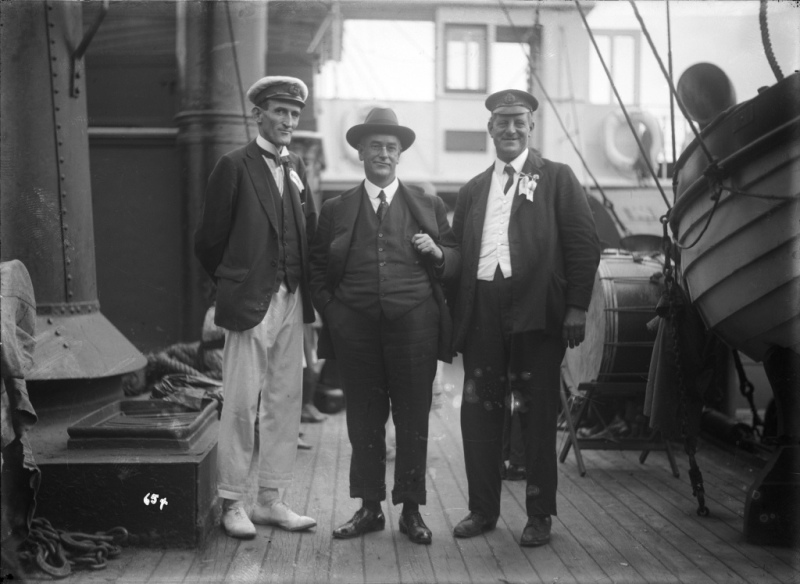
Above: Mr John Roche (left), Mr John Williams, Vice Commodore, Mr F. J. S. Young (right) on board NAMOI, Pittwater Regatta, 1921. Object 000121 66 courtesy ANMM. Below: Sam Hood image of Bayview's Pittwater Aquatic Club contributing to the regatta, with John Roche on Bayview Wharf track, circa 1925. Digital Order No. a409025, courtesy State Library of NSW.
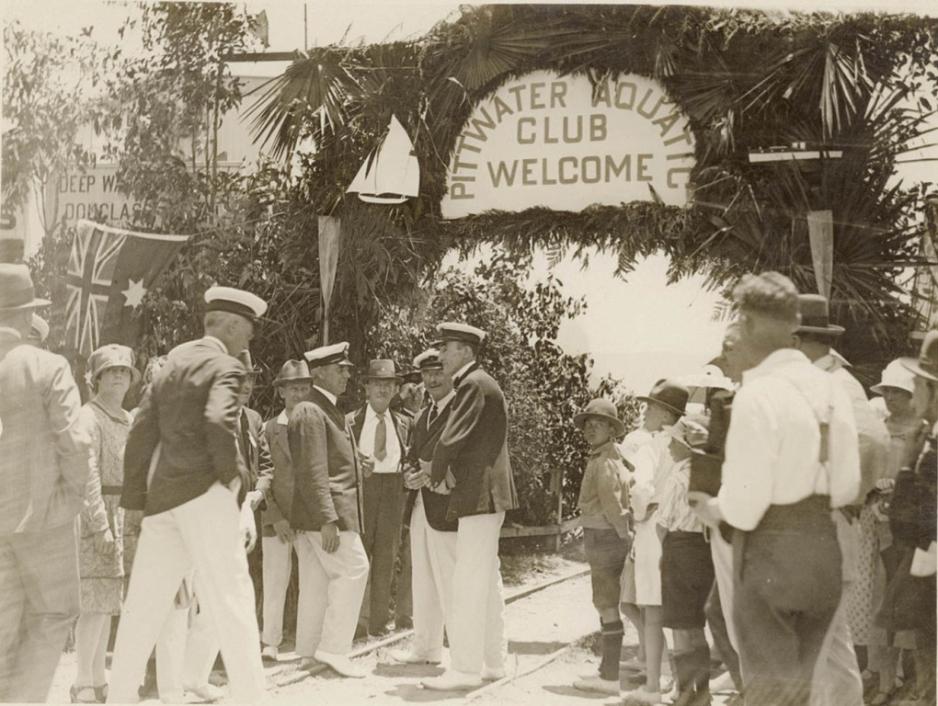
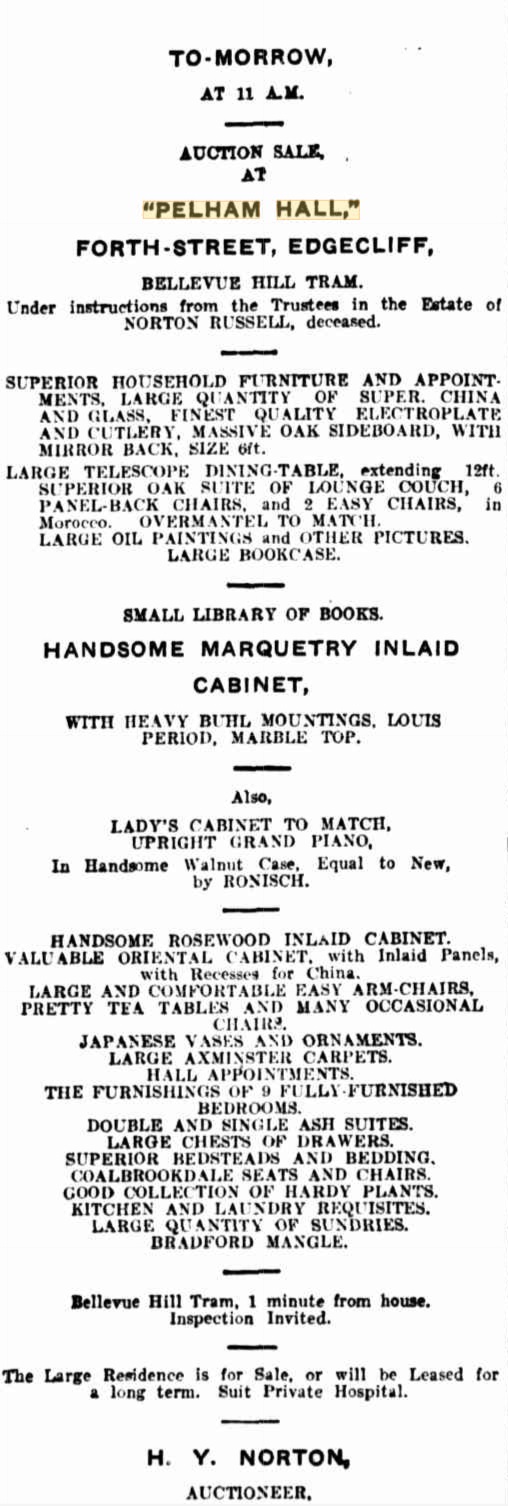
LAUNCH WRECK
SYDNEY, Wednesday.
In the District Court yesterday, Henry James Agar, of Newport, trading as 'Agar Bros.,' claimed £130 damages from Percy Norton Russell, of 14 O'Connell-street, Sydney, for alleged negligence. The case for the plaintiff was that he hired a motor launch to the defendant for the purpose of carrying goods from the wharf at Church Point, Plttwater, to a wharf at The Basin, Pittwater. The launch was wrecked, and he suffered loss and damage and the use of the vessel. His Honor gave a verdict for the defendant. LAUNCH WRECK (1922, December 20). The Newcastle Sun (NSW : 1918 - 1954), p. 5. Retrieved from http://nla.gov.au/nla.news-article163196540
MARINE MOTORING
HANDICAPS FOR PITTWATER
Following handicaps have been declared for the motor boat events to be deckled at the Pittwater Regatta on December 30:—" Motor Boat Handicap (local boats only), to start at 11.46 a.m.— Prices, first £1, second case of wine (donated by Lindemans, Ltd.), third case of benzine: Distance six miles: D. A. S. Fraser's Heather, 26min.: P. Brand's Jeanette. 26; A. B. Jones's Nola, 21.46; P. Norton Russell's La Monotte, 21.23; W. J. Oliver's Dawn, 20.23; J. F. Itoblnson's Kiawa, 16; T. S. Douglas's Alpha. 16; W. R. Alexander's Trebor. 11; W. J. Douglas's Collaroy, 11; W. J. Goddnrd's W.G., 11; L. T. Davis's Princess Pat, 8.21; S. Jones's Parsee, 6; F. Engleberi's Half Moon 4; Gordon Snow's Bronzewing, scratch. Auxiliary Power-boats Handicap, Allcomers, to start at 2.30 p.m. — Prizes, first £1/4/ ; second £2/2/. Distance, six miles: N. L. F. Josephson's Gallena, 2hr. 20min. ; A. B. MucGregor's Plnpuna. 2.42; C. W. Robson'a. M.D.1L. 2.42; H. B. Trcacy's Valencia, 2.57; \V. J. Goddard's W.G., 2.57; W. R. Alexander's Trebor, 2.57.S; L. T. Davis's Princess Pat, 2.59.39; p. E. Thompson's Tallewong 3.2, Motor Boat Handicap (ail comers).— For boats under 12 miles per hour. Prizes, first £5/5/ (presented by Mr. F. Buckle), second £2/2/, third case of benzine: J. F. Robinson's Kiawa, starting time 3h, 15m.; ' M. and A, Broadbent's Laurel. 3.15; A. Young's Iona, 3.15; C. E. M'Intosh's Berna, 3.15; T. S. Douglas's Alpha, 3.15; C. A. Copeland's Don, 3.18.26; W. Dalgarno's Yacinda, 3.21,26; A. R. Barnes's Pussyfoot, 3.21.2G; W. J. Goddard's W.G., 3.21.26; W. J. Douglas's Collaroy. 3.21.26; J. Spencer Nolan's Liberty, 3.22.48; L. T. Davis's Princess Pat, 3.24.5; G. Weymouth's Fortuna, 3.24.5; F. Buckle's Midnight Sun, 3.26.17; S. Jones's Parsee, 3.26.26; M. Shevill's Miss Fernie, 3.30.26; 33. F. Wilkes's Rex, 3.30.26; Gordon Snow's' Bronzewing, 3.30.26. Motor Speed Boat Handicap (all comers). — For boats over 12 miles per hour. First prize £5/5/, second prize £2/2/. Distance 12 miles: P. E. Thompson's Columbine, starting time 4h. 15m.; J. B. Evans's Query, 4.19; C. E. M'Intosh's Idler, 4.19; G. L. Llttlejohn's Gaviota, 4.26.12; D. Donkin's Greyhound, 4.37.51. Daily Telegraph (Sydney, NSW : 1883 - 1930), Saturday 23 December 1922, page 19
PITTWATER REGATTA.
Progress is being made by the committee of the Pittwater Regatta, and most of tho details have been arranged. Trophies to be won outright have been presented. Mr. F. Albert is the donor of a cup for the 21ft restricted class, Mr. H. J. Fitzpatrick is presenting a trophy known as the Scotland Island Cup, for Sydney Amateur Sailing Club boats, Mr. E. P. Andrews is giving three gold medals for the cadet dinghies, Mr. P. Norton Russell a cup for Gladstone skilfs, and Mr. F. J. S. Young, trophy for the surf boats. Entries for nil events close with the lion, secretary at 42 Mountain-street, city, on Friday, December 6. Sydney Morning Herald (NSW : 1842 - 1954), Wednesday 19 November 1924, page 16
NEAR AND FAR.
Mrs. Kirkpatrick lent her residence, Logan Brae, Bellevue Hill, on Saturday for a fete in aid of the proposed Church of England at Bellevue, which will be erected as a memorial to sailors and soldiers. Miss Preston Stanley, M.L.A., performed the opening ceremony, at which Rev. E. Shipley presided. Others present on the official stand were Mrs, Shipley (president of the Women's Working Guild, which organised the fete), Mrs. Robt. Grant (hon. secretary), Messrs. L. Richard Jones, P. Norton Russell, M. M. Roser, H. W, Johnson, and A.. D. Stevenson. The stalls were arranged in the ground and on the tennis court. The financial result, which is incomplete, was £250. NEAR AND FAR. (1925, October 19). The Sydney Morning Herald (NSW : 1842 - 1954), p. 5. Retrieved from http://nla.gov.au/nla.news-article16249321
NORTON-RUSSELL, Percy.—April 15, 1947, at a private hospital, Vaucluse, dear husband of Nancy Evelyn Norton-Russell, and dear father of Audrey, Lorna, and John.
NORTON-RUSSELL.—The Relatives and Friends of Mrs. Nancy E. Norton Russell and Family, of 84 Hopetoun Avenue, Vaucluse, are invited to attend the Funeral of her beloved Husband and their Father, PERCY: to leave our Chapel, 810 George Street, city, This Wednesday, after service commencing at 3.15 p.m., for Rookwood Crematorium. WOOD COFFILL LIMITED, Sydney and Burwood. 'Phone M4611 and UJ4143. Family Notices (1947, April 16). The Sydney Morning Herald (NSW : 1842 - 1954), p. 26. Retrieved from http://nla.gov.au/nla.news-article18021603
Another early builder of a home at Coasters was the Malin family, with an interesting connection through Lyn Storey, who gave so much to the Salvation Army:
Lyn’s Legacy: Charisma, dedication and kindness extending beyond her lifetime
August 9th, 2018
Little is known to the public of the life of Lyn Storey, other than she was born in 1927 and passed away in 2012. But what Lyn’s closest surviving family members, friends and associates do know is the incredible journey between 1927 and 2012 that made Lyn’s life a legacy that they are proud to continue.
From listening to their stories, it’s easy to imagine what Lyn was like. Intelligent, charismatic, kind, canny, career driven and extremely private. Years after she passed in 2012, her remaining family members and associates have retraced her life, which eventually resulted in a major bequest of over $5 million to The Salvation Army to support vulnerable older Australians.
Lyn’s cousin, Mr Rex Malin, shares the story of her upbringing, family background, and why he didn’t have a chance to get to know her while they were growing up.
“Lyn’s parents, my aunt and uncle, separated – Lyn's dad was my dad's brother. They had two daughters, who went with their mother to live, and because of that, I didn’t get to know either of the girls. I grew up with Lyn’s dad, who lived at Palm Beach in the northern beaches region of Sydney. Our grandfather was one of the first people to build a place at Coasters Retreat – later joined by Lyn’s father, who lived there for 10 years.”
Retrieved from: www.salvationarmy.org.au//lyns-legacy-charisma-dedication-and-kindness-extending-beyond-her-lifetime/
The area underwent more growth during the 20th century with the construction of further holiday houses. In 1944 Bennetts Wharf was constructed, following further subdivisions.
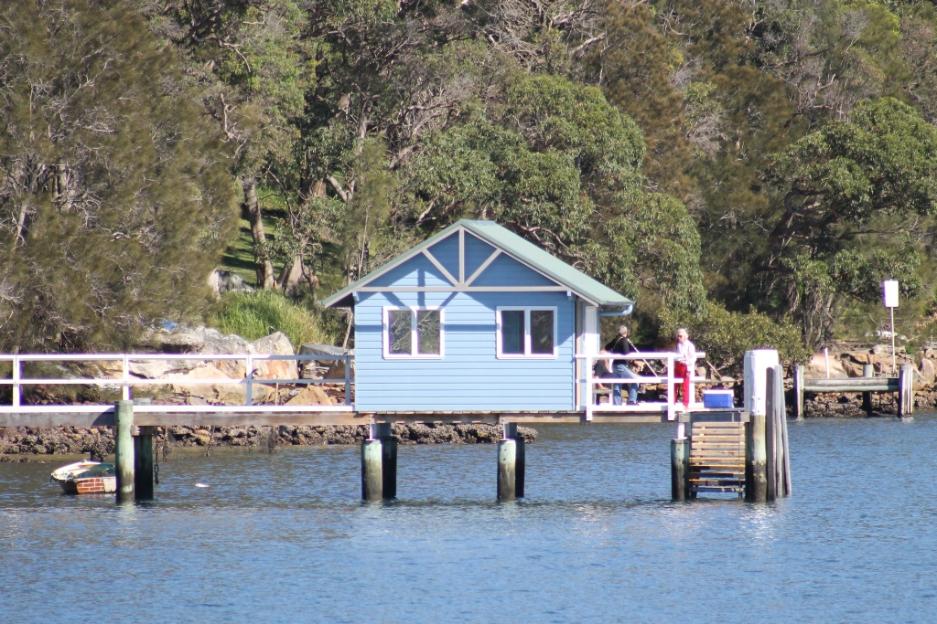
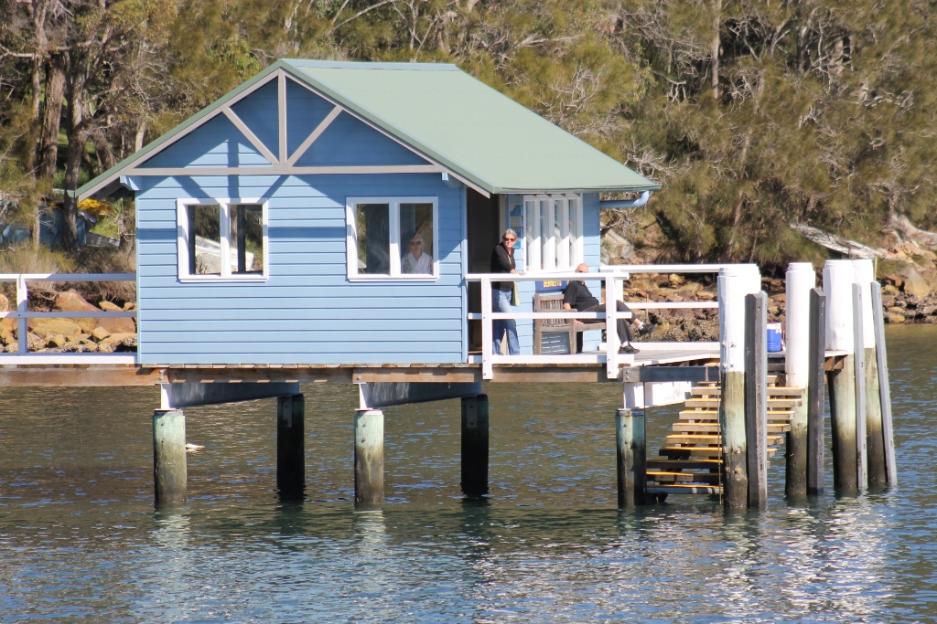
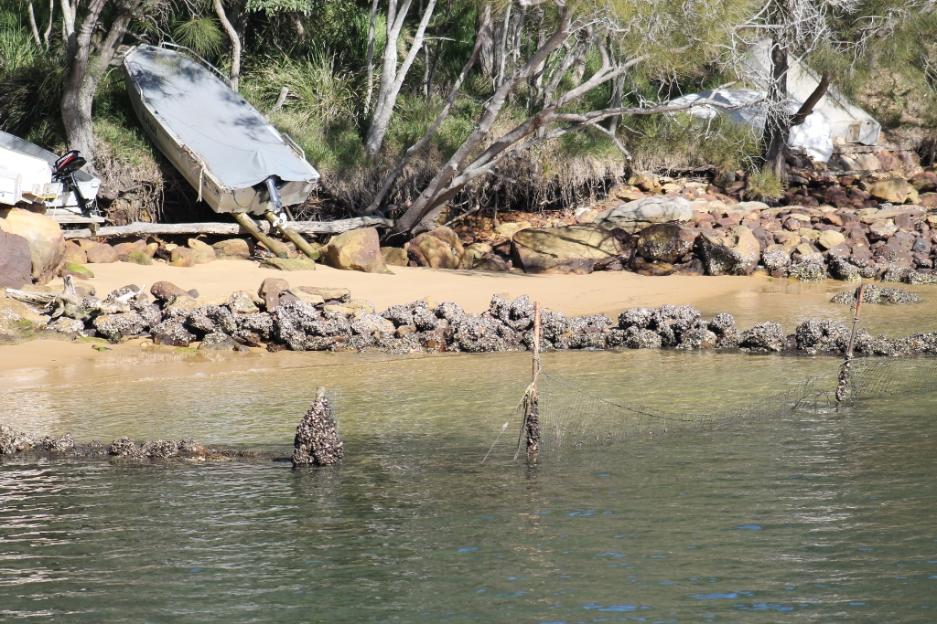
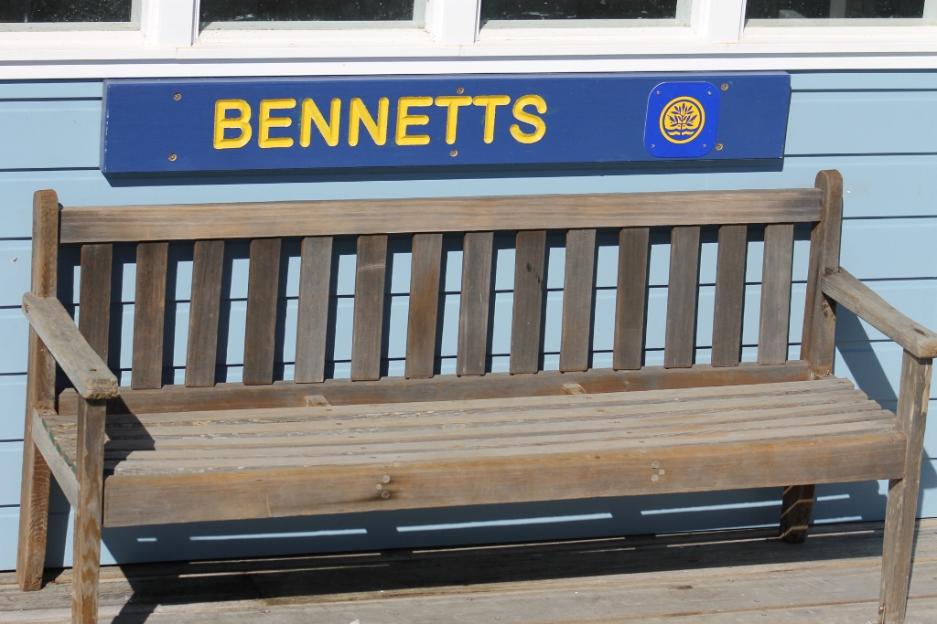
By 1945:
Sydney, 26th January, 1945.
IT is hereby notified that, in accordance with the provisions of subsection 1a (b) of section 26 of the Crown Lands Consolidation Act, 1913, Walter Laurence Harris, Esquire, is hereby appointed (in the place of Mr. A. A. Sterland, resigned), as a Trustee of the Ku-ring-gai Chase, Hawkesbury River, area about 35,300 acres, dedicated 14th December, 1894, for Public Recreation, and the following additions thereto, namely:—3 acres 1 rood 20 perches at Towler's Bay, Pittwater, dedicated 12th January, 1934; 7 acres 1 rood and 15 acres at Coaster's Retreat, Pittwater, dedicated 2nd August, 1911; 42 acres 2 roods 7 perches at The Basin, Pittwater, dedicated 31st August, 1917; 3 acres 3 roods it Cowan, dedicated 24th May, 1935; about 980 acres at McCarr's Creek, dedicated 19th April, 1940; 21 acres 2 roods 16 perches at McCarr's Creek, dedicated 29th May, 1942; 1,150 acres dedicated 27th August, 1943; 40 acres, parish of Broken Bay, dedicated 21st April, 1944; about 1,650 acres at Terrey Hills, dedicated 27th October, 3944; and about 90 acres at McCarr's Creek, dedicated 27th October, 1944. P. 45-248. J. M. TULLY, Minister for Lands. Government Gazette Appointments and Employment (1945, January 26). Government Gazette of the State of New South Wales (Sydney, NSW : 1901 - 2001), p. 153. Retrieved from http://nla.gov.au/nla.news-article225479459
Coasters Retreat residents honoured and remain Keepers of the bush setting of their homes and so no roads have ever been built there. After the Coasters Retreat Progress Association succeeded in connecting to the electricity supply in 1967, the Association became dedicated to the preservation of the unique coastal environment at Coasters Retreat. Electricity lines were hidden underground, road building never initiated, fences not allowed, and communal postal services maintained in order to promote a tranquil non-suburban environment. Subsequently, a Rural Fire Brigade was formed, protecting the community in 1994 from bushfires.
Coasters Retreat is located in Ku-ring-gai Chase National Park, on the western shores of Pittwater looking northward toward the Basin. Coasters is made up of fifty holiday houses set in the bush and beside the beach.
Coasters Retreat has no road or land access and alike visitors to The Basin, is accessed via the Palm Beach Ferry Service or paddling your own canoe!
As it should be.
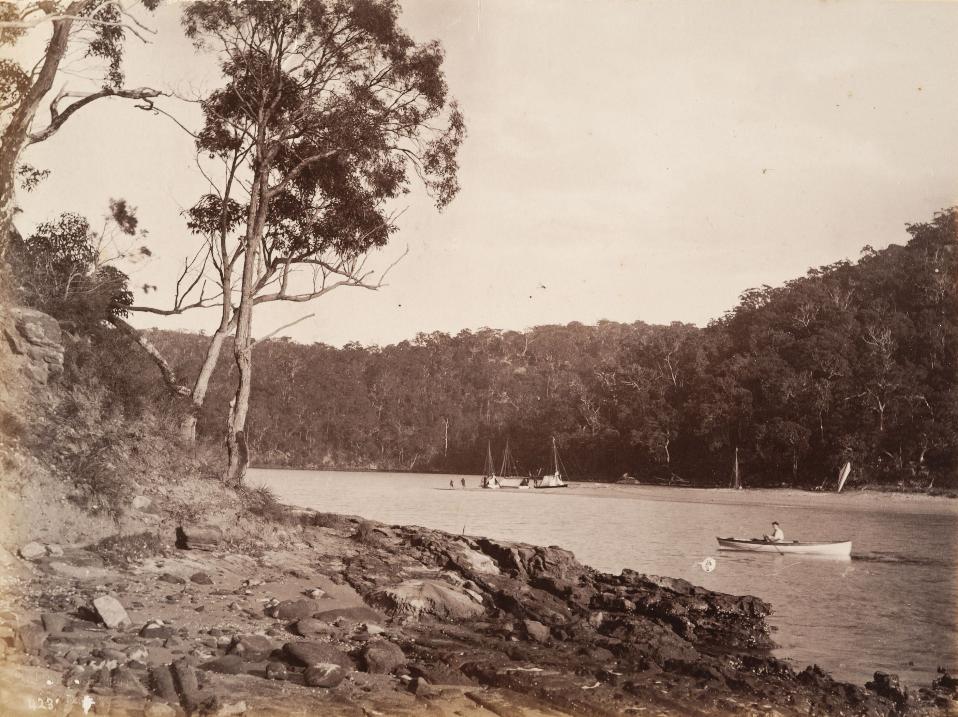
A Few Early Land Owners And Residents
John Andrews
John Andrews was born in the village of Severnstokes, Worcestershire, in 1795, the eldest child of Charles and Mary (or Martha) Andrews, farmers. When he joined the 80th Regiment of Foot (the Stafford Volunteers) on 13 May 1816 he could neither read nor write, but he learnt to do so while in the Regiment. John came to New South Wales in the advance guard of the Regiment, arriving on the Lady Kennaway on 12 October 1836. His duties in the next few years included guarding the iron gangs of convicts who were building roads around Hartley and Lithgow.
Sergeant John Andrews was discharged on 30 April 1841, after 25 years’ service. He received a pension, and also applied for and obtained the authorised remission in the purchase price of land, for which he was eligible. [AO Reel 1083] On 8 February 1842, fifty acres of land at the Basin, Pittwater, were advertised for sale as Lot 8. John Andrews purchased the land with the £50 remission to which he was entitled, and it was granted to him on 18 April 1842. [LTO SN75/1]
He married a widow, Hannah Jackson, on 4 January 1849. Both gave their place of residence as Broken Bay.
John Andrews agreed to sell six acres “to commence and be taken from the western boundary” of his farm to Joseph Shaw on 4 May 1849. He agreed to give Shaw legal title “at any time he may require” on condition of the purchase money being paid. John Collins was witness to the agreement. [LTO Book 82 No.492] See Joseph Shaw.
On November 4th 1859 John Andrews sold his grant to John Smith for £150. [LTO Book 71 No.929] John Smith made his will on April 11th 1862, just three days before he died, leaving the land to Hannah Andrews. Probate was granted to Hannah Andrews on April 11th 1872.
John Andrews, of Pitt Water, was charged, on the information of Joseph Shaw, with having wilfully and maliciously killed a calf, the property of informant. Mr. Borton appeared-for plaintiff; Mr. Moffatt for defendant. Several witnesses were examined, from whose evidence it appeared that about midnight of the 21st day of last month, prisoner entered plaintiff's ground adjoining his own at Pitt Water, and with a stick beat a calf belonging to complainant, from the effects of which the animal died the following day. Its head having been much bruised and its neck broken. The attorney for the prosecution having omitted to place complainant in the box to swear in support of the information, and to identify prisoner as the John Andrews there mentioned, defendant's attorney on those grounds raised an objection, which was ruled by the Bench to be fatal to complainant's case, and it was therefore dismissed. WATER POLICE COURT. (1859, October 5). The Sydney Morning Herald (NSW : 1842 - 1954), p. 3. Retrieved from http://nla.gov.au/nla.news-article13031574
Owen Golden, James Scott, and Margaret Downs were, on the information of John Smith, charged with having committed an assault upon him. Smith stated that he was a farmer, residing at Pittwater. On the 14th of November last he went down to Pittwater to see some land he had purchased from John Andrews, when he found the prisoner Downs living there. He asked her if she was going to leave the place, as he wanted the land. She replied, " I will not leave it so long as there's a stick stands up in the building."
The two other defendants were present. Smith showed them his title and deed of purchase, asking them to read the documents ; but they said there was no necessity. He then told them he should take the door down, and he tipped it off the wire, and took it to his house, which was at a short distance. Subsequently he went back, and knocked one of the slabs off the house, and went inside. Golden then took up one of the laths from the sofa, and struck Smith with it on the arm; Downs seized the kettle and threw some boiling water over him. Whilst he way trying to remove a slab near the chimney Downs attacked him with a piece of burning wood ; but he kept her away with an axe until the three defendants set upon him, got him down, and took the axe from him. The house was empty when Smith purchased the land (which was a grant to Andrews), and whilst he was in Sydney prisoners took possession of it; the house was about fifteen rods within the boundary. The only thing that Scott did was to take the axe from Smith; Golden struck him on the wrist with a batten. John Andrews deposed to having sold the land and house to Smith, and when he put Smith in possession of them no one was living in the house.
Some seven or eight years ago it was in the possession of a man named Joseph Shaw, to whom he agreed to sell it, with six acres of land ; Shaw built the house and was to give Andrews £6 for it, for the fulfilment of which he gave £1 as a deposit. There was a written agreement which Shaw kept, but he deserted the place in September last. Andrews then sold the place to Smith, the agreement with Shaw not having been completed. Smith (who lived with Andrews) on the day of the assault came home with his shirt nearly torn off his back, and his shoulders and loins so scalded that the skin came off in a day or two. He had also a cut on his arm which he could not use for several days, as well as a sear on his cheek like a burn. Downs, in defence, said her husband took possession of the house from Mr. Ross, custom-house officer, at Broken Bay. Scott was discharged, and Golden and Downs committed for trial at the next Quarter Sessions. Bail allowed. WATER POLICE COURT. (1860, June 5). The Sydney Morning Herald (NSW : 1842 - 1954), p. 3. Retrieved from http://nla.gov.au/nla.news-article13041403
On 10 October 1872 John and Hannah Andrews exchanged their land, which is still known as Soldiers Point, for a much smaller block of land at Careel Bay, belonging to John Collins, on which Collins had built a cottage. [LTO Book 132 Nos.923 & 924] This block of land was Lot 1 of Section XIII, bounded by John Street on the south, William Street on the west, and the creek on the north.
Bedridden since April 1877, John Andrews died on 12 May 1879 at the home of John Gould, Brighton Cottage, Whistler Street, Manly. He had no children. [2.]
ANDREWS, Charles
Charles Andrews was the younger brother of John Andrews. Born in 1799, in March 1818 he joined the 80th Regiment of Foot (the Stafford Volunteers), in which his brother was already serving. The Regiment came to Australia in 1836.
100 acres of land at Cabbage Tree Bay (North Manly) was advertised as Lot 7 on 8 February 1842. Charles teamed up with Christopher Skally to purchase the land, both of them being due for discharge. Under the regulations of 15 February 1840, a remission of £50 was authorised for Charles as a late Sergeant in the 80th Regiment, and a remission of £25 was authorised for Christopher Skally as a late Private in the 28th Regiment of Foot. The purchase price of £60 was well covered, and the land was granted to them on 9 May 1842. [LTO SN75/18]
Charles Andrews, settler of Manly Cove, and his wife Jane Isabella, and Christopher Skally of Windsor, and his wife Bridget, sold the land in 1847. 10 acres went to Isaac Lowry on 2 August 1847 for £10 [LTO Book 13 No.241]; 16 acres went to John Whaley on 9 August 1847 for £16 [LTO Book 35 No.160]; and 74 acres went to John Sims on 9 August 1847 for £63 [LTO Book 13 No.235]. John and Mary Anne Sims sold the 74 acres to Henry Miles, Thomas Youl, Thomas Kirby and Robert Symon on 19 December 1850. Symon sold his share for £8 to the other three, who partitioned the land among themselves on 27 November 1854. [LTO Book 35 No.799] Kirby immediately sold his share to Henry Gilbert Smith for £140, while Henry Miles, gardener, and Thomas Youl, stonemason, sold part of their land to Smith, but remained as residents. Whaley sold his 16 acres to Smith for £200 on 30 January 1855. This gave H.G. Smith ownership of all land along the ocean front north of the Corso, except a small part near Manly Lagoon, which still belonged to Thomas Youl. Isaac Lowry’s 10 acres passed through a number of hands before being purchased by James Farrell on 14 July 1871. This was the land commonly known as Farrell’s Paddock. [2.]
Joseph And James Shaw
Joseph Shaw was residing at Pittwater when John Andrews agreed to sell him six acres “to commence and be taken from the western boundary” of his farm at Coasters Retreat, on 4 May 1849. Andrews agreed to give Shaw legal title “at any time he may require” on condition of the purchase money being paid. John Collins drew up and witnessed the agreement. [LTO Book 82 No.492]
James Shaw, dealer in shells for lime at Pitt Water, was listed in the Sydney Commercial Directory for 1851. Joseph Shaw, with a freehold house and land at Pitt Water, was listed in the electoral roll (St. Leonards) for 1859-60.
Marriage: 1958/1844 V18441958 76 SHAW JOSEPH FORD HANNAH JN - IN Presbyterian at Parramatta
Children of Joseph and Susan (Hannah )Shaw
SHAW JAMES 1704/1849 V18491704 42A JOSEPH SUSAN
SHAW JOSEPH 1703/1847 V18471703 42A JOSEPH SUSAN
SHAW HANNAH 1529/1844 V18441529 28 JOSEPH SUSAN
SHAW MARY 1706/1854 V18541706 42A JOSEPH SUSAN
SHAW MARTHA 1705/1852 V18521705 42A JOSEPH SUSAN
The agreement for sale, indicating that Shaw paid £6 for the six acres of land at Coasters Retreat, was registered on 8 April 1863, suggesting that this had been, and was then, the Shaws’ place of residence. Joseph Shaw could not sign his name, and John Collins witnessed his mark. However, in a statutory declaration dated 6 July 1889, Collins’ widow Honorah stated, “At the time the conversation took place between Joseph Shaw and John Collins, Shaw said, ‘I have no money to give you for the land,’ when Collins replied, ‘I do not want any.’ My late husband put the receipt on the document at Andrews’ request.” On 10 October 1872 Andrews’ grant was conveyed to John Collins. A query arose later as to whether the Shaws had some legal right to the land, but this was discounted by the authorities, on Mrs Collins’ statement. [LTO PA 7492]
The Shaws must have been close friends of the Oliver family, who lived nearby, as Martha married Thomas Albert Oliver in 1871, and James married Ann Oliver in 1874.
A Joseph Shaw died in 1872, aged 77, and a Susan Shaw died in 1876, aged 72.
James Shaw, residing at Towler’s Bay, Pitt Water, was listed in the 1869-70 electoral roll; James Shaw and Joseph Shaw junior were listed in 1873-74. A Conditional Purchase of 40 acres of land at Towler’s Bay by Joseph Shaw lapsed, and was taken up by Arthur Wood, being granted to him on 10 July 1889. [LTO Vol.931 Fol.231]
From Hawkesbury River.— Rover, Shaw, wheat and maize. (June 16.) SHIPPING INTELLIGENCE. (1845, June 17). The Australian (Sydney, NSW : 1824 - 1848), p. 2. Retrieved from http://nla.gov.au/nla.news-article37157795
SHAW—ARCHBOLD.—October 14, at the Wesleyan Church Willoughby, by the Rev. J. J. Rodd, Walter Shaw to Annie Archbold. Family Notices (1891, November 2). The Sydney Morning Herald (NSW : 1842 - 1954), p. 7. Retrieved from http://nla.gov.au/nla.news-article13842339
Shaw Family at Coasters Retreat - The Basin:
John Andrews, of Pitt Water, was charged, on the information of Joseph Shaw, with having wilfully and maliciously killed a calf, the property of informant. Mr. Borton appeared-for plaintiff; Mr. Moffatt for defendant. Several witnesses were examined, from whose evidence it appeared that about midnight of the 21st day of last month, prisoner entered plaintiff's ground adjoining his own at Pitt Water, and with a stick beat a calf belonging to complainant, from the effects of which the animal died the following day. Its head having been much bruised and its neck broken. The attorney for the prosecution having omitted to place complainant in the box to swear in support of the information, and to identify prisoner as the John Andrews there mentioned, defendant's attorney on those grounds raised an objection, which was ruled by the Bench to be fatal to complainant's case, and it was therefore dismissed. WATER POLICE COURT. (1859, October 5). The Sydney Morning Herald (NSW : 1842 - 1954), p. 3. Retrieved from http://nla.gov.au/nla.news-article13031574
Owen Golden, James Scott, and Margaret Downs were, on the information of John Smith, charged with having committed an assault upon him. Smith stated that he was a farmer, residing at Pittwater. On the 14th of November last he went down to Pittwater to see some land he had purchased from John Andrews, when he found the prisoner Downs living there. He asked her if she was going to leave the place, as he wanted the land. She replied, " I will not leave it so long as there's a stick stands up in the building."
The two other defendants were present. Smith showed them his title and deed of purchase, asking them to read the documents ; but they said there was no necessity. He then told them he should take the door down, and he tipped it off the wire, and took it to his house, which was at a short distance. Subsequently he went back, and knocked one of the slabs off the house, and went inside. Golden then took up one of the laths from the sofa, and struck Smith with it on the arm; Downs seized the kettle and threw some boiling water over him. Whilst he way trying to remove a slab near the chimney Downs attacked him with a piece of burning wood ; but he kept her away with an axe until the three defendants set upon him, got him down, and took the axe from him. The house was empty when Smith purchased the land (which was a grant to Andrews), and whilst he was in Sydney prisoners took possession of it; the house was about fifteen rods within the boundary. The only thing that Scott did was to take the axe from Smith; Golden struck him on the wrist with a batten. John Andrews deposed to having sold the land and house to Smith, and when he put Smith in possession of them no one was living in the house.
Some seven or eight years ago it was in the possession of a man named Joseph Shaw, to whom he agreed to sell it, with six acres of land ; Shaw built the house and was to give Andrews £6 for it, for the fulfilment of which he gave £1 as a deposit. There was a written agreement which Shaw kept, but he deserted the place in September last. Andrews then sold the place to Smith, the agreement with Shaw not having been completed. Smith (who lived with Andrews) on the day of the assault came home with his shirt nearly torn off his back, and his shoulders and loins so scalded that the skin came off in a day or two. He had also a cut on his arm which he could not use for several days, as well as a sear on his cheek like a burn. Downs, in defence, said her husband took possession of the house from Mr. Ross, custom-house officer, at Broken Bay. Scott was discharged, and Golden and Downs committed for trial at the next Quarter Sessions. Bail allowed. WATER POLICE COURT. (1860, June 5). The Sydney Morning Herald (NSW : 1842 - 1954), p. 3. Retrieved from http://nla.gov.au/nla.news-article13041403
A Man Missing from Balmain -
Barrenjoey, Tuesday. — Nothing further has been heard of Joseph Shaw, the man who is missing from Balmain. He is supposed to have, under temporary insanity, left his home at Balmain on the 6th instant, and attempted to reach Broken Bay in a small open boat. There can be little doubt but that the unfortunate man has met with a watery grave, the weather at the time being very severe on the coast. The police have been making every possible search on the coast without result. A Man Missing from Balmain. (1884, October 16). The Daily Telegraph (Sydney, NSW : 1883 - 1930), p. 5. Retrieved from http://nla.gov.au/nla.news-article237221672
Shaw's Creek - Cahill Creek
A short watercourse at the southern tip of Pittwater. It rises near Suzanne Road Bayview, and is joined by two smaller branches within Bayview Golf Course. It enters Pittwater through a lined channel at Winji Jimmi Bay. Known as Winnererremy Swamp in the early days of European settlement, the name was applied to the Bayview area. Water drained into the swamp from the surrounding hillsides and flowed into Pittwater through a meandering mangrove lined channel called the "Newport Maze" on the eastern side of Pittwater Road.
Later, the creek was known as Shaw's Creek after the local blacksmith, who also built boats near the creek.
To the west of The Maze is Shaw’s Creek. I often saw old Jack Shaw stealing along silently in his ketch about dusk up McCarr’s Creek, like the “Old Grey Man of the Sea.”
In the creek which passes under the Bayview Road, the Shaw brothers, old pioneers, kept the ketches which they built thirty years ago or more.
Close at hand is the home of Mr and Mrs James Shaw, pioneers of the district. Mrs Shaw, who was formerly Miss Ann Oliver, was born on the peninsula, Lovett Bay, in 1856. Before that, her father, William Oliver, lived in a cottage on Cape’s Flat, near the Fig-tree, the site of which has been swallowed up by encroaching tides. Mrs Shaw told me that she had a vivid recollection of a black fellow spearing fish under a mangrove on the point of the flat just below Baker’s orchard. That was when she was a young girl. “I can see that blackfellow now,” said she, “with the fish quivering on the spear just as I see the leaves shaking on that tree.” On the bank of the small creek near the Bayview Post Office a blackboy who nursed her brother Tom was buried. Mrs Shaw said that probably the grave was covered over when the road was made to Church Point. - JSN Wheeler,
Mr. Johnson has a postcard, dated 1906, showing Pittwater Rd., Mona Vale with the three brick houses on the right, two houses and a wooden Church on the left of the road. Two of the brick houses were named “Esbank” and “Lithgow” (“Bowenfels” may have been the name of the third.) The two wooden houses were occupied by Wilsons and Aldridges. He cannot recall the occupant of the third wooden house. There are two tall cabbage tree palms on either side of the road, opposite house A.
There is a line or telegraph poles on the left-hand side of the road. Mr. Shaw built boats and launched them at the nearby creek.
Joseph Shaw Snr. - father of Joseph and James - wife was Hannah (nee Ford)
FORD Hannah Mary 1823 31/901 Ticket of Leave [4/4081; Reel 916] District: Parramatta; Tried: MGD
FORD Hannah Mary 1823 41/623 Ticket of Leave [4/4149; Reel 939] District: Windsor; Tried: MGD
Ticket of leave granted at Windsor and Parramatta – tried at MGD
Death of child:
SHAW HANNAH 6419/1865 Parents JOSEPH HANNAH WINDSOR (?)
SHAW MARY 2417/1878 JOSEPH SUSAN BALMAIN
Death
SHAW SUSAN 1250/1876 parents: UNKNOWN DIED SYDNEY
SHAW SUSAN 1022/1876 V18761022 102 AGE 72
James Shaw marriage (Ann is a daughter of William Oliver)
1256/1874 SHAW JAMES OLLIVER ANN at: BALMAIN
Children
SHAW ANN S 3418/1876 JAMES ANN BALMAIN
SHAW REBECCA M 3908/1879 JAMES ANN BALMAIN
SHAW JAMES J S 4059/1881 JAMES ANN BALMAIN
SHAW—OLLIVER—July 18, at the Wesleyan Church, Balmain, by the Rev. Richard Sellors, James Shaw, of Balmain, to Ann, daughter of William Olliver, of Pittwater. Family Notices (1874, July 31). The Sydney Morning Herald (NSW : 1842 - 1954), p. 8. Retrieved from http://nla.gov.au/nla.news-article13346696
For assaulting John Tancred, James Shaw was fined 40s, with £2 3s 8d costs, or in default two months. BALMAIN. (1889, August 24). Evening News (Sydney, NSW : 1869 - 1931), p. 6. Retrieved from http://nla.gov.au/nla.news-article108104546
Index to Gaol Photos:
SHAW Joseph 1872 Sydney Darlinghurst 10-08-11 11944 106 NRS2138 [3/6077] Alias: WILSON, James Alias: SHAW, James 2138_a006_a00603_6077000106r
Births
SHAW JOSEPH WILLIAM 4881/1872 JOSEPH MARY ANN WATERLOO
COTTAGE DESTROYED BY FIRE.
A fire broke out in a cottage at 16 Reuss street, Balmain, about 9 o'clock last night. It was owned by Mr. James Shaw, of Bayview, Pittwater, and occupied by Mrs. Amelia Morling. Brigades from Balmain and Rozelle were soon on the scene, and although every effort was made to save the building, which was of weatherboard, it was completely destroyed. The house was insured in the United Insurance Company for £200. COTTAGE DESTROYED BY FIRE. (1912, October 20). Sunday Times (Sydney, NSW : 1895 - 1930), p. 8. Retrieved from http://nla.gov.au/nla.news-article120678240
FIRE AT BALMAIN.
Just before 9 o'clock last night a five-roomed weatherboard house at 16 Reuss-street, Balmain, was destroyed by fire. The house was owned by Mr. James Shaw, senr., of Bay-view, Pittwater, and occupied by Mrs. E. Morling, No one was at home at the time, Mrs. Morling having gone out to a picture show about an hour previously. The house was in a thickly populated quarter, and the buildings on either side were damaged before the fire was extinguished. FIRE AT BALMAIN. (1912, October 20). The Sun (Sydney, NSW : 1910 - 1954), p. 4. Retrieved from http://nla.gov.au/nla.news-article228844837
SHAW.—March 19, 1933, at Collaroy, Joseph, dearly loved brother of James Shaw, of Bayview, aged 85 years. Family Notices (1933, March 20). The Sydney Morning Herald (NSW : 1842 - 1954), p. 8. Retrieved from http://nla.gov.au/nla.news-article16981660
SHAW.— The Relatives and Friends of Mr. and Mrs. JAMES SHAW and FAMILY, of Bayview, are kindly invited to attend the Funeral of their late beloved brother and uncle, Joseph Shaw, to leave our Chapel, 14 Belgrave Street, Manly, THIS MONDAY, at 3 p.m., for Gordon Road Cemetery, Mona Vale. WOOD COFFILL LIMITED, Motor Funeral Directors. Family Notices (1933, March 20). The Daily Telegraph (Sydney, NSW : 1931 - 1954), p. 6. Retrieved from http://nla.gov.au/nla.news-article247114305
SHAW Joseph Bayview near Manly, 19/03/1933 16/05/1933 Pre A 073708 [20/1741] - Occupation: retired master mariner
SHAW. — January 18, 1939, at his residence. Bay-view Road Bayview, James, dearly beloved husband of Ann Shaw, and loving father of Jim and Bee. Aged 89 years. Family Notices (1939, January 19). The Daily Telegraph (Sydney, NSW : 1931 - 1954), p. 20. Retrieved from http://nla.gov.au/nla.news-article247454326
SHAW JAMES 5426/1939 Parents: JOSEPH SUSAN MANLY - NSW BDM's Records
TO CORRESPONDENTS
JAMES SHAW (Balmain) : Corrimal v Metters match resulted in a draw, three-all. TO CORRESPONDENTS (1929, May 9). The Labor Daily (Sydney, NSW : 1924 - 1938), p. 3. Retrieved from http://nla.gov.au/nla.news-article239902349
Brother Joseph’s marriage (?): 1897 Or in 1874
431/1874 SHAW JOSEPH CHADWICK JOANNA SYDNEY
641/1897 SHAW JOSEPH E O'HARA FLORENCE A L BALMAIN SOUTH
DEATHS.
On the 7th instant, at her residence, the Western Road, Parramatta, after a short and painful illness, in the 60th year of her age, MARY, the relict of the late EDWARD LAKEMAN, and the beloved wife of JAMES CONNOR ; also, the beloved sister of Thomas Shaw, of Petersham ; also, of James Shaw, of Balmain ; also, of Joseph Shaw, of Wangarrata, Victoria ; also, of John Shaw, of the Paterson, leaving a bereaved husband and a large circle of relations and friends to mourn their loss. Family Notices (1874, February 12). The Sydney Morning Herald (NSW : 1842 - 1954), p. 1. Retrieved from http://nla.gov.au/nla.news-article28411542
CONNOR MARY 7061/1874 father: THOMAS DIED PARRAMATTA PARRAMATTA
Or death: SHAW HANNAH 6419/1865 Parents JOSEPH HANNAH WINDSOR
In the creek which passes under the Bayview Road, the Shaw brothers, old pioneers, kept the ketches which they built thirty years ago or more.
Close at hand is the home of Mr and Mrs James Shaw, pioneers of the district. Mrs Shaw, who was formerly Miss Ann Oliver, was born on the peninsula, Lovett Bay, in 1856. Before that, her father, William Oliver, lived in a cottage on Cape’s Flat, near the Fig-tree, the site of which has been swallowed up by encroaching tides. Mrs Shaw told me that she had a vivid recollection of a black fellow spearing fish under a mangrove on the point of the flat just below Baker’s orchard. That was when she was a young girl. “I can see that blackfellow now,” said she, “with the fish quivering on the spear just as I see the leaves shaking on that tree.” On the bank of the small creek near the Bayview Post Office a blackboy who nursed her brother Tom was buried. Mrs Shaw said that probably the grave was covered over when the road was made to Church Point.
Why The Spear Was Stayed —
STORY OF GRIT AND SILENCE
"EVERY muscle tense, an aboriginal chieftain stood poised over a pond in a Mona Vale garden yesterday, his hunting spear drawn back for the deadly thrust. Although the carp beneath him was an easy target, the spear was not launched, for realistic though the figure is, it is made of cement, not flesh and. blood. He is one of the many works modeled by Mr. H. Tristram Squire, whose garden is filled with life-like representations. Kangaroo and wallaby, lizard and snake are mingled with a dozen flamingoes, whilst a group of children stand quietly looking on. The interior of the house is no less remarkable than the garden. "Blank walls are hard and damaging to the sight," said Mr. Tristram Squire yesterday, whose walls are painted to represent land and seascapes. "The effect of a distant scene keeps the eye at a more or less natural range." Mr. Squire told of a large, black snake that he recently made for a friend, who placed it in a natural position among some bushes in his garden. The next morning the snake was smashed by an alarmed milkman.
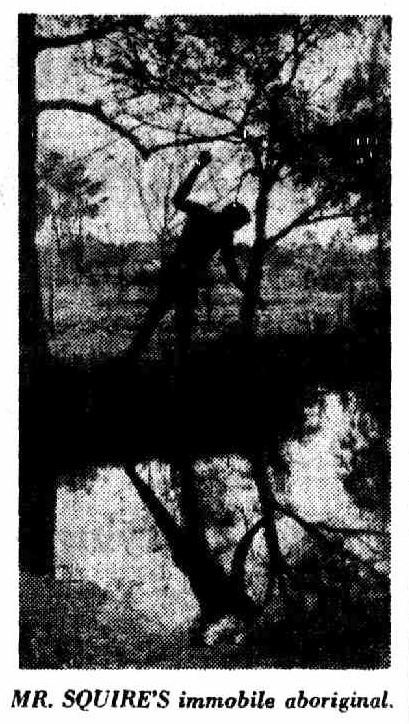
MR. SQUIRE'S immobile aboriginal.
Why The Spear Was Stayed (1935, May 14). The Daily Telegraph (Sydney, NSW : 1931 - 1954), p. 7. Retrieved from http://nla.gov.au/nla.news-article246472427
Sally Morris
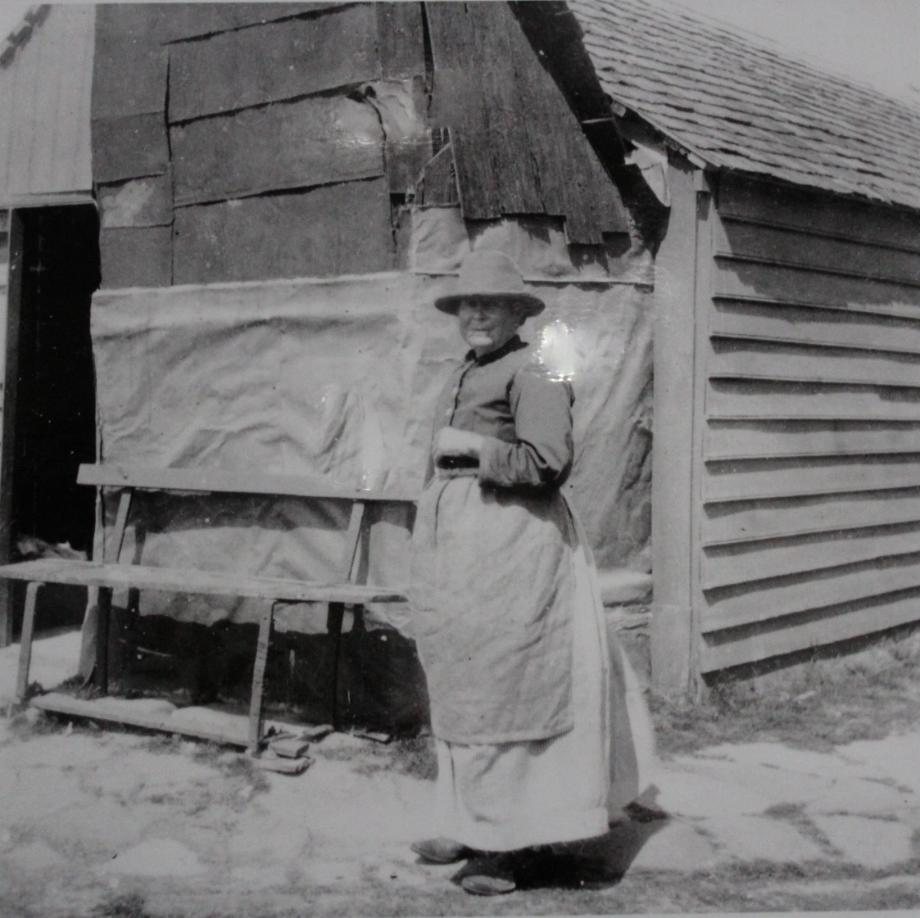
Jim Macken's photo of Sally Morris at her hut at The Basin.
A Glimpse of the Hawkesbury.
By Francis Myers.
ILLUSTRATED BY J. C. HOYTE.
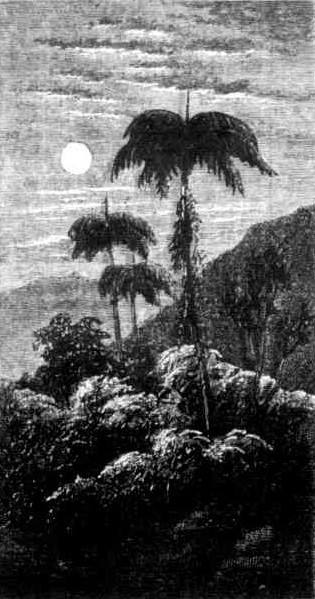 That blue glimmer of electric light along the quay gleams as the entrance of an infernal city, and the red lights above beam as the eyes of a thousand devils, and the smoke goes up as the smoke of a place of torment; for we brain-wearied workers, who have been ground in its mills for many months, are flying away to rest. Yes ; to rest amongst the cool sea spaces and the nodding caps and the sleeping islands and the majesty of beauty and the blessed peacefulness and quiet of that larger heaven within the heads of Broken Bay.' We travel by Manly, and a short hour's journey brings us to that fair suburb. From Manly, by the primitive old coach, to Pittwater. Horses rough, harness rough, coach shaky, road bumpy; still, however rude, right pleasant work, for the great white Easter moon floods all the land with silver sheen and mystery. The low hills rest like sleeping creatures with folded wings, the still lakes are as great glassy windows through which spirits of the inner world might peep at the outer glory, here and there stands a tall palm as a sentinel, and rounding headlands by the open sea the murmur of the waves come up as of a million sea doves cooing through their dreams.
That blue glimmer of electric light along the quay gleams as the entrance of an infernal city, and the red lights above beam as the eyes of a thousand devils, and the smoke goes up as the smoke of a place of torment; for we brain-wearied workers, who have been ground in its mills for many months, are flying away to rest. Yes ; to rest amongst the cool sea spaces and the nodding caps and the sleeping islands and the majesty of beauty and the blessed peacefulness and quiet of that larger heaven within the heads of Broken Bay.' We travel by Manly, and a short hour's journey brings us to that fair suburb. From Manly, by the primitive old coach, to Pittwater. Horses rough, harness rough, coach shaky, road bumpy; still, however rude, right pleasant work, for the great white Easter moon floods all the land with silver sheen and mystery. The low hills rest like sleeping creatures with folded wings, the still lakes are as great glassy windows through which spirits of the inner world might peep at the outer glory, here and there stands a tall palm as a sentinel, and rounding headlands by the open sea the murmur of the waves come up as of a million sea doves cooing through their dreams.
A FEW TALL PALM TREES STAND AS SENTINELS.
High shorelands sink to shelving braches, and there through the weird water the pink sand flushes, as the cheek of a young Endymion to the kiss of the lady moon. Still tearing along with wboop, and halloa, and much persuasion to the tired horses, and by a quick turn upon a sidelong track into woodlands high and dank and dewy, all dark below save for the glimmer of a few white starry flowers, but fringed with silver aloft, for it is midnight, and the moon is in mid heaven. And 'twere well if we could all go to heaven for an hour or two, for the mundane aspect considered in mundane fashion is not inspiriting The journey is ended, and from a grim house comes a grim custodian, gaunt and churlish. House, man, and furnishings all much alike — better forgotten, o-better, perhaps, fixed in memory as things seen upon the shores of that lovely water in the Easter of 1883. What will it be in '93? Certainly it will not be fairer than it appeared at the very earliest dawning of the following day. Look outward and be happy, for the sunrise has not yet lipped the hills. The lovely purple uncrowned by one single gleam of gold deepens to indigo upon the edge of the water, which in its centre reflects the gray of the sky and the dying lights of some few pale twinkling stars. The birds are piping timidly as fearing to break the solemn hushfulness.
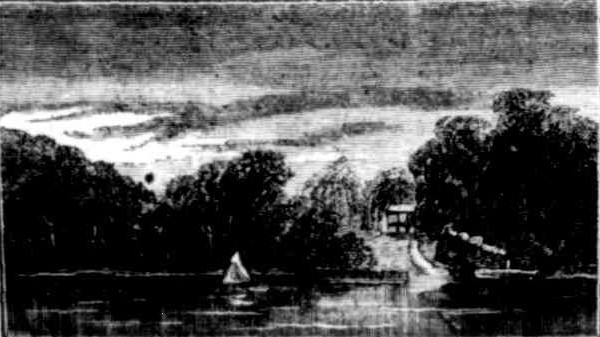
NEWPORT BASIN.
The tall trees hold every bough and branch and tiniest leaflet motionless. Only the blue mist quivers waiting, waiting — and suddenly, swiftly as the unfurling o1banners at a trumpet blast, a red light flashes on the high clouds to the westward, and the blue mist is burned up, and the glassy face of the water is broken, and the mystery of beauty of the dawning is thrust out of the world be for the glorious majesty of the day. The day spreads his livery of gold and brightness upon All the hills. The day smites the inner waters and the outer deeps with his strong hand and the white caps leap and flash, and the surges ring upon sand and rock. But very soon that white sail we are awaiting comes stealing, floating, gliding on, compelling the little fluttering breeze to her will, straight up the mid channel and round with a flutter of canvas abreast the narrow space of half civilized shore. And quickly we are on board and at rest.
There is no rest in the world to compare with that perfect abandonment, that absolute repose which comes with the idle lap of water against the vessel's sides, the near shores drifting backwards, a new heaven and a new earth perpetually opening ahead. At noon that autumn day we sailed into ' The Basin 'and dropped anchor. Ten years hence the article will be qualification enough for that basin. It will be no more necessary to ask what basin than what queen when Englishmen stand together to do allegiance. There are beauties enough within our own harbour gates, but they areas tiny pearls to an emperor's crown-jewel when compared with this. Here is a deep, still pool, a Constance, a Leman, a Katrine filled twice a day with the vigour and freshness of the strong sea tides.
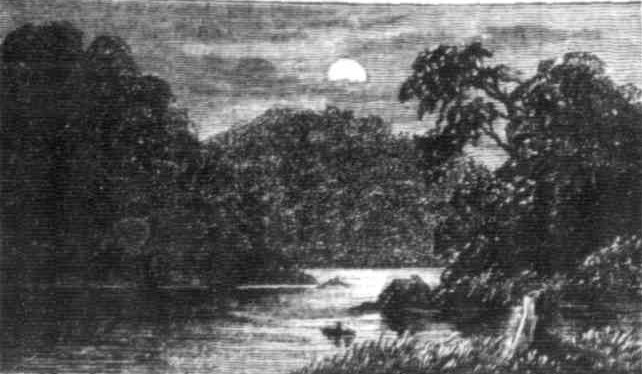
THE INNER BASIN.
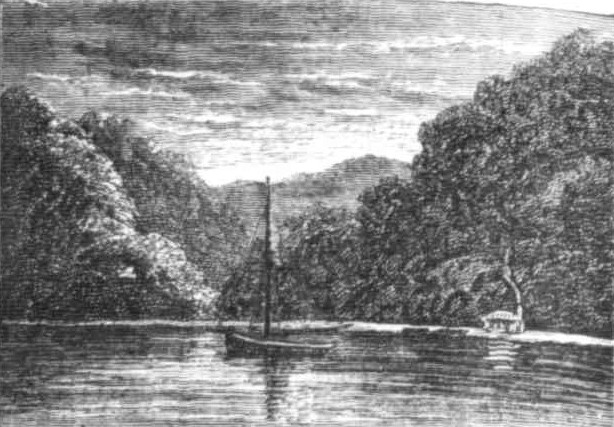
THE OUTER BASIN -MARY ANN'S HUT.
Round Barrenjoey comes the swirling rush, rolling along the eastern harbour branch through the deep channel, washing the point of the sandspit, whispering on every beach, and lapping gently at the rocky base of every cliff, then resting for a quiet hour while the sun sets or the moon rises, and some few strange birds chirp contentedly in the forest. The hills, of a lordly size in the daylight, rise huge and vast when the moonshines. The great tree trunks below are scarcely perceived, but above, each leaf edge touched by the white light sparkles and gleams, and the waterfall sings louder through the dark, dank fern, and lazily-moving oars strike fire from the blackness that is barred from shore to shore by the long moon rays. Strange that no poet has sung of the mystery of the moonrise, the dawning of the night light. It is colourless but marvellously beautiful, a perfect revelation of all the divinity of form. 'What will the future show us about that basin's banks? Houses, homes, pleasure grounds, one of the chief playfields of the city ? It has marvellous capabilities. Room enough upon the promontory jutting out from cliff toward cliff for such an hotel as we have not yet seen in Australia, water enough, always smooth and still and pure, to give battle space for half-a-dozen warships, or to bathe a nation, and water that about three chains of stout sea- fencing would render absolutely safe against all sharks and finny monsters.
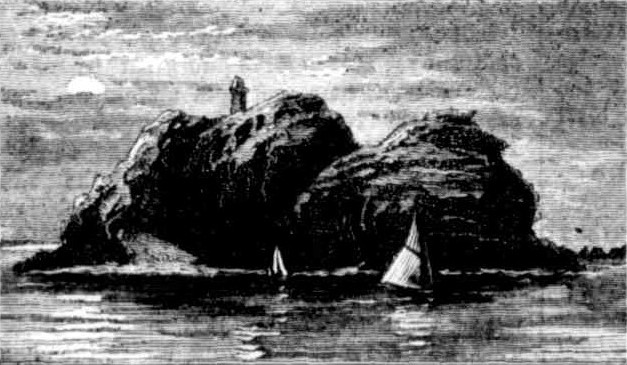
BARRENJOEY.
Now, a yachtsman's cottage and a fisherman's hut occupy the promontory, and for 11 months out of the year there is no more life or appreciation about the basin than about some lone tarn of the backblocks upon whose shore has been erected a boundary rider's hut. Morning brings us a dip in the lazy rollers upon the sand, a splash beneath the fresh water, raining from the ferns, a great breakfast of the black bream that swim into the fish-trap, poor foolish creatures, innocent and trustful as if their home were a thousand miles from any dwelling of man. Noon sees white wings spread again, and a further flight towards undiscovered beauties. Seeking the true Hawkesbury, we beat down abreast of the Heads, past the long sandspit coupling Barrenjoey to the mainland, regarding with much interest the huge,
grim, wave-washed, time-worn crag that lacks but around tower and a romance to fetter it to the hearts of a people. It bears a lighthouse useful to the mariner, but only vexatious to the dreamer. Wild and strong and stern frowns that rock with the sea foam at its base and the few sparse wind-tortured trees about its bead. It should have memories other than those of lamp- trimmers' yarns and convicts' jeers and groans.
And Elliott Island, lying almost in mid-channel, is also an artist's rock, so strangely shaped as to be capable of any comparison ; a lion couchant, a headless sphinx, a remnant of some giant's work of the world's strong youth worn down to vast indistinctness by winds and waves. Ah ! let us recall one evening when moored off the west head, the island and the rock, with every distant point, and all the dome of Heaven and the spaces of the sea, were seen transfigured and glorified by the out breathed spirit of a dying day. A thunderstorm had rolled over and lay upon the eastern bar and light from the clear inland western sky smote all its breast with fire. Some little shreds of cloud in midheaven let down a film of rain which bent the rays till they made bows upon the thundercloud, three separate trichord bands of light upon three points of distant land, an intense blackness below, and beyond a strange rich purple and greyness. Right out in the fore
ground Barrenjoey, his face as the face of an angry giant, every line, point, dent, and scar glowing as with the fire of an inward-born passion, and separated but by a silver band, the lovely Elliott Island cradled in blue water, fringed with the leaping foam, swathed in a silver haze that deepened to golden mist, end darkened too soon to a purple veil, all evanescent and beautiful as a dark proud woman's smile, and yet, thank God, in memory perpetual.
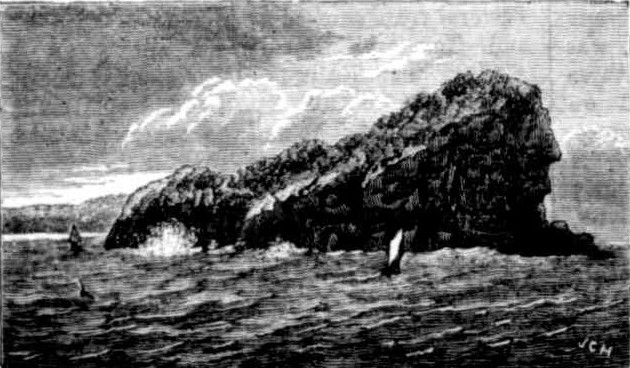
ELLIOTT ISLAND.
Round that West Head the river's mouth, or rather the ocean estuary, divides, and as we keep to the southern bank for a time the land is dreary, its monotony only broken by occasional fringes of sand and damp ravines, down which the waters flash, or trickle silently through wondrous mate of ferns, dense masses of luxuriant colour these ferns, showing every varying tints of tender green and rarest brown, the withered fronds above, dyed in the richest blood of autumn. But they are meanest details, thumbnail sketches in the great gallery. A merrier breeze pipes up from seaward, and in an hour we enter darker water, brown with all the silt of the big river, robbed of its beauty by the land stream and of its usefulness by the tide. A Glimpse of the Hawkesbury. (1883, April 7). The Sydney Mail and New South Wales Advertiser (NSW : 1871 - 1912), p. 640. Retrieved from http://nla.gov.au/nla.news-article162078253
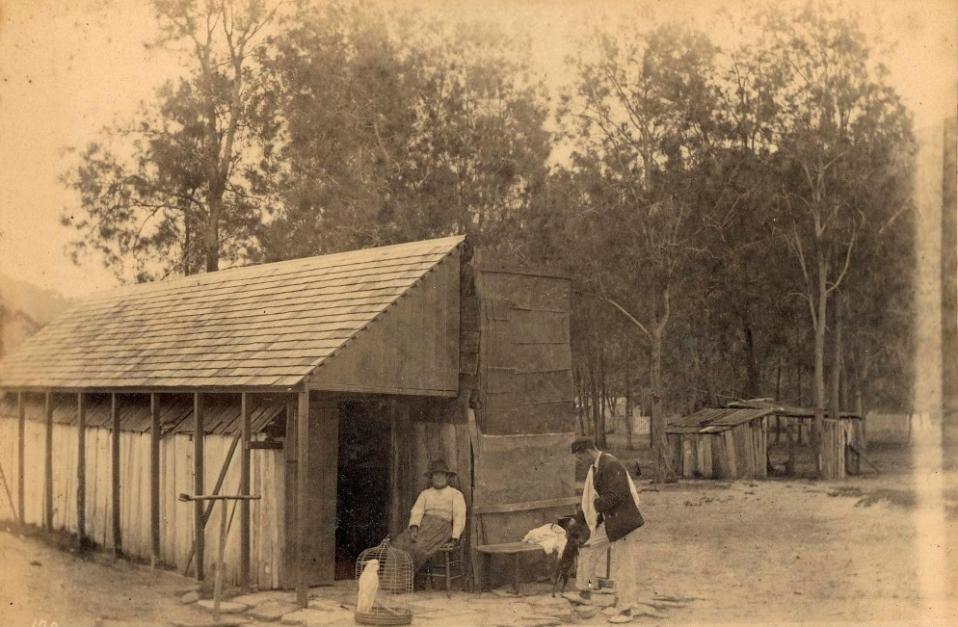
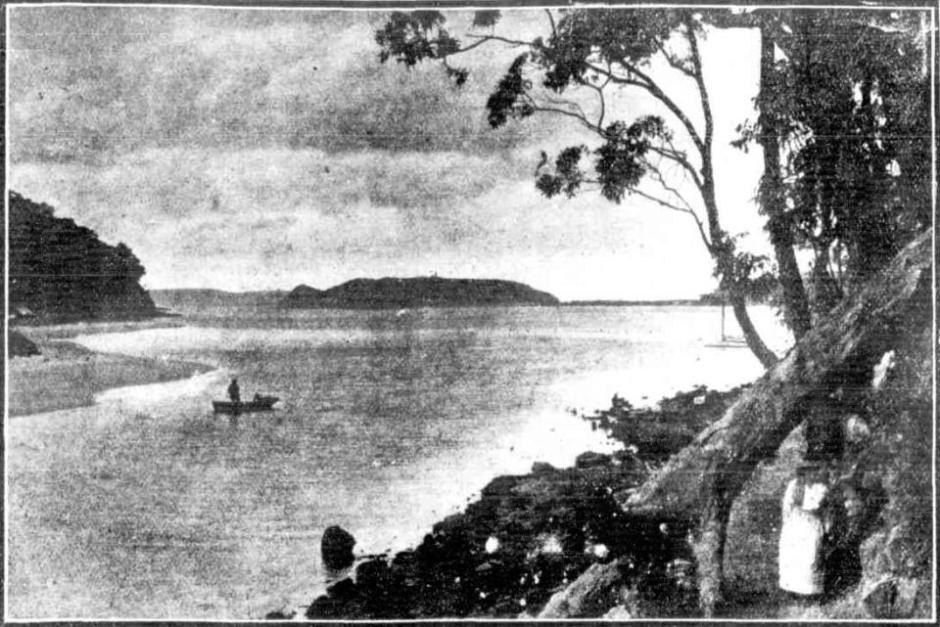
Barrenjoey, the Southern Sentinel Headland of Broken Bay.
The photograph was taken from The Basin, an inlet of Pittwater, where for years the various yachting clubs of Sydney used to rendezvous at Easter. Around The Basin; a path has been cut, leading- zig-zag fashion through a wealth of tropical foliage to the Flagstaff -Lookout at Lovett's Bay, whence a beautiful panoramic view is obtained to .the southwards. . Around the foreshores there are a .number of caves', .while the Kuring-gai Chase trustees have built fireplaces and provided shelter-sheds with tables and watertanks, making the region a delightful one for the holiday-maker..There are several ways of reaching The Basin and the surrounding' country, but the easiest from Sydney is by way of Manly and Newport. A good service of motor boats, several .of them run by returned soldiers, make regular trips.CALL OF THE AIR AND THE SEA. (1920, April 28). Sydney Mail (NSW : 1912 - 1938), , p. 9. Retrieved from http://nla.gov.au/nla.news-article159028149
YACHTSMEN'S FRIEND. THE LATE MRS. MORRIS.
Mrs. Mary Ann Morris, better known to Sydney yachtsmen as "Sally" or "Peggy," died on Monday last at her home at the Basin, Broken Bay, where she had resided for the past 63 years. Her death will be regretted by the yachting fraternity of Sydney, as her hut was a port of call for yachtsmen, when visiting Broken Bay, and they obtained from her supplies of fresh milk and eggs.
Mrs. Morris was the wife of the late Dicey Morris, and, prior to 1867, resided with her husband at Balmoral Beach. About that time her husband sold wood to Admiral Hornby's Flying Squadron during its visit to Sydney, and, with the money thus made, he built the hut at the Basin, Broken Bay, in which Mrs. Morris lived. The couple went to live in this hut at the Basin in 1868, and the husband engaged in fishing there. He did not live long after settling at Broken Bay, and his boat was acquired by a fisherman named Sam Strongman, who also lived at the Basin.
Mrs. Morris kept a few cows and fowls, and was always ready to supply visiting yachts-men with milk and eggs. She also often baked a very welcome damper for them. She adopted three lads at different times, one of whom was with her up to the time of her death. She possessed a good collection of yachting pictures, and recognised every yacht as it dropped anchor In the Basin. Her memory for faces was also very good, and she never forgot the owner of a yacht which had visited the Basin.
She was known to many as "Peggy," while to others she was better known as "Sally."
Amongst the oldest members of the yachting fraternity who were well acquainted with Mrs. Morris were the late Mr. H. C. Dangar, the late Mr. James Milson, the late Mr. Grafton Ross, the late Mr. Jack Want, and the late Sir James Fairfax and their various successors, including Mr. F. J. Jackson, who owned the property at the back of the reservation which was subsequently resumed by the Kuringgai Chase Trust. YACHTSMEN'S FRIEND. (1921, June 9 - Thursday).The Sydney Morning Herald (NSW : 1842 - 1954), , p. 9. Retrieved from http://nla.gov.au/nla.news-article15960831
"PEGGY' MEMORIAL
The memorial, in the form of a sundial, erected by Sydney yachtsmen at "The Basin," Pittwater, to the late Mrs. Morris, well known to all visitors to Broken Bay as "Peggy" will be unveiled at noon tomorrow (Easter Sunday) by Mr. Alfred G. Milson. A large fleet of yachts and cruising craft journeyed to the Bay for the Easter holidays, and a good muster of yachtsman is expected at the function. Mr. Paul Ross, commodore R.P.A.Y.C.. is hon, treasurer to the fund, and will be pleased to receive further contributions, as the amount already subscribed Is far from sufficient to cover expenses. "PEGGY' MEMORIAL (1922, April 16). The Sun (Sydney, NSW : 1910 - 1954), , p. 7. Retrieved from http://nla.gov.au/nla.news-article223948591
PEGGY OF THE BASIN.
A sundial mounted on a trachyte pedestal was unveiled as a memorial to the late Mrs. Morris at The Basin, Pittwater, Broken Bay, on Easter Sunday by Mr. Arthur Milson, of the Royal Sydney Yacht Squadron, in the presence of a number of yachtsmen, by whom the funds for its erection were subscribed. Mrs. Morris, who was known to and respected by sailing men as Peggy, lived at The Basin for many years, and was a general favorite. She made it her business and pleasure in life to see to. the comfort of the campers at that favored spot, and her death last year was a great loss to frequenters of the place. PEGGY OF THE BASIN. (1922, April 26). Referee (Sydney, NSW : 1886 - 1939), , p. 5. Retrieved from http://nla.gov.au/nla.news-article127924554
IN HONOUR OF 'SALLY.'
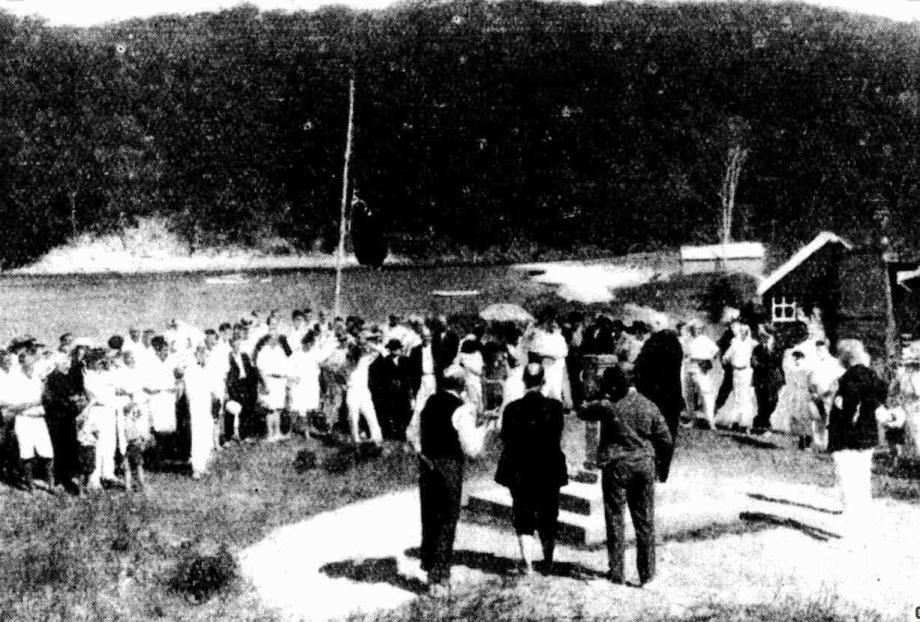
At the Basin, Broken Bay, recently, a sun-dial was unveiled by Mr. A. G. Milson in the presence of a large number of boating men in honour of the late Mrs. Morris ('Sally'), who for: very many years was a friend of the yachtsmen who visited that beautiful spot-. No title (1922, May 10). Sydney Mail (NSW : 1912 - 1938), , p. 32. Retrieved from http://nla.gov.au/nla.news-article169770154
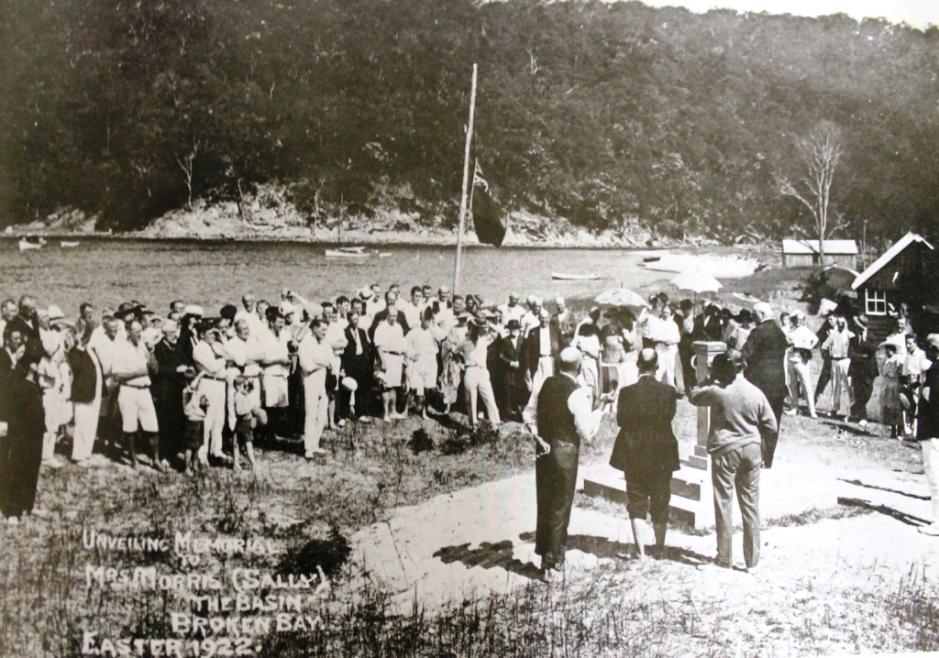
Unveiling Memorial to Mrs. Morris (Sally) - The Basin, Broken Bay - Easter 1922.
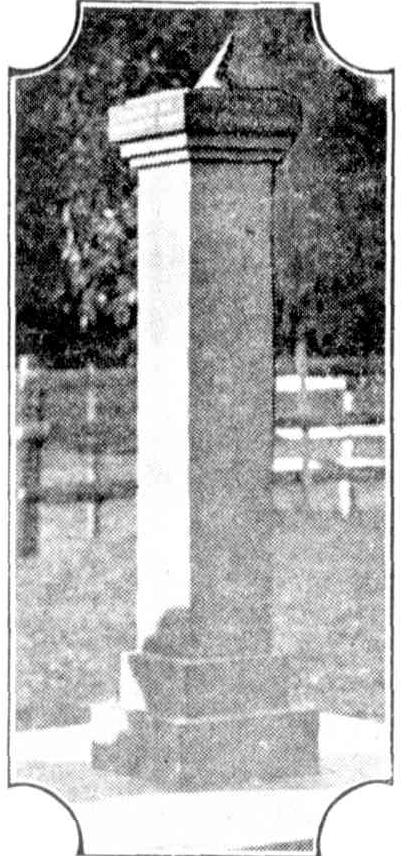
SUNDIAL to the memory of Mrs. Morris ("Sally") at Kuringai Chase.
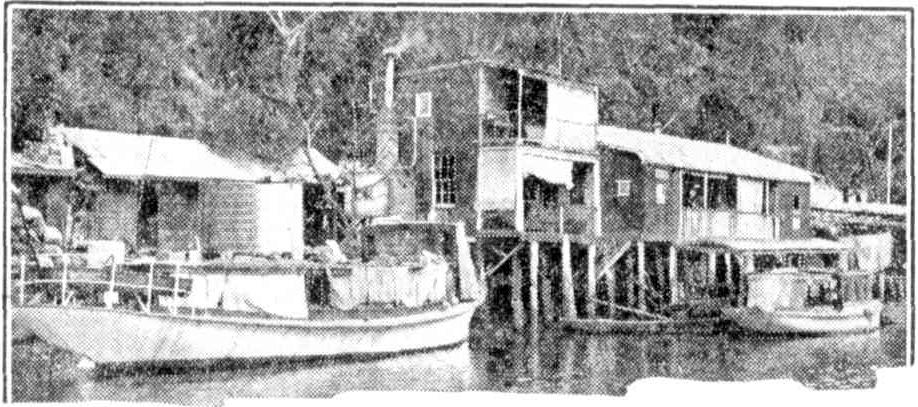
PILE DWELLINGS at Kuringai Chase: — The Windybank boatshed.
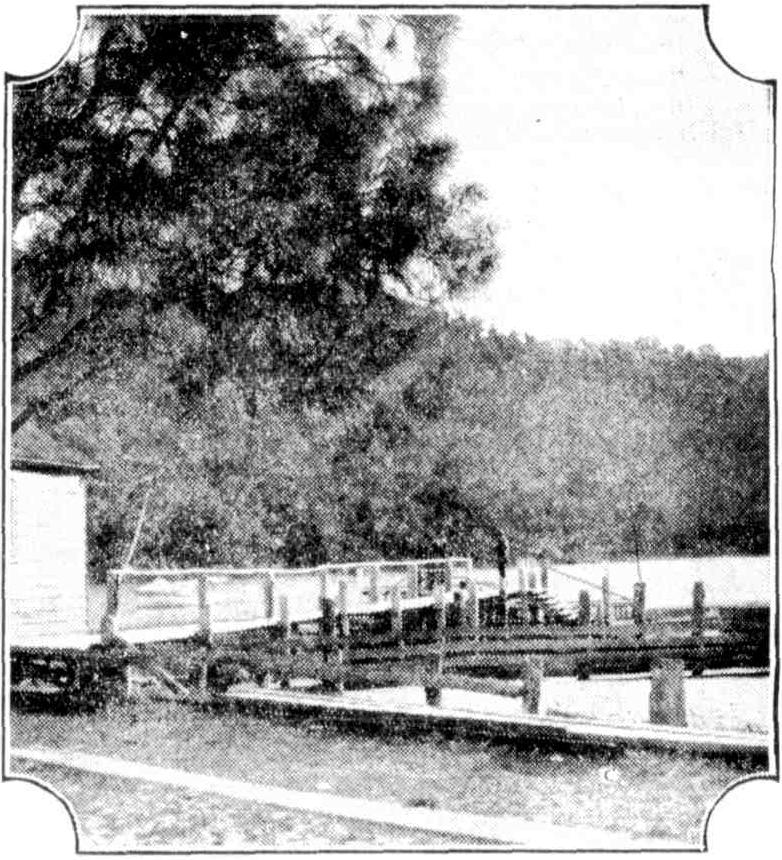
WHARF AT THE BASIN, Kuringai Chase.
Copies of pictures taken by our Photographer are obtainable from the “Sun” Feature Bureau. Through the Eye of a Camera News of the hour in Capical Pictures (1926, September 14). The Sun (Sydney, NSW : 1910 - 1954), , p. 20 (FINAL EXTRA). Retrieved from http://nla.gov.au/nla.news-article222728745
Frederick James Jackson
A gentleman of this yachting fraternity, and owner of Topham, or ‘Beechwood Cottage’ (erected in 1882), passed away soon after Mary Ann. Frederick James Jackson purchased the land at the Basin from the previous owner's creditor in 1881.
Mary Ann 'Peggy or Sally of The Basin' was paid to clean it and keep and eye on the cottage when the Jackson family and their guests were not using while visiting:

Topham - "Beechwood" also sometimes as 'Beachwood' Mr. F. W. Jackson's cottage at "The Basin"

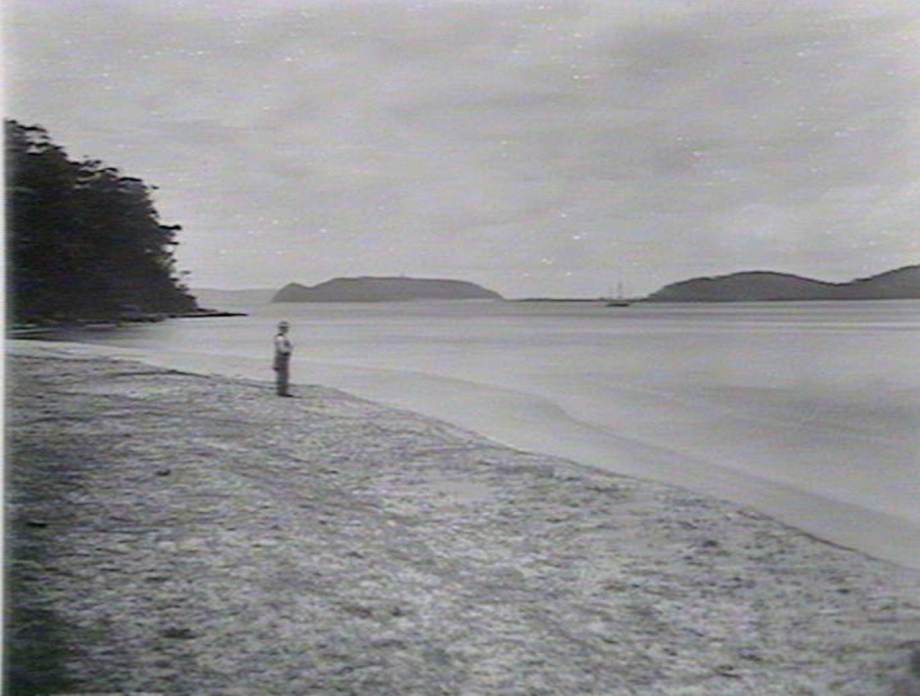
Topham. Coasters Retreat, Pittwater, looking towards. By Barrenjoey Government Printing Office, Image No.: 1 - 08824, courtesy State Library of NSW.
Records indicate there were 70 photographs taken by the Government photographer, Mr O'Dwyer accompanied by Kuring-Gai Chase Board Trustee Eccleston du Faur in 1899, some of the first ever taken in this area, making images of the landscape, waterways and some of the early waterfront businesses which have since vanished.
From Managing Trustee's report 25th October, 1899;
"I have visited Galston road (a similar Departmental work) so as to be able to judge amount of fencing which the Government considers necessary on steep roads of this character, and I am prepared to put the fencing in hand next week. During the past quarter our Co Trustees J. De V Lamb, our Hon. Secretary and the Principal Under Secretary Mr. Critchell Walker and several others visitors have fully inspected the works in progress.
During ten days of the last fortnight (14th-23rd Oct) I have entertained the Government Photographer and his assistant, under authority from the Government Printer, I have had a most successful expedition, returning with 70 full sized plates (15x12) taken all round the Chase, including Pittwater, and illustrating almost every point of interest at present accessible. This involved nearly 150 miles of travelling, mostly in launch or boat, our apparatus being very heavy. After a somewhat trying voyage round "West Head" to Pittwater, on Saturday last when I took the precaution to engage Windybank to take our heavy baggage and to accompany us round to "The Basin", I have been obliged to leave the launch at Newport until the weather clears. This trip has not only involved, the sacrifice of ten consecutive days of my time, but I have had since and have still before me heavy clerical work in recording and cataloguing results and I propose furnishing to the Government Printer a resume of the history of and progress of works in the Chase for insertion in his official albums." - Verbatim from minutes of Board of Trustees meeting 25th October 1899.
"The President reported that Messrs. Du Faur, Wright and himself on Sept. 21 visited the Pittwater Section accompanied by Mr, O’Dwyer, the Government photographer." - From minutes of meeting 25th September, 1900
For more on Eccleston du Faur work top make and retain green areas here, See Pittwater's Parallel Estuary - The Cowan 'Creek' and Pittwater's Lone Rangers - 120 Years of Ku-Ring-Gai Chase and the Men of Flowers Inspired by Eccleston Du Faur
YACHTSMAN AND SPORTSMAN
Mr. Frederick Jackson Passes
Mr. Frederick J. Jackson, who died recently at his residence, Darling Point, linked the past generation of yachtsmen with the present. In the days of the old deep keelers, Mr. Jackson was one of the most enthusiastic and successful sailing men in New South Wales, and more than held his own at the tiller against such redoubtable yachtsmen as Dr. Mackellar, Mr. Alfred Milson, Mr. Edward Knox and the late Mr. Alfred Fairfax, Dr. Milford, Mr. Jack Want and Mr. Prosper Williams. Mr. Jackson was one of the founders of the Royal Prince Alfred Yacht Club, and at the time of his death was the oldest member of the Royal Sydney Yacht Squadron. As far back as the year 1867 he won the yacht race at the Anniversary Regatta with Gitana, an eight-tonner which had been a large half-decker. With this yacht he won numerous races. Later on Mr. Jackson owned the famous yacht Mischief, in which he had years before sailed In English waters. Subsequently he purchased the Ione, and after racing her with success sold her to Mr. Alfred Milson. His last yacht was the well known and stately Violet, which was built for him in 1876 by Langford to the design of D. Hatcher, of Southhampton. Violet, in her early days, was the winner of many races- with her owner at the tiller. In his later years of yachting, however, Mr. Jackson avoided racing, contenting himself with cruising, particularly along the coast, and often sailing to Broken Bay, where he possessed a residence and property. In the '70'8, '80's and '90's Mr. Jackson was one of the inner circle of local yachtsmen, and took a leading part in the control of the sport. Of him it may be said that he was thorough—both as a yachtsman and a gentleman. PERSONALS IN SPORT . (1923, June 6).Referee (Sydney, NSW : 1886 - 1939), p. 1. Retrieved from http://nla.gov.au/nla.news-article128114326
MORE ABOUT A VETERAN YACHTSMAN
The Late Mr. Frederick J. Jackson. His Early Impressions of Sydney
Seventy-two years in business was Mr. Jackson's record, excepting for a painful parenthesis last year, due to a tram accident. He came to Sydney 64 years ago, and his reminiscences connect the London of Charles Dickens with the early days of Sydney. In London as a Junior clerk in an insurance office, he frequently saw on his business errands Queen Victoria and the Prince Consort during the Crimean War, and Empress Eugenie, on her visits to the English Court before the Franco-German War had ended her regal career. In those days, as in the latest, the Interest of his leisure hours was centred in boat-building and sailing. He knew the Thames from quiet Kingston to the troubled tidal-waters of the estuary, and In this neighborhood he lost his first boat and gained some unexpected experience from a bibulous sailor engaged to Instruct him.
FIRST PEEP AT SYDNEY.
Of his first morning in New South Wales Mr. Jackson had a keen recollection: 'I was 'Staying at a hotel near St. Phillip's Church,' he related. 'After a restless night I rose early, anxious to see what Sydney was like, and what prospects it offered externally for business. I walked down Jamieson-street Into George-street, and turned towards the Quay. In those days it was Chinese quarters. The houses were for the most part mere shanties, dismal looking and squalid. They say that 'first impressions go a long way!' My first Impressions had a most depressing effect on my spirits.' : I could see no prospects of establishing a branch of the insurance company I represented, and had a strong inclination to find a good ship going home, and embark at once.
A YACHTING VISION.
However, I continued my walk, crossed the Domain and sat down near Mrs. Macquarie's Chair to contemplate the waters of the Harbor. What a vision for a yachtsman! A seven-ton yacht was riding at her moorings, and a great desire seized me to sail a boat like that across the dancing waters and explore the distant bay's. As such possibilities occurred to me I forgot my wish to return to England, at least for the present. On my return to the hotel I learned that the owner of that fascinating little craft was about to leave Australia, and was offering it for sale. Eventually I found myself the happy owner, and I fully believe that yachting has saved my life.' There Is nothing better to rest and refresh a busy man. The change of thought, the glorious salt air, and the companionship of men united in a love of Nature and adventure makes yachting the ideal sport. During my earlier years in Australia I had a serious illness, some lung trouble apparently, and the doctors, Melbourne doctors, by the way, forecasted my decease in a fortnight. That was over sixty years ago!' Mr. Jackson was the only surviving founder of the Royal Sydney Yacht Squadron, and the 'father' of the Royal Prince Alfred Yacht Club.' PERSONALS IN SPORT. (1923, June 13). Referee (Sydney, NSW : 1886 - 1939), p. 1. Retrieved from http://nla.gov.au/nla.news-article128116707
THE LATE F. J. JACKSON
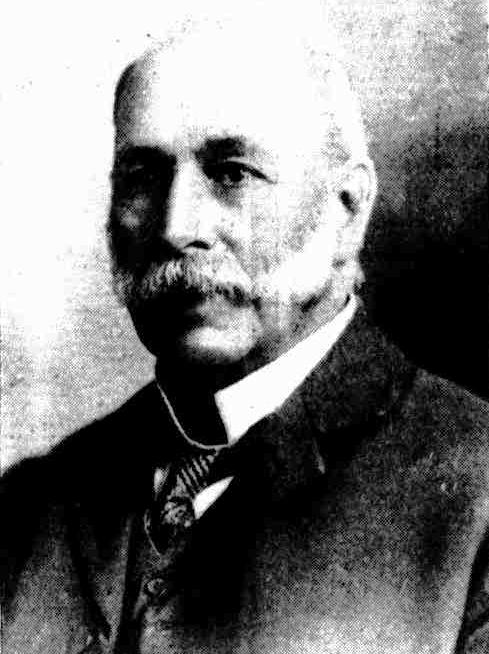 THE recent death of Mr. F. J. Jackson represents a loss to the business world of Sydney of one of the most well-known and highly-esteemed men in insurance circles, and it has removed from the social sphere of his private life a famous yachtsman and picturesque figure in the clubs to which he belonged. Mr. Jackson came to Australia with a wide knowledge of insurance to establish the European Assurance company, and the general management of that company's affairs was in his hands while it continued operations in Australasia and New Zealand. He then joined the Victoria Insurance Companies, and started their career in New South Wales, opening the branch office in Sydney as resident secretary of the Victoria Insurance Company, Victoria Life and General Company, and the Victoria General and Guarantee Company. It was in this position prior to his retirement from the active management of the first mentioned company in 1901 that he became a notable personality amongst insurance men in Sydney, being a prime mover in every project lending to advance the interests of insurance companies in general and his own in particular.
THE recent death of Mr. F. J. Jackson represents a loss to the business world of Sydney of one of the most well-known and highly-esteemed men in insurance circles, and it has removed from the social sphere of his private life a famous yachtsman and picturesque figure in the clubs to which he belonged. Mr. Jackson came to Australia with a wide knowledge of insurance to establish the European Assurance company, and the general management of that company's affairs was in his hands while it continued operations in Australasia and New Zealand. He then joined the Victoria Insurance Companies, and started their career in New South Wales, opening the branch office in Sydney as resident secretary of the Victoria Insurance Company, Victoria Life and General Company, and the Victoria General and Guarantee Company. It was in this position prior to his retirement from the active management of the first mentioned company in 1901 that he became a notable personality amongst insurance men in Sydney, being a prime mover in every project lending to advance the interests of insurance companies in general and his own in particular.
He was one of the original members, on its formation, of the Sydney Underwriters' Association, a prominent member of the committee, and chairman on a number of occasions, and he acted as the first chairman of the present existing association, known as the Sydney Marine Underwriters' and Salvage Association, Limited, which was formed in 1898 from the original Underwriters Association. He was for some time also a member of the committee of the Fire Underwriters' Association of New South Wales, a member of the Sydney Chamber of Commerce, and at one period one of the two representatives of the insurance companies on the New South Wales Fire Brigades' Board. Quite a number of successful business concerns owed much to his advice and foresight in the early direction of their policy. He retired from the active management of the Victoria Insurance Company in 1901, but carried on the secretaryship of the Victoria Life and General Company and the Victoria General and Guarantee Company until the date of his death.
A keen observer, who had seen, many changes with the growth and progress of the State, he was greatly interested in historical records, and was an enthusiastic member of the Royal Australian Historical Society. Mr. Jackson was a sailorman at heart. He held a record of many years' service in the defence forces of New South Wales — naturally in the naval branch of the service, and he worked strenuously for the advancement and efficiency of the New South Wales Naval Brigade, of which he was the senior lieutenant; when it merged into the Commonwealth Naval Force, and in the latter he held the rank of lieutenant-commander on the retired list at the time of his death.
F. J. JACKSON'S name will long be remembered in the annals of yachting, and amongst those who enjoyed this form of recreation during the era of sails and with the more modern use of motors. Having been a keen yachtsman in England in the waters on either side of the Thames, he was not long without a yacht to cruise in after his arrival in Sydney, and he owned a number of yachts well known in Sydney Harbour at different times. Perhaps the most famous of these in her day was the 10-ton cutter Violet, in which he won many prizes and cruised for many years along the New South Wales coast to Broken Bay, until, moving with the times, he adopted the motor launch as the means of following the call of the sea. His motor launch Valeria carried the flag of the Royal Prince Alfred Yacht Club until the close of the last yachting season in Sydney.
He was one of the original 19 members and founders of the Royal Sydney Yacht Club and one of the oldest members of the Royal Prince Alfred Yacht Club, life membership of the latter institution having been conferred on him in recognition of his invaluable services to yachting. He left a widow and one daughter and four sons.THE LATE F. J. JACKSON (1923, June 27). Sydney Mail (NSW : 1912 - 1938), , p. 46. Retrieved from http://nla.gov.au/nla.news-article159025457
OLD-TIME CORINTHIANS.
FREDERICK J. JACKSON.
(By 'CORINTHIAN.')
We of the present day are apt to forget what we owe to the pioneers of yachting in these waters. The difficulties of all descriptions which arose only to be overcome, and the benefit to sport thereby, must have been enormous. Such enterprise In the push by the pioneers has Placed the pastime of sailing generally on a sound footing. For Instance, in last Saturday's sailing events there were 93 entries, and this fleet probably carried crews numbering close on 600. How many of those participants ever give a thought to those who made it possible for them to compete under well-drawn-up rules and conditions, for the various prizes that were competed for? It Is well at times to take a look back and honor those who 'blazed the track.'
It is safe to say that we have among us the oldest Corinthian south of the line, in the person of Mr. F. J. Jackson, who, since 1881, has held the position of secretary of the Victoria Insurance Company, and is esteemed among yachting men and commercial men alike. Before reaching these shores Mr. Jackson, who is a Londoner by birth, but by residence and adoption can now be called an Australian, got his baptism at the hands of Father Neptune. This occurred when ho was thirteen years of age. At that time he and his brother purchased a 9-ton yawl. Neither of the budding Corinthians thoroughly understood the management of their property, and they were compelled to employ a professional to give Instruction. This Individual took them out Ina howling gale, and, after being out ail night, landed them on the Essex shore at dusk on the following evening. Shortly afterwards the gale Increased, and their mentor, who had been left in charge, forsaking the shrine of Neptune for that of Bacchus, allowed her to drag her anchors, and she, in consequence, become a total wreck. The unfortunate occurrence did not kill Mr. Jackson's love of the sea though his brother declined to join In another such venture. Within six months he purchased the Hero, of nine tons, and during his ownership of this craft familiarised himself with ll the ways of the sea. He next bought Ellen, then Brilliant, Bantam, Kate, and lastly the 11-tonner Traveller. The chosen cruising ground was the Thames estuary and Its upper reaches. Mr. Jackson was cruising off the north of Foreland when the Australian steamer Royal Charter was wrecked close by in a heavy gale. He himself only managed to gain safety after a hard battle with the elements.
On arrival at Sydney, at the age of twenty three, he was disappointed to fin that there was no yacht club In existence, the Sydney Club having become extinct. Within six months of his arrival he purchased Gitana, a 7-tonner, and won several prizes with her in subsequent regattas. Gitana was run Into by a steamer, and then was afterwards lengthened, growing in size to 10 tons. After dispoing of her he bought Mischief, which was transported from the Old Land by the late Mr. James Milson in 1865. Mr. Jackson was not unacquainted with Mischief having enjoyed a sail in her before his departure from England. He also came across a 9-tonner called Julia which he had been in process of building at Samuel Pepy’s Yards, Blackwall, London. Mischief was raced with varying success.
It was at this time that the Royal Sydney Yacht Squadron arose from the ashes of the Sydney Club. Mr. Jackson was one of the original members of that Institution, and the only one now alive that has owned a credit throughout his connection with it. He was a member of the first committee, and continued in that capacity for a number of years, finally retiring. After parting with Mischief, Mr. Jackson sailed Ione, previously the property of Mr. Grafton Ross, and won a number of races with her. In 1877 Mr. Jackson sent to Hatcher, of Southampton, who was famed as a designer at that time, for the plans of a 10-tonner. As a result the famous Violet was built locally by the late W. Langford. Her success was phenomenal, being finally so heavily handicapped that success was impossible. She Is credited with being the last yachts designed by Hatcher, and when Mr. Jackson sold her he closed his racing career, having won in various boats owned by him in England and Australia about 15 prizes. Since those days be has owned various craft, both motor and steam, Valeria being of the latter. Mr. Jackson was for twenty-three years associated with the local Naval Brigade, during the time the old Wolverine, afterwards broken up at Auckland. N.Z., was at the corps disposal for sea training. He holds a coast masters certificate by examination. The Royal Prince Alfred Yacht Club conferred Life membership upon Mr. Jackson In recognition of his Invaluable services to yachting. Mr. Jackson has lived happily lo see the waters of Port Jackson studded with craft of all descriptions— In contrast to the small number of white wings that ploughed IU depths when the world was rather younger. OLD-TIE CORINTHIANS. (1913, November 8). Saturday Referee and the Arrow (Sydney, NSW : 1912 - 1916), p. 3 Supplement: ISSUED AS A SUPPLEMENT WITH THE SATURDAY REFEREE. Retrieved from http://nla.gov.au/nla.news-article117417916
Mr. Jackson was among those who objected to The Basin being used for Oyster leases:
Objections to Extensive Oyster Leases.-Recently the Fisheries Board decided to lease 10,000 yards of foreshore In Pittwater to an enterprising man for oyster-fattening beds. The area was not continuous, but scattered round Pittwater, Bayview, Newport, Careel Bay, The Basin, and Saltpan Point. Several objections were, however, resolved to the leasing, residents having water frontages urging that there would be depreciation of their property, interference with their water approach, and deprivation of net-fishermen by taking away their hauling grounds. They also pointed out that unsightly stakes and stones would be laid on the leases in connection with oyster culture, and that the sewage from houses round this arm of Broken Bay would make the oysters dangerous food. Mr. F. Farnell (chairman of the board) and Mr. J. A. Brodie (chief inspector) paid a visit to the place a few days ago to Investigate the validity of the objections, and reported that none of the objections was tenable. Provision had been made for boat access to properties abutting on the lease, the hauling grounds were not to be leased, the Navigation Department had no objection to the erection of ballast walls to protect the oyster banks at Careel Bay and Saltpan Point so long as they did not extend further out than low water mark, and there was no danger of the oysters becoming affected by sewage. With this report before It the board decided to grant the majority of the leases, but set apart Towler's and Lovett's Bays and other parts used by the public for public oyster reserves.FRANCE REFUSES SOCIALISM. (1906, August 4). The Sydney Morning Herald (NSW : 1842 - 1954), p. 10. Retrieved from http://nla.gov.au/nla.news-article14791145
Mr. Hogue: No one had any right to order the public off the proposed leases.
Mr. T. A. Dibbs pointed out that the Ku-ring-gai Chase trustees and the Fisheries Board had overlapping control of the foreshores of the park. At Coal and Candle Creek a few years ago all the oysters were cleaned out by someone's authority.
Mr. Trevor Jones said that section 4S of the Fisheries Act, relating to leases, left it open for existing lessees to give the public much trouble if they accidentally trespassed on the leases or disturbed the oysters.
Dr. Arthur: Can the people who ordered the public off the foreshores be punished for doing so?
Mr. J. T. Swanson said that the Fisheries Board had an inspection of the leases recently, but did not let the objectors know; they were coming.
Mr. Hogue, In reply, said he would not express any opinion as to whether those who ordered people off the leases could be punished, but they had no legal right to do so.
The Fisheries Board was charged with the administration of the Act, and he had been prepared to grant the leases on its recommendation, but when Mr. James Clarke's applications for leases came before him, and were followed by the objections, he suspended their issue till he heard more from the people most concerned. He had to encourage the oyster industry on the one hand and see that settlement of the people was not retarded on the other. People could not be given a right to wander all over the leases when they were granted. If they were, the oysters would soon disappear. Mr. Clarke was an enterprising man, who had made a life-long study of oyster culture, and it was his duty to give him encouragement. At the same time the granting of the leases did not give the lessee the right to warn people off. He would meet the objectors by not granting the leases at the Basin and on Ku-ring-gai .Chase, and would consider others, but the majority of the leases did not inter-fere with the public enjoyment, and would be granted. OYSTER LEASES AND PUBLIC RIGHTS. (1906, August 23).The Sydney Morning Herald (NSW : 1842 - 1954), p. 3. Retrieved from http://nla.gov.au/nla.news-article14797671
More in Oystering in the Pittwater Estuary - Oyster Kings and Pearl Kings and When Not to Harvest Oysters
The area encompassing ‘The Basin’ on Pittwater was purchased in 1915 by the Kuring-gai Chase Trust from Mr. Jackson.
Sydney, 17th May, 1929. IT is hereby notified that in accordance with the provisions of the 26th section of the Crown Lands Consolidation Act, 1913, Thomas Walter Spencer, Esquire, is hereby appointed in the place of Mr. R. J. Greig, resigned, as a Trustee of Ku-ring-gai Chase, Hawkesbury River, area about 35,300 acres, dedicated 14th December, 1894, for Public Recreation, and the following additions thereto, namely: 3 acres 1 rood 20 perches at Towler's Bay, Pittwater, dedicated 12th July, 1931; 7 acres 1 rood and 15 acres at Coaster's Retreat, Pittwater, dedicated 2nd August, 1911; and 42 acres 2 roods 7 perches at The Basin, Pittwater, dedicated 31st August, 1917. [Misc. 1929-3,314] R. T. BALL, Minister for Lands.Government Gazette Appointments and Employment (1929, May 17). Government Gazette of the State of New South Wales (Sydney, NSW : 1901 - 2001), , p. 2089. Retrieved from http://nla.gov.au/nla.news-article223021175
An example of the area being used, including the other spelling of "Beechwood":
BOYS' CAMP AT PITTWATER
In the pretty spot at Coasters' Retreat, Pittwater, opposite Palm Beach, a camp is to be conducted, on splendid lines, for boys, from December 18; and .parents in the Cootamundra district who would like to see their lads a good time, should call at our office and see tho full details, or write to the director, Mr. Hugh wuui. jun., 511 New South Head Road, Sydney. The entire activities of 'Camp Enterprise', will be supervised by Mr. Ward, who Is an experienced camper and yachtsman. He has cruised on the Barrier Reef and New South Wales coastal waters, and has spent some time at a famous boys' summer camp in tho Green Mountains, Vermont, U.S.A. Over ten years' experience in catering to the wants of the public in the amusement business, and a knowledge of what boys enjoy most, make Mr. Ward a most competent man to direct operations. The swimming baths are great, being shark-proof, with a beautiful white sandy bottom, wonderfully suitable for teaching and developing non-swimmers, and at the same time interesting to the most competent. The boys will have the use of the entire camp equipment, under the control of the director and counsellors, on the inner and outer basins, and in addition expeditions In the motor boats 'Murela' and ''Grace VII.' will be made outside for schnapper fishing when conditions permit; and exploratory trips to Barranjoey Light House, Lion Island, Refuge Bay, Patonga. Cowan Creek, and other places will be made frequently. Pittwater and the Hawkesbury Estuary abound in nooks and corners that simply demand investigation, and the boys will be afforded every opportunity to explore and fossick about.. Mackerel,. yellowtail, and bream are plentiful near the camp, and give great run on light tackle. The bush about the camp is in its natural state, and the hills are rough and suitable for climbing. Those who like biking will have plenty at scope, while the sailing boat, rowing boats, motor boats, and baths will enthral those who prefer the water. One of the counsellors will be an expert sailing man; and all the boys, from the youngest to the oldest, will have .a chance to learn something of the art of handling a sailing boat ' if they, have the Inclination to do so.'
There is a properly laid but cricket pitch adjoining the cottage. All those boys who are backward in the art of swimming will be taught. Every effort will be made by the instructor, not merely to teach the boys to paddle .about, but to do the modern strokes, so that, if they happen to show any real aptitude and ability for the sport, they will have a sound basis for their efforts.
The main building of the camp is a large weatherboard cottage, the. living, rooms, and verandahs of which will be used as the dining quarters, and for lectures and games in the evenings. This substantial house will ensure top production of good food under all weather conditions, and it will be the rallying point and centre of the camp's activities. The boys will sleep in large Waterproof tents on beds, mattresses and .pillows supplied and maintained by the camp.
“Beachwood” is well finished. Parents are welcome at all times, and arrangements have been made for their accommodation should they desire it, so the can see the conditions under which the camp is conducted. One of the counsellors is a competent 'first-aid, man, and a doctor can be telephoned and brought to the camp in less than half an hour should the need arise. There will be no rigid 'army' type of discipline, and no corporal' punishment of any kind; but boys who do not behave in a satisfactory manner will be dealt with by the director. As the arrangements at the camp are complete; to the last detail the director reassures parents not to supply the boys with any pocket money.
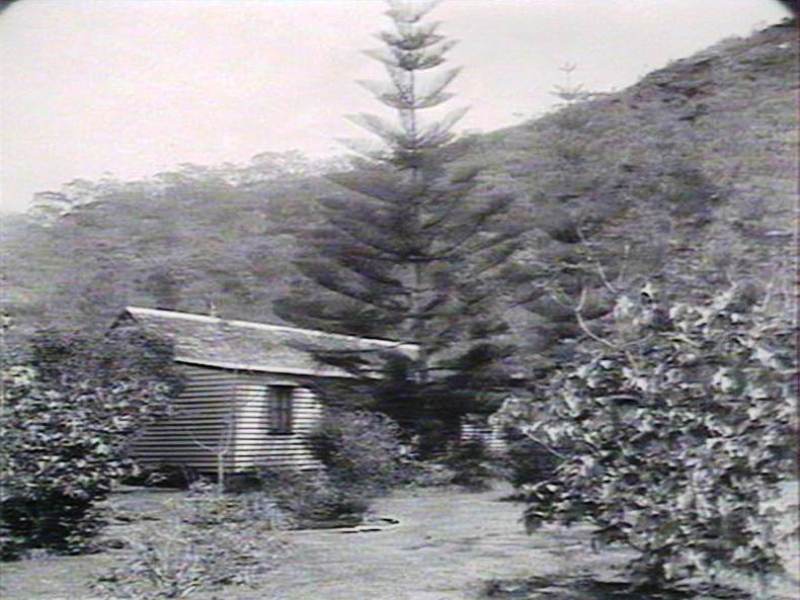
Beechwood - Topham. F.W. Jackson's Cottage at The Basin, Government Printing Office 1 - 08825, courtesy State Library of NSW.
The fee paid for attendance at camp covers every item. Finance: Period A, commencing December 18th, till school reopening (about 8 .weeks), 24 guineas; period B, December 28th till school reopening (about 7 weeks), 21 guineas; period, C, January 2 till school reopening (about 6 weeks), 19 guineas, period D, a fortnightly rate; £7/10/. Terms, 10 per cent, on application, the balance on departure for camp. BOYS' CAMP AT PITTWATER (1931, October 26). Cootamundra Herald (NSW : 1877 - 1954), p. 4. Retrieved fromhttp://nla.gov.au/nla.news-article139102599
In 1967, following 73 years of management by the Ku-ring-gai Chase Trust, the Chase was declared a national park under the NPWS Act 1967. Spectacle Island was dedicated as a reserve for public recreation in 1919 and as a nature reserve in 1972. In 1891 Long Island was reserved for public recreation and in 1972 became a nature reserve except for railway uses. Lion Island, dedicated as a fauna reserve in 1956, was also dedicated as a nature reserve under the NPWS Act 1967.
Another change for those accessing the area via vessel:
PROCLAMATION. NAVIGATION ACT, 1901, N.S.W.
I Sir Philip Woolcott Game, Governor of the State of New South Wales and its Dependencies, in the Commonwealth of Australia, with the advice of the Executive Council, and in pursuance of the powers and authorities vested in me by the Navigation Act, 1901, do, by this Proclamation, declare that the waters within The Basin, Coasters Retreat, Pittwater, discharging into Broken Bay shall, on and after the first day of February, 1931, be a harbour wherein all vessels, shall proceed at a speed not exceeding four (4) nautical miles per hour and such reduced speed shall be observed after passing to the westward of the Stone Wharf on the south side of The Basin channel.
Signed and sealed at Sydney, this third day of February, 1931. PHILIP GAME, Governor. By His Excellency's Command, JOHN T. LANG, Colonial Treasurer. PROCLAMATION. (1931, February 13). Government Gazette of the State of New South Wales (Sydney, NSW : 1901 - 2001), , p. 677. Retrieved from http://nla.gov.au/nla.news-article220236343
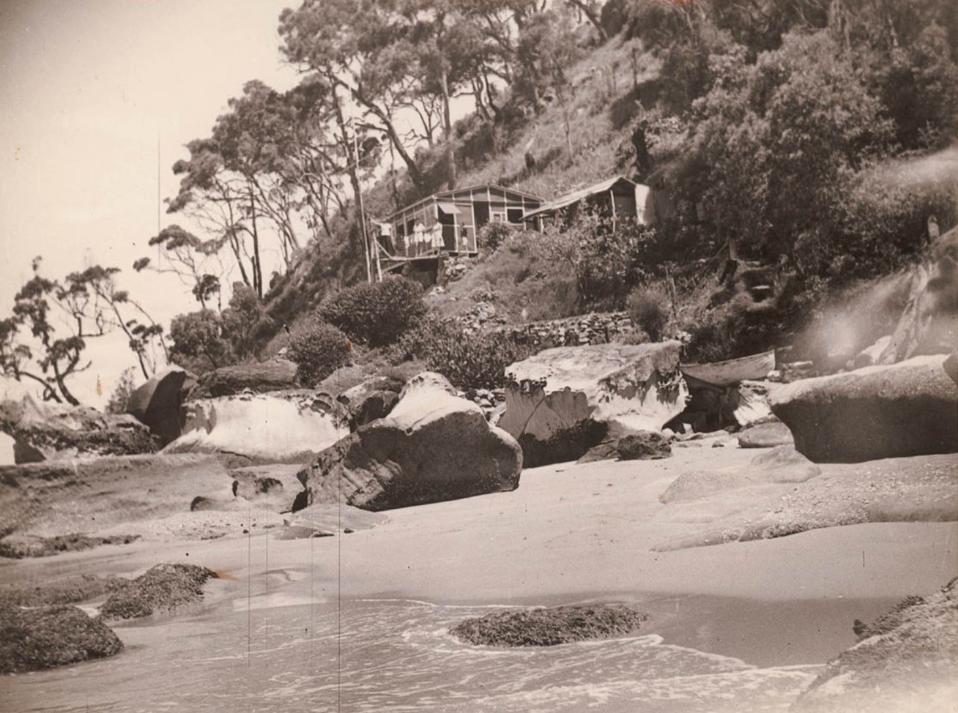
References And Extras
- TROVE - National Library of Australia
- Shelagh Champion OAM and George Champion OAM, in their Profiles of the Pioneers in Manly, Warringah and Pittwater (1996 - revised 2013)
- Sally Morris of The Basin. Jim Macken. 2001.
- The Mulhalls Of Broken Bay And Barrenjoey - Australian Champions
- The Basin, Pittwater: A Reprise
- A Tent at The Basin
- Historic Insights From The Australian National Maritime Museums 1890 Pitt Water 'Era' Yacht Collection: The Basin Regattas
- Pittwater Fishermen: Great Mackerel, Little Mackerel (Wilson's Beach - Currawong) and The Basin
- Pittwater Summer Houses: Rocky Point And Elvina Bay Peninsula - A Place Of Holiday Songs And Operas In Ventnor, Fairhaven, Trincomalee And Maritana
- Martin Burke - Pittwater Patriarchs
- Pittwater's Lone Rangers - 120 Years Of Ku-Ring-Gai Chase And The Men Of Flowers Inspired By Eccleston Du Faur
- Pittwater’s Parallel Estuary: The Cowan ‘Creek’
- The Hon. James Joseph Macken - 'Jim' - Profile
- Easter Cruises in Pittwater from 1893
Also Available:
- Pittwater Roads II: Where the Streets Have Your name - Scotland Island
- Pittwater Roads II: Where the Streets Have Your Name - Newport Beach
- Pittwater Roads II: Where the Streets Have Your Name - Clareville
- Pittwater Roads II: Where the Streets Have Your Name - Avalon Beach
- Pittwater Roads II: Where the Streets Have Your Name - Warriewood
- Pittwater Roads II: Where the Streets Have Your Name - Elanora Heights, Green Hills and Ingleside
- Pittwater Roads II: Where the Streets Have Your Name - Mona Vale
- Pittwater Roads II: Where the Streets Have Your Name - Bungan
- Pittwater Roads II - Where the Streets Have Your Name - Bilgola
- Roads In Pittwater: The Bay View Road
- Roads In Pittwater - The Barrenjoey Road
- Motor Car Tours To And In Pittwater Show Us The Way This Place Once Was
- Roads To Pittwater: The Wakehurst Parkway Along Old Oxford Falls Track
- Roads To Pittwater: The Pittwater Road
- Roads To Pittwater: The Sandspit Punt and Spit Bridge
- Roads To Pittwater: The Mona Vale Road
- My Holiday by Charles de Boos – 1861
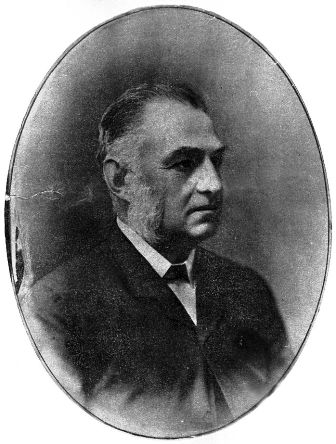 Charles Jeanerrett (at right), who would soon be the contractor for the mail service via The Florrie, afforded a twice weekly trip up the Pittwater estuary in 1879 and a coach to take people there - to meet the steamers at the Manly end on the trip home was dependent on roads being improved:
Charles Jeanerrett (at right), who would soon be the contractor for the mail service via The Florrie, afforded a twice weekly trip up the Pittwater estuary in 1879 and a coach to take people there - to meet the steamers at the Manly end on the trip home was dependent on roads being improved:
THE means of communication between Sydney and Gosford, the Lakes, Pittwater, and the Hawkesbury, will now, it appears, be made more satisfactory to those who desire to visit these picturesque districts. Hitherto bi-weekly communication has been maintained by the steamer Pelican, plying to Barranjouie, at the entrance of the Hawkesbury, and from thence across the bay to 'Brisbane Water, which is entered over a bar by a narrow tortuous channel with only four feet of water at low tide.
Across this bar the sea breaks very heavily when there is a southerly swell. From the peculiar nature of the place, it is considered unsafe, except in very fine weather, for vessels, except those of very light draught and possessing good steering qualities, to enter there and it has been found that excursionists and others object, except as a matter of necessity, to take the sea trip of about twenty miles from Sydney Heads in steamers of a small class. To meet this difficulty, and in the hope that during the ensuing season a considerable number of persons may be induced to visit the Hawkesbury, the owner of the Parramatta River and Brisbane Water line of steamers has had a steamer of great speed and comfortable accommodation built recently by Dunn and Co., of Lavender Bay. This steamer is named the Osprey, and she has been sent to the Hawkesbury, where she will remain if the inducements offered during the ensuing season prove sufficient. Passengers to and from Sydney will be conveyed by Mr. Fraser, of Manly, by Vehicle, from Manly Pier, at 8 a.m., on Tuesdays and Fridays, to Pittwater. The Osprey will take them down the Pittwater estuary to Barranjouie, where they will be transferred to the Pelican, which will arrive there at the same time from Sydney. The Pelican will go across the bay and bar to Gosford, and return after a few hours delay at Brisbane Water, and meet the Osprey again at Barranjouie, where the passengers who prefer the lake and land to the ocean trip will have an opportunity of transhipping and arriving at Manly about dark. If the road is improved with the money voted by Parliament for the purpose, there is no reason why the conveyance, should not catch the 5.80 .steamer from Manly. This would then be one of the most enjoyable trips that could be imagined ; but, if this is not done, it will involve a night's lodging at Manly or a special conveyance to Sydney. While the Pelican is going from Barranjouie to Gosford and returning, the Osprey will make a trip, if inducement offer, about twenty-five miles up the Hawkesbury, and occasionally go all the way to Windsor, leaving the Pelican to fill her place in taking overlanders from Barranjouie to Pitt Water. It is to be hoped that the enterprise of the owner of this line of steamers, in putting on such a fine steamer as the Osprey, will be appreciated, and that the good beginning thus made may lead to the further development of the beauties and resources of Brisbane Water and its surroundings. NEWS OF THE DAY. (1879, July 14). The Sydney Morning Herald (NSW : 1842 - 1954), p. 5. Retrieved from http://nla.gov.au/nla.news-article13438428
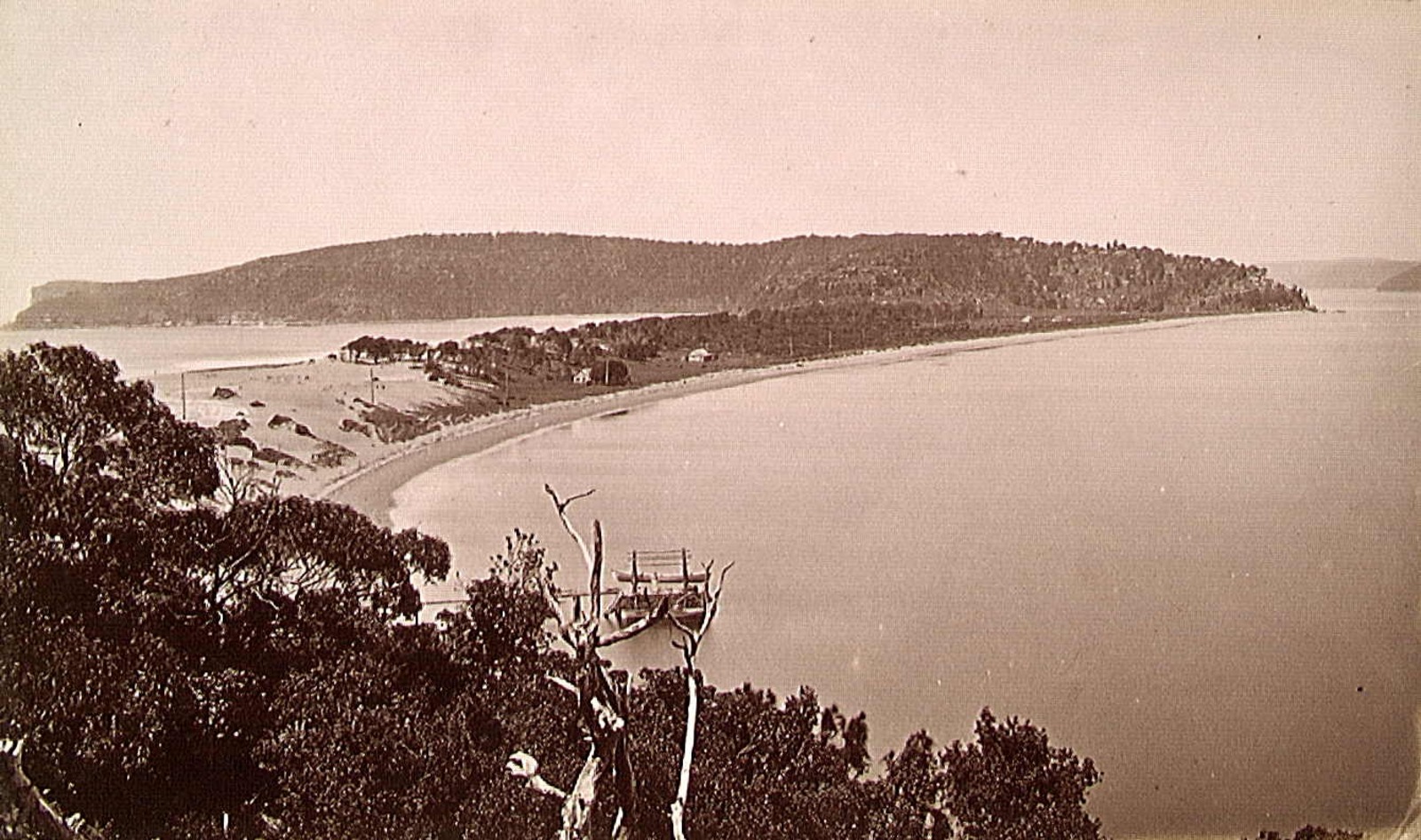
Broken Bay. [picture] (Barrenjoey-Station Beach) by Charles Potter 1889, Item FL15796431, courtesy State Library of Victoria
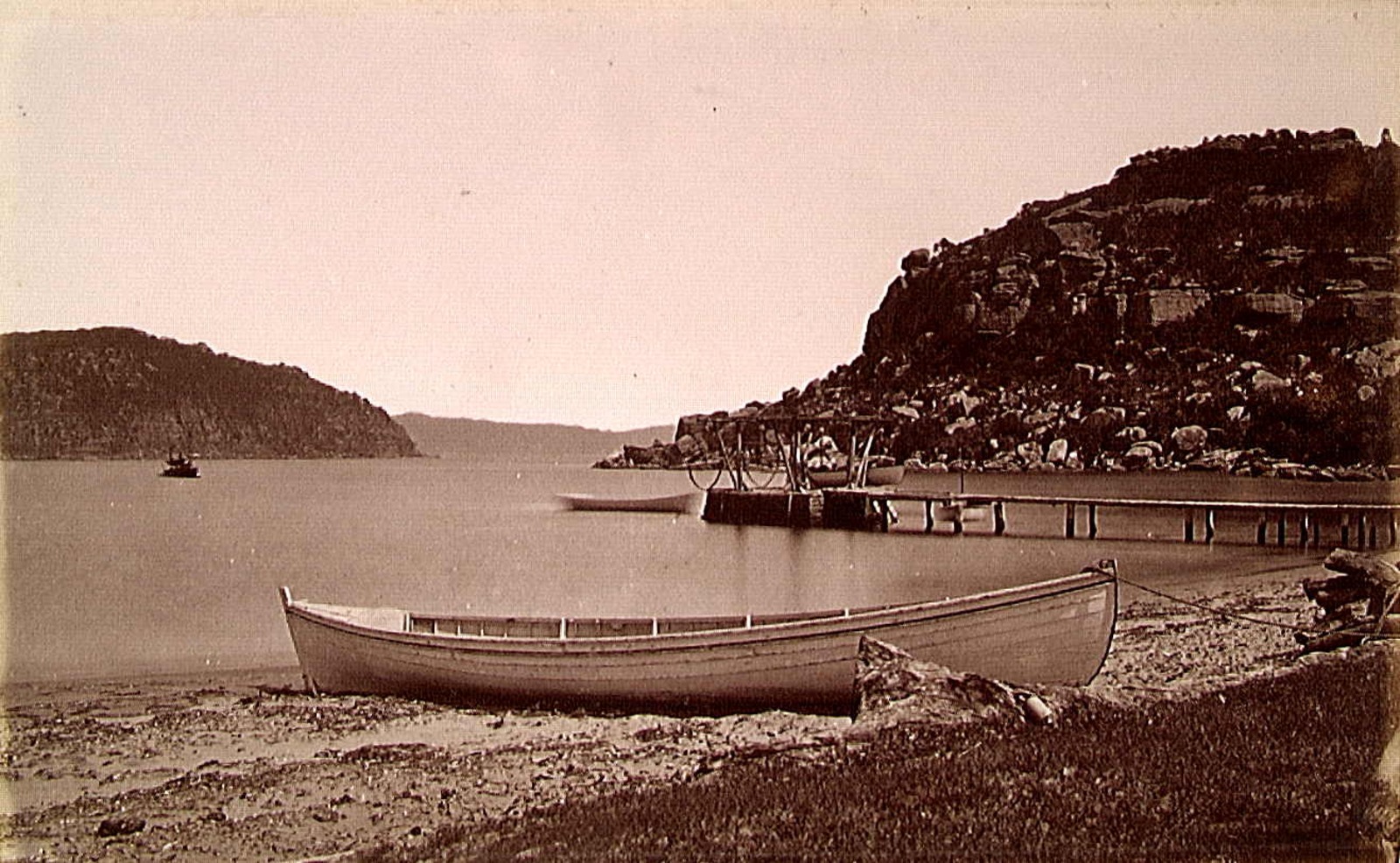
Broken Bay. [picture] (Barrenjoey-Station Beach wharf) by Charles Potter 1889, Item FL15796563, courtesy State Library of Victoria
Howard Castle-Smith, of Woolwich and Sydney; overdue rates, £80 8s. 10d.; land, lot 1, being part of portion 15, Coasters Retreat, Broken Bay. OVERDUE RATES.—SHIRE OF WARRINGAH.—Land to be Sold (1943, June 25). Government Gazette of the State of New South Wales (Sydney, NSW : 1901 - 2001), p. 1098. Retrieved from http://nla.gov.au/nla.news-article222037688
Blind Cove, Pitt Water
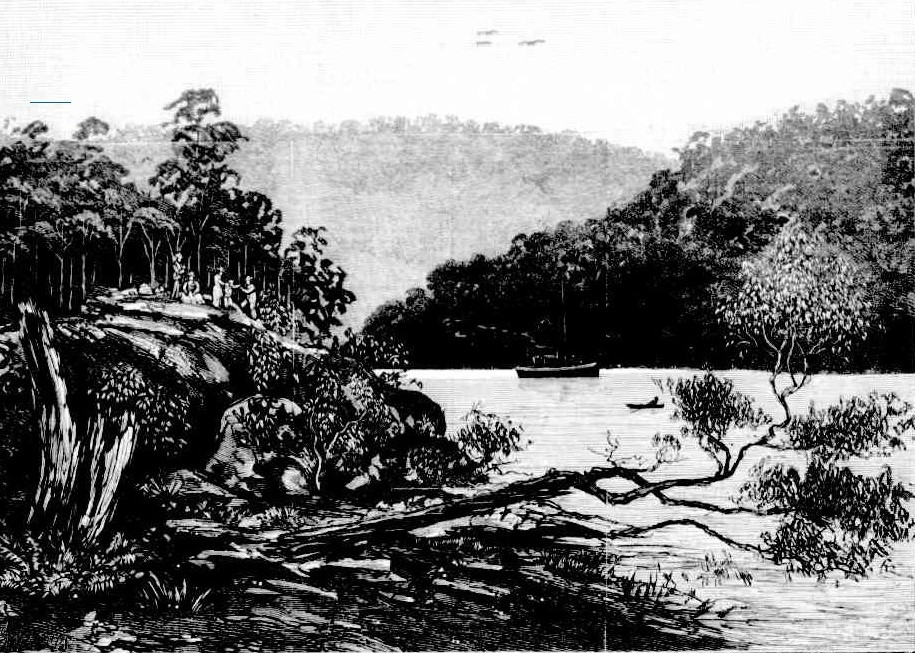
Blind Cove, Pittwater, N.SW. This beautiful little bay shown in our illustration, formerly private property, has been made a reserve of by Government, and is now practically a cruising1 ground for the yachting community of Sydney. A more useful and delightful sheet of water could not have been chosen, situated as it is at the entrance to the Hawkesbusy River, just opposite Barrenjoey. To the north is the broad expanse of water known as Brisbane Water, and to its south Pittwater, which is now connected with Sydney, Newport, and Manly by means of a coach running daily. Blind Cove, also called The Basin, is a safe refuge in the very worst of weather. It owes its name of Blind Cove to the fact of its being invisible to the incomer until he has almost reached its entrance, which is very narrow and hidden from view by a low stretch of sand ; but inside this narrow passage there is deep water, and the height of the hills surrounding the basin (some 600 feet) so thoroughly shelter it from heavy winds that it might well be called Looking-glass Bay. It is on account of this, and also the beauty of the surrounding scenery, that has made it one of the principal rendezvous of yachtsmen. Blind Cove, Pittwater, N.SW. (1883, March 10).Australian Town and Country Journal (Sydney, NSW : 1870 - 1907), p. 26. Retrieved from http://nla.gov.au/nla.news-article70996783
Broken Bay and Brisbane Water.
Among the many very beautiful Jake and sylvan scenes with which the coast of New South Wales abounds, not the l^asl beautiful is Brisbane Water, one of the reaches of Broken Bay, the mouth of the far-famed Hawkesbury. Our illustrations give a very fair idea of Broken Bay and of the splendid sheet of water, of which the inhabitants of Gosford, at its head, are so justly proud and of whose beauties they are so entitled to boast. It was to Broken Bay, it will be recollected, that Governor Phillip was making his way, with a view of ascertaining the eligibility of the country thereabouts for a settlement, when lie had found how unsuitable was Botany Bay for the purpose. On his way, curiosity prompted a peep into Port Jackson, which the immortal Cook had described as a ' boat harbour,' and the result was the discovery of one of the most capacious and beautiful harbours in the world, and the foundation of a settlement which has grown within little more than a lifetime to a splendid city, ' The Queen of the South.'
A glance at our illustrations will show that, had there been no Port Jackson in existence, there was a sheet, or series of sheets, of water of equal magnificence, if not altogether of equal capacity, upon the shores of which a splendid city could have been reared, with surroundings surpassingly romantic and beautiful. Brisbane Water, as we have just remarked, is but one of several fine indentations of the mouth of the Hawkesbury, a river whose beauties Anthony Trollope has attempted to describe in the most superlative of terms.
'There can, I think,' says the great novelist, 'can be no doubt that among rivers the Rhine has the highest character for sustained beauty. There may be special point* on other streams which have endeared themselves to the world — such especially as the Falls of Niagara, such as the Inn at Innsprack, or the Rhone at Geneva— as the Upper Lake at Killarney, which is in truth a river. But for continued scenery the Rhine stands first. There is a river, or rather portion of a river, known to very few tourists, which, I think, beats the Rhine. This is the Upper Mississippi, for about 150 miles below St. Paul's. It is not my business here to describe the Mississippi, but I mention it with the object of saying that in my opinion the Hawkesbury beats the Mississippi and then, after contesting the features of these respective rivers, Mr. Trollope goes on to say,
' On the Rhine, on the Mississippi, on the Hawkesbury alike, there is created an idea that if the traveller would only leave the boat and wander inland he would be repaid by the revelation of marvellous beauties of nature.'
Those only who know anything of the scenery of the Hawkesbury are aware that this was not a mere ideal picture which the great novelist was conjuring up to himself. Imperfect as a sketch must be as a means of conveying a full idea of the matchless beauties of nature, our picture nevertheless succeeds to some extent in helping to realize Trollope's description.
One of our views is taken from the landing-pier near Gosford, the eye following Brisbane Water to its junction with the mouth of the Hawkesbury ; Mount Elliot, its shape reminding' one somewhat of a lion couchant, being in the distance. In going from Sydney by steamer, Mount Elliot, to named from its similarity with the north end of Gibraltar rock, rises up with stupendous grandeur. It forms a complete island. Barranjuey, with its two lighthouses, is to the south-east of Mount Elliot, and forms the southern head of the entrance to Broken Bay.
Passing these two bold rocks, which are clothed with verdure to the water's edge, as, indeed, are all the hills and shores around, and leaving the entrance to Pitt Water to the south, the steamer turns in a north-westerly direction. Passing over the Brisbane Water bar, a view of perfect enchantment and still life opens up. The ocean is suddenly lost sight of, and the steamer makes its way over a broad sheet of smooth water and past innumerable sylvan retreats on its. banks. Generally speaking, the shores are covered with verdure in most places, and slope gently down to the water's' edge. Even- here and .there, however, are small patches of sandy beach, the whole being backed by low hills covered with the timber for which the locality is justly celebrated. Brisbane Water is about 10 miles in length, and varies from a couple of chains to two and a-half miles in width, its widest part, Broadwater, having the town of Gosford in its vicinity. The approach for vessels at present is through rather tortuous channels : but the great drawback lo navigation is the bar near to the entrance. The chief trade 'carried on is in timber, 'for which the district is famous. The most valuable timber trees the colony can produce, either for shipbuilding or for any other purpose, grow to great perfection in the Brisbane Water district, and tho annual exports of timber are very large. The agricultural resources of the surrounding country are by no means insignificant. The population is small and scattered. Gosford, a thriving little place, is the principal township. Between Gosford and Sydney there is steam communication twice a week.
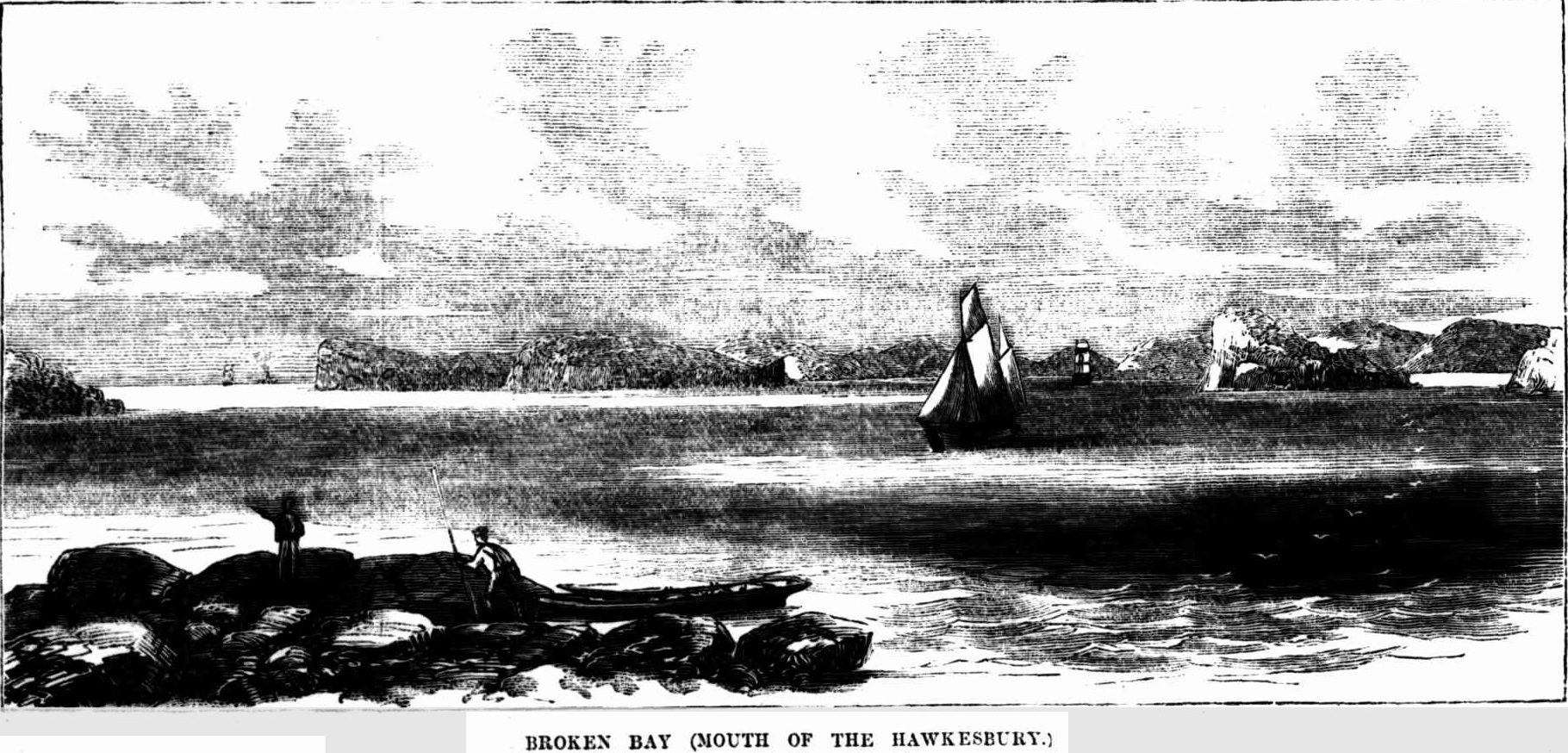
BROKEN BAY (MOUTH OF THE HAWKESBURY.) Broken Bay and Brisbane Water. (1878, November 23). The Sydney Mail and New South Wales Advertiser (NSW : 1871 - 1912), p. 812. Retrieved from http://nla.gov.au/nla.news-article162696914
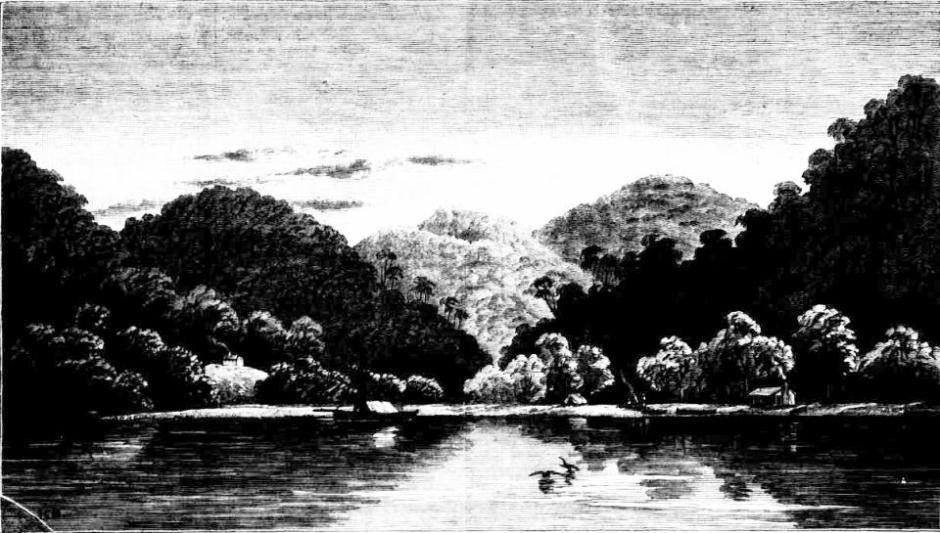
PITTWATER BASIN, HAWKESBURY RIVER. No title (1885, August 22). The Sydney Mail and New South Wales Advertiser (NSW : 1871 - 1912), , p. 400. Retrieved from http://nla.gov.au/nla.news-article162822900
VOLUNTEER COASTAL PATROL.
Co-operation with Troops.
Motor boats manned by members of the Volunteer Coastal Patrol co-operated with the 4th Battalion and a machine of the Royal Australian Air Force last night in a coast defence exercise near Narrabeen, where the battalion is in camp. Members of the Coastal Patrol a voluntary and unofficial organisation are in camp at Broken Bay
Their boats left Broken Bay yesterday afternoon and they approached the defended section of the coast in dark-ness the object being to give both troops and airmen practice in detecting the approach of hostile craft.
The plans provided for the dropping of flares by the plane to determine the position of the invaders.
VOLUNTEER COASTAL PATROL. (1939, November 23). The Sydney Morning Herald (NSW : 1842 - 1954), p. 10. Retrieved from http://nla.gov.au/nla.news-article17617918
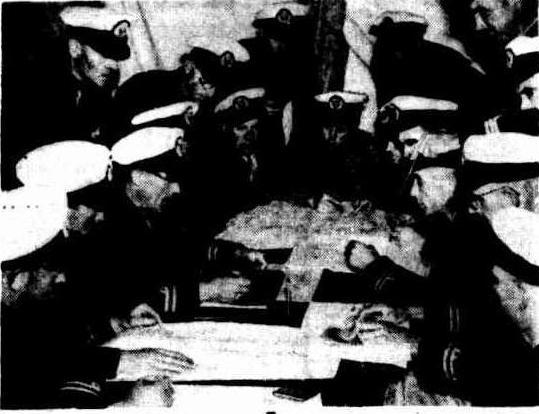
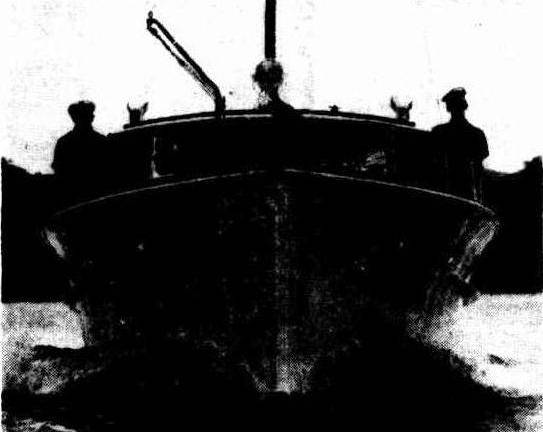
The New South Wales Volunteer Coastal Patrol, comprising motor-yacht owners who are learning auxiliary naval work is undergoing a week's training at Pittwater. More' than 100 members are in camp Top-Skippers plotting their course on charts before going to sea. Lower -The motor-yacht Pelorus, one of the many fine craft patrol, leaving the training station for manouvres. NAVAL TRAINING FOR COASTAL PATROL. (1939, November 24). The Argus (Melbourne, Vic. : 1848 - 1956), p. 1. Retrieved from http://nla.gov.au/nla.news-article11286375
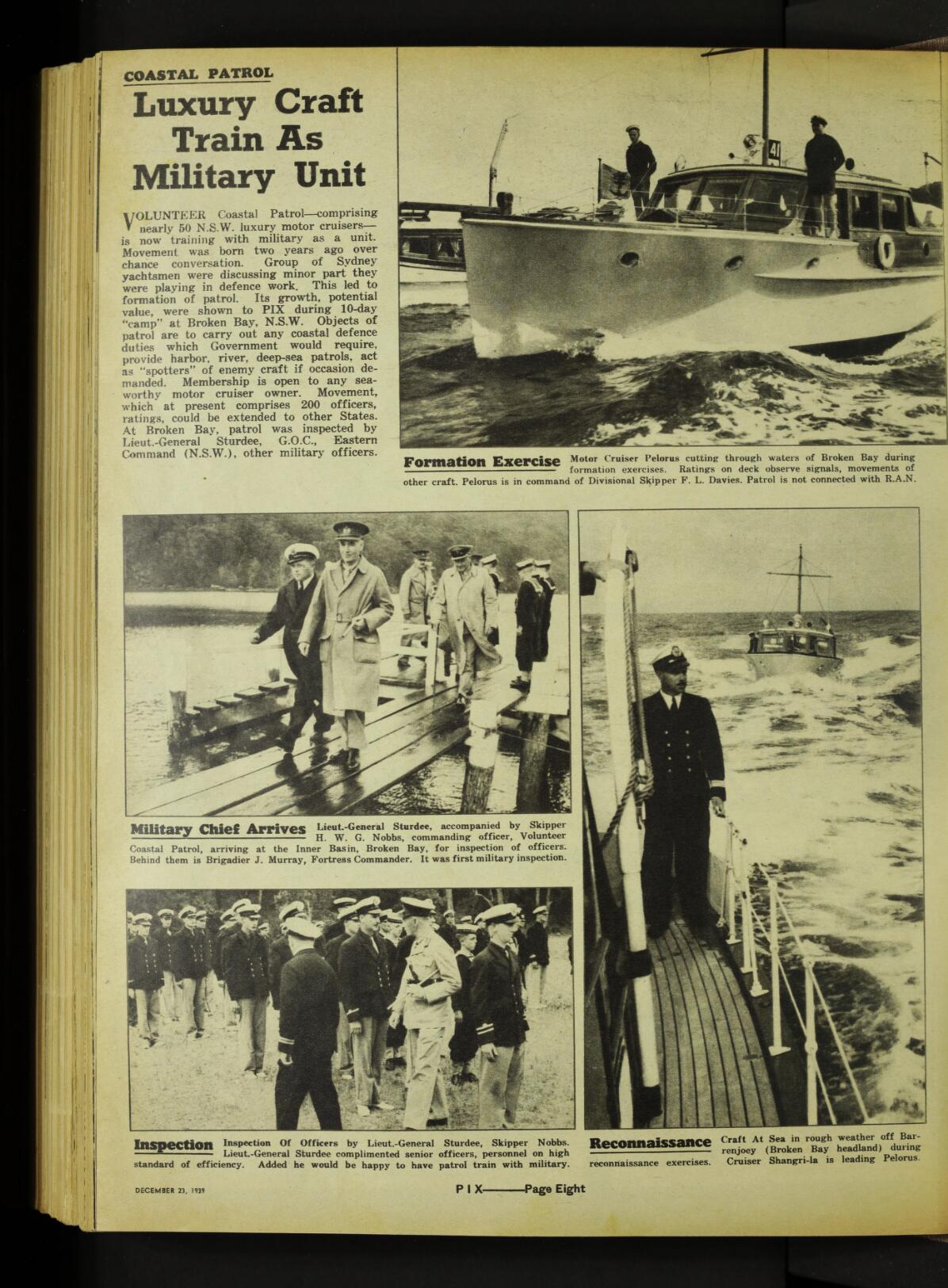
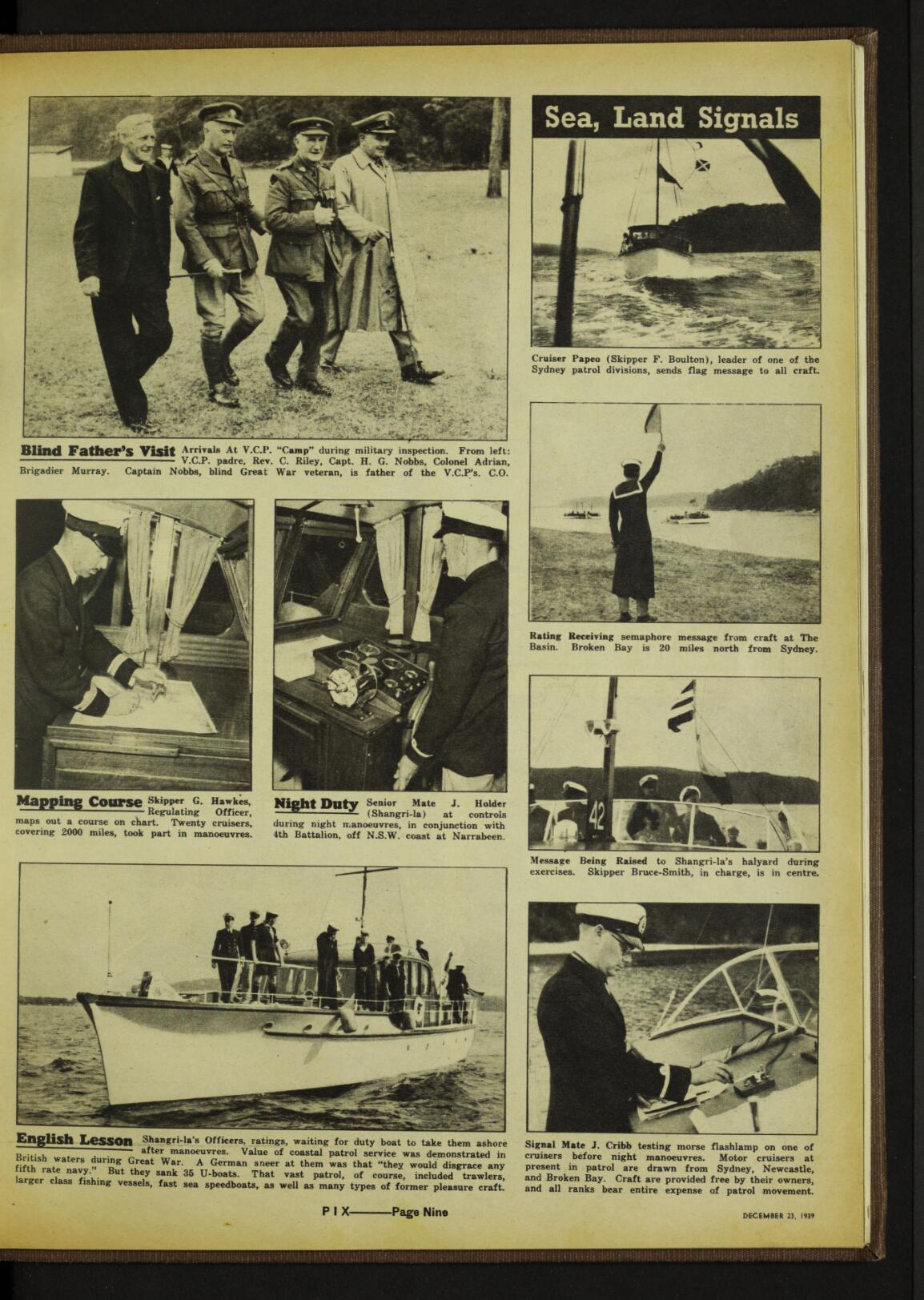
(1939). December 23, Pix, Volume 4, No. 26, pages 8-9. Retrieved from http://nla.gov.au/nla.obj-467076244
Frank Davies commissioned PELORUS from Halvorsens with the specification that it be strong enough to carry a gun on the foredeck. The motor cruiser was completed in 1939 and commandeered by the Royal Australian Navy during World War II for checking coastal defences. PELORUS went on to serve with the Volunteer Coastal Patrol and was used for police work and for assisting the Australian Army in the positioning of searchlights on beaches. It was later renamed PRINCESS NEVERFAIL.
In marine navigation, a pelorus is a reference tool for maintaining bearing of a vessel at sea. It is a "dumb compass" without a directive element, suitably mounted and provided with vanes to permit observation of relative bearings. Carl and Trygve Halvorsen were among the early members and the boat building family donated the use of its Neutral Bay boatshed for use as the VCP Depot ‘Seahorse’.
By June 1940, the Coastal Patrol had begun additional operations with the Army as part of the Newcastle/Port Kembla Covering Force under Major General Fewtrel including combined Invasion exercises with the 1st, 4th, 17th, and 45th Battalions between Port Hacking and Cape Three Point. In the Spring of 1941 another exercise was carried out in Pittwater:
"INVASION" OF N.S.W. COAST. Force Makes Inland But Is Repulsed SYDNEY, September 12. The invasion exercises carried out this morning on the shores of Broken Bay and in French's Forest have satisfied Army officers that an actual invasion of the New South Wales coast could be repulsed. Although the invading force, in theory, smashed the coastal defences at Broken Bay, managed a successful landing, and pushed several miles inland, the advance was halted when reserves were rushed up and it was eventually pushed back into the sea. The invasion exercise was the culmination of a week of manoeuvres in which the Navy, Army and Air Force took part, and which were devised to test the communications and co-ordination of the three services in the defence of the coast. An Army spokesman said today that manoeuvres had been entirely successful, and many valuable lessons had been learned. All the material collected during the exercises was being carefully studied by the defence chiefs. Residents of Palm Beach, Newport, Mona Vale and French's Forest awoke yesterday morning to find fully-armed soldiers guarding all the strategic points on roads. Early morning motorists and bus drivers found roads blocked with barbed wire and traps, and were challenged by dust-begrimed militia men These were the invading forces -carefully selected men of the 2nd Division, Home Defence Force—who had been landed before dawn—theoretically—from an enemy convoy and had overcome the local defenders. Covering Force Lands The 2nd Division men were taken into Broken Bay before dawn in a naval vessel and landed at three points in motor launches by the Naval Auxiliary patrol. They represented the covering force of an attacking brigade. The first party was landed at a jetty on the Pittwater side of Palm Beach. The members sprang into motor lorries which were waiting, and which represented armored fighting vehicles. They overcame and captured detachments of defenders until they reached Mona Vale, where there was a battle for the junction of the road from French's Forest. Without meeting opposition, the second party landed at Church Point and raced to the junction of the Church Point and Pittwater roads through French's Forest. The third landing party got ashore at Coal and Candle Creek, captured defenders there and overran a large part of Pittwater road. By dawn a great section of French's Forest and the coast from Mona Vale to Palm Beach was in occupation by the covering force of the invading troops. But their success was only temporary. Men of the 1st Division Militia were racing from a, big military camp in trucks, Bren-gun carriers and other fighting vehicles to French's Forest. The arriving defenders halted the advance and, as the reserves arrived, counter-attacks were made, and the invaders were gradually driven back. Artillery was brought upto shell the attackers out of strategic points. Because of the great amount of cover provided by the trees, the defending troops were able to carry put flanking movements to dislodge the invaders. "INVASION" OF N.S.W. COAST. (1941, September 13). The Advertiser (Adelaide, SA : 1931 - 1954), p. 6. Retrieved from http://nla.gov.au/nla.news-article44956820
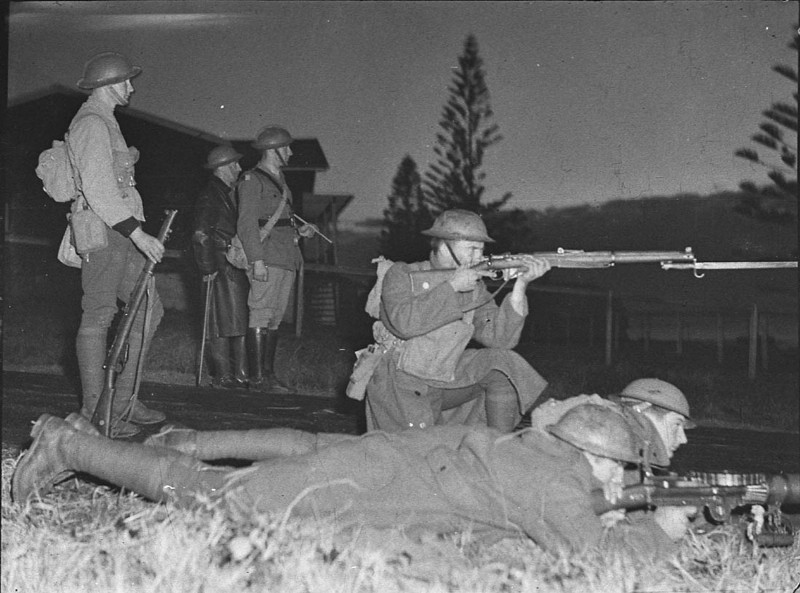
'Dawn attack at Mona Vale', date: 8/1938 (?),Image No: hood_18861 from Home and Away series, courtesy State Library of NSW.
Coastal Patrol was then requested to establish and maintain a security guard around the large troop ships, which began to operate from the port in April 1940. The Queen Mary was in port for several weeks to be converted from a luxury liner to a troop ship. At this stage, the defence boom had not been built and this lull before the storm was referred to as the ‘Phoney War’.
The Government declared that Coastal Patrol vessels and bases should wear the State Ensign in recognition of the work the Patrol was doing and the official capacity it now had. The Ensign was presented to the OC, Harold Nobbs in August 1940, at a formal ceremony at Killarney, a recreation area in Middle Harbour. The presentation was made by Police Superintendent Ferguson.
In NSW, where the Coastal Patrol maintained the port security of Sydney Harbour (wharves, oil installations, bridges and extremities), they were both Special Police Constables of the ‘Water Police Reserve’ and, as the 'Sydney Harbour Patrol’, held Warrants from the Maritime Services Board to enable them to board ships and wharf areas. All crew were required to carry side arms.
By 1941, the Patrol was operating in three States with over 2,000 members and 500 small ships. Manoeuvres were held at Clontarf in February of 1941, for extensive training in aircraft recognition and signalling.
In August 1941 a Naval Auxiliary Patrol was formed. While a total of 662 private boats were used, 87 NAP vessels were formally commissioned into the RAN. August 1941 was also when Captain Blackwood died.
NAVAL AUXILIARY PATROL. Enrolment Begins To-day. Enrolment of men and vessels for the Naval Auxiliary Patrol will begin in Sydney to-day. Units of the patrol are to be formed at ports around the whole coastline of Australia. Privately owned yachts motor vessels fishing boats and all types of suitable small craft will be enrolled for service in the New South Wales squadron of the patrol not only in Sydney but at all coastal towns. The squadron which is under the command of State Skipper P E Scrivener will be organised in flotillas of 32 vessels each. Each flotilla will comprise four divisions of eight vessels except at small ports where there may be a smaller number of vessels in a division.
Vessels will remain under the control of their owners who will be trained in seamanship navigation signalling and first aid. Volunteers for manning the craft aged between16 and 60 are required. Duties and training of the patrol will be carried out in spare time and valuable experience will be given to all personnel. A thorough syllabus of training has been approved by the Naval Board. Men with experience of handling fishing vessels and competent to carry out patrol work outside harbours are particularly sought. Offers of vessels and of personal service should be made to the headquarters of the unit Broughton House 181 Clarence Street Sydney between 2 30 and 6p m and 7 and 9pm each day. NAVAL AUXILIARY PATROL. (1941, August 18). The Sydney Morning Herald (NSW : 1842 - 1954), p. 4. Retrieved from http://nla.gov.au/nla.news-article17745092
BLACKWOOD. - August 26, 1941, at Prince of Wales Military Hospital, Randwick, Captain Maurice Blackwood, D.S.O., R.N., of Huon Park, Turramurra, beloved husband of Dorothea Blackwood, aged 58 years. (By request, no flowers.) Family Notices. (1941, August 28). The Sydney Morning Herald(NSW : 1842 - 1954), p. 14. Retrieved from http://nla.gov.au/nla.news-article17752068
For most of the war years the Coastal Patrol in NSW was based at Craig Nathan at Neutral Bay, once the home of Ben Boyd. They patrolled over 128,000 nautical miles, entailing over 393,600 man hours during the period 1938 to 1945.
Late in 1941, the Coastal Patrol’s aims were changed slightly:
- To encourage the volunteer services of yachtsmen and others interested in seamanship, to undergo a course of training so that their services would be of value to Australia as may be required. This gave the Coastal Patrol a wider term of reference to assist all authorities. These aims, incorporated into the first Constitution dated January 1955 - then widened in 1961 - remain in the present Articles to this day.
VOLUNTARY COASTAL PATROL Valuable Auxiliary Service MORE MEN AND BOATS NEEDED
BY A STAFF CORRESPONDENT
Under the guidance of the Royal Australian Navy, the Naval Auxiliary Patrol is taking a rapidly-increasing part in the defence of Australia. The New South Wales Squadron now operates from five important ports, with private vessels given freely to the service, and manned by experienced but honorary crews. Its unofficial motto is simply "Service Without Fireworks."
Although the Naval Auxiliary Patrol is not a fighting arm, it is based on the same things as Australia's fighting services: picked and trained personnel; equipment; planned and organised duties; and leadership and morale. The important point, so far as the personnel are concerned, is that they are all men ineligible to be called up for service under the Defence Act; that they are not obliged to serve, but have chosen to do so without payment. Their only return Is the knowledge that they are carrying out valuable work. In age they vary from 16 years to 60. In experience they vary from men who have sailed the seas and skies of the world to business man who have rarely set foot to decking. As long as they have the essentials-a love of ships and the sea and an anxiety to assist in Australian defence-they take their place in the patrol.
500 MEMBERS
Not all members, of course, are boat owners. Many gained their experience, or their living, in other people's craft. The membership list includes many former members of the Yachtsmen's Auxiliary and the Volunteer Coastal Patrol, but others have never before been in an organised movement of this kind. Because the Naval Auxiliary Patrol does not enrol men liable to be called, up for military service it includes no fit single men under the age of 35. and its members are in the main men of mature years, many of whom saw service in the Navy, the merchant marine, or the Air Force in the Great War. Many have decorations-about which nothing at all is said.
The patrol already operates from Port Jackson, Botany Bay. Wollongong, Broken Bay, and Newcastle, and is being organised in other outports. The Newcastle patrol is the most recently formed. Membership in New South Wales is now about 500, but if men come forward as they are needed to carry out the increasing duties of the patrol the number will increase, it is hoped, to 1000. Details of the equipment of the patrol cannot be disclosed, because it is considered unwise to show how strong a hand the service is holding. For instance, the number of vessels In the patrol in Australia cannot be given.
The members have already begun training and attend regular lectures by honorary instructors in seaman-ship, navigation, radio, first aid, signalling, and other essential subjects. The courses are modern and thorough. Signalling, for example, includes Morse code, semaphore, and Aldis lamp. Some of the instructors have had experience in air navigation; others acquired their skill in merchant and naval vessels. Young or elderly, patrol members have to go back to school in their spare time.
NIGHT PATROLS
The patrols work at night both inside harbours and out along the coast. Each boat has its fixed crew, and does one night of patrol work only before returning to the bottom of the roster to await its turn. This gives each member of the patrol an equal amount of practical training and disturbs as little as possible the home and business lives of crews. A standby boat is kept in service.
The patrol craft range in size from small boats to luxury cruisers and vessels up to l8 tons. In peace-time they served purposes as varied as the occupations of their owners. Some stretched out in top grade racing; others may have been seen filled with laughing people in the quieter reaches of our waters; on others fishermen bent their nets.
Part of the work of the Naval Auxiliary Patrol is described simply as "implementing the National Security Regulations." In port this entails keeping constant watch on wharves, storages, and harbour installations; supervision of ships in midstream to see that no unwanted persons are able to get on board; and always an eye to the shore for signals. Four people at least in Sydney owe their lives to patrol crews who fished them from the harbour, two of them having fallen unnoticed from passing passenger boats.
The most important aspect of the patrol's work at present is its co-operation with the Navy, which directs Its operations. The patrols, by carrying out much of ¡he routine work which normally would fall to the Navy, release younger men for other duties. The commodore in charge of Naval Establishments, Sydney, Commodore G. C. Muirhead-Gould, has realised its value, and has taken the lead in the development of the patrol in this State.
ARMY CO-OPERATION
Plans have been prepared also for co-operation with the Army, Exercises have already been carried out in conjunction with land forces at several towns along the coast. Other services include communication with forces in isolated places, and co-operation with garrisons.
Land stations are being established at points along the coast to permit communication between the patrol vessels at sea and the naval and army authorities on land. Men experienced in signalling, and others who would be willing to serve in these shore stations, are needed by the patrol. Their value in the event of an attack on Australia, and, indeed, the value of all the strong craft and trained men of the patrol, can easily be seen. The patrol is not intended, however, to assist one national service more than another. It is a unified service with an organised central control, and can be placed as needed to give help in an emergency. The patrol is ready to assist the sea, air, and land forces, including the National Emergency Services wherever possible. The discovery of a minefield, a raider at large, a shipwreck, a plane fallen into the sea, a harbour fire or any of the countless other possibilities of war-will see the patrol ready to rescue, warn, or merely watch and wait.
MORE MEN NEEDED
Another aspect of the work of the patrol in Australia is this: Off the coast of Britain thousands of fishermen and boatmen keep constant watch for mines, U-boats, and enemy surface ships and aircraft. They responded in hundreds to the call of Dunkirk. The number of small boats working off the Australian coast is comparatively few and the vigil has been undertaken as far as possible by the Naval Auxiliary Patrol. Like the Navy, which looms over it, the patrol does its work silently, and well. Men and boats are needed. The ideal position would be for just enough men to be enrolled to take charge of boats as they are obtained; but no one who feels that he could assist need hesitate to offer his services. VOLUNTARY COASTAL PATROL. (1941, November 27). The Sydney Morning Herald (NSW : 1842 - 1954), p. 8. Retrieved from http://nla.gov.au/nla.news-article17776100
Since its inception in 1937, the Coastal Patrol has been organised at all levels, from National Headquarters to individual Divisions, into two parallel arms; ‘Operations’ and ‘Administration’. For the first 17 years of its existence, successive Officers Commanding operated from a National Headquarters in Sydney were advised by two principal Staff Officers, (one for Operations and one for Administration). They personally established Patrol policy and directed the operations and administration of the Patrol’s individual Divisions, which, from first formation, have been the operational heart of the Patrol.
Based on the Royal Australian Navy’s original concept of the Patrol, “as a volunteer body of yachtsmen and others interested In seamanship who would undergo a course of training so that, with utilisation of their own owner-skippered boats, they could be of service to the Navy or Military in the event of any National emergency” at its formation, four owner-skippered boats formed a Division and 4 of these Divisions comprised a Flotilla under a Flotilla Skipper. Post-war, to meet the task outlined in Chapter 2, Divisions had to expand from a predominantly boating organisation into one with three arms; Marine Rescue Radio Bases, Rescue Boats, and Education in safe boating.
With peace and the return to recreational boating and the VCP turned its focus to boater education and civilian search and rescue. The first Patrol-owned boat was an ex-Naval cutter, Juno, which began service in 1947, primarily as a training vessel for new recruits.
Various donated, sponsored and purchased boats were acquired, including four Maritime Services Board pilot boats and later, self-righting Waveney and Arun lifeboats imported from Britain. Vessel and radio training progressively became more formalised and operations extended along the coastline, with 25 NSW divisions eventually providing a volunteer rescue service and marine radio watch from Cape Byron to Eden.
The Broken Bay Division was part of the original foundation organisation and was administered as part of the Sydney region command. In 1947, a separate division was set up known as the Broken Bay Division, with Skipper Ray Weingott as its first Divisional Commander, and was operated directly from the members' own private vessels.
Since then, the Division has operated from bases at Church Point, Royal Prince Alfred Yacht Club and Royal Motor Yacht Club. The Division moved to the Royal Motor Yacht Club, in 1992, who donated the use of two rooms as a Base. They, also, generously provided berthing facilities for rescue vessels along with other assistance. On 12th March, 2005, the Division moved to its own premises, acquired with the much-appreciated assistance of the Pittwater Council, within the grounds of the Bayview Boat Ramp. The wheelchair-friendly Base boasts a radio room, administration office, two bunk rooms, galley, and a large education/meeting room.
In 1954, the then Officer Commanding of the Coastal Patrol, Harold Nobbs, decided to make the Patrol’s organisation less autocratic and held elections by which all members of the Patrol could choose a representative National Council. This elected Council was to be responsible for dictating policy, determining uniforms to be worn, appointing the Officer Commanding and controlling the Patrol’s finances.
1954 also bears witness to the VCP and the RMYC at Broken Bay maintaining their dedication to all service peoples and their children. The article below is one of several in consecutive years of picnics for Legacy:
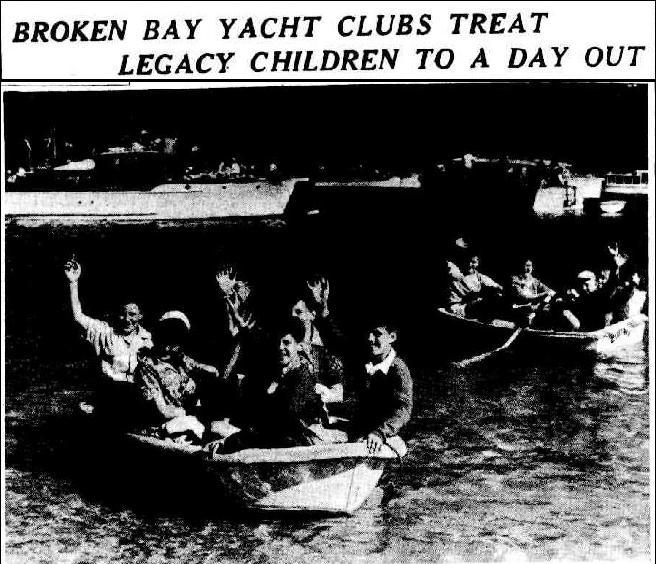 BROKEN BAY YACHT CLUBS TREAT LEGACY CHILDREN TO A DAY OUT.
BROKEN BAY YACHT CLUBS TREAT LEGACY CHILDREN TO A DAY OUT.
Some of the 1,064 Legatees after a picnic at Broken Bay yesterday wave farewell to their hosts. Members of the Royal Motor Yacht Club (Broken Bay),the Volunteer Coastal Patrol and the Kuring-gai Motor Yacht Club joined forces to treat the youngsters to a day out. They used 65 boats to take the children for a trip up the bay from Church Point. The appetites of 1,064 Legacy children at a picnic at The Basin, Pittwater, yesterday, astonished the organizers. The children demolished 6,000 bottles of soft drink.6,000 sandwiches and bread rolls, 6,000 cakes, and 2,000 pieces of fruit. The picnic was organised by the Legacy Club of Sydney, the Broken Bay branch of the Royal Motor Yacht Club, the Volunteer Coastal Patrol, and the Kuring gai Motor Yacht Club. The yacht clubs and the Volunteer Coastal Patrol provided the food and 70 cruisers to take the children from Church Point to The Basin and back. And 167 cars and buses were used to take the children from Legacy House, city, to Church Point and back. About 300 adults looked after the children. BROKEN BAY YACHT CLUBS TREAT LEGACY CHILDREN TO A DAY OUT. (1954, November 22). The Sydney Morning Herald(NSW : 1842 - 1954), p. 1. Retrieved from http://nla.gov.au/nla.news-article18449699
A 1957 incident:
Floating Mine Scare At The Entrance
SYDNEY, Sunday.—All shipping was to-night warned to steer clear of The Entrance because of a possible unexploded mine floating off Box Head. The object, which was described as "6ft. in diameter with horns," was first sighted by two fishermen.
The fishermen informed the Pittwater Volunteer Coastal Patrol, who sent a launch to investigate the object. They found it floating about one foot below the surface. Crew members of the launch believed it was an unexploded mine and informed police. A R.A.N. explosive crew was immediately sent by truck to Pittwater, where the launch was waiting.
The crew, however, arrived at Pittwater shortly before dark and it was decided to make a search of the area to-morrow. The Deputy Director of Shipping and Navigation has warned all vessels to keep clear of the area until the object has been identified. Floating Mine Scare At The Entrance. (1957, September 23).The Canberra Times (ACT : 1926 - 1995), p. 1. Retrieved from http://nla.gov.au/nla.news-article91238046
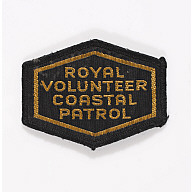 In 1963 the Patrol became an Incorporated Company registered in New South Wales with the Corporate Affairs Commission as a Company Limited by Guarantee under the Companies Act of 1961. It later became a Registered Charity. Registered Offices were established in all States of the Commonwealth. The Memorandum and Articles of Association of the Patrol were issued on 13th June, 1963
In 1963 the Patrol became an Incorporated Company registered in New South Wales with the Corporate Affairs Commission as a Company Limited by Guarantee under the Companies Act of 1961. It later became a Registered Charity. Registered Offices were established in all States of the Commonwealth. The Memorandum and Articles of Association of the Patrol were issued on 13th June, 1963
In a tradition continued by MRNSW, its members became a visible presence for major Sydney Harbour events, including royal visits, the opening of the Opera House, the start of the Sydney to Hobart Yacht Race, the 1988 Bicentenary and the 2000 Olympic Games, during which 88 volunteers gave more than 5,000 hours’ service.
Rehearsal Of Royal Tour Start.
A rehearsal of manoeuvres to control small craft on Sydney Harbour on February 3, when the Queen and Duke of Edinburgh arrive, will be held by the Volunteer Coastal Patrol at Broken Bay this morning. The State Director of the Royal Tour, Mr. P. H. Roper, announced this last night. About 35 motor and sailing craft, under the command of the officer commanding the Volunteer Coastal Patrol, Mr. H. W. G. Nobbs, would participate in the rehearsal. Mr. Roper said the Sydney Harbour Master, Captain D. McRae, would watch the rehearsal. He said that units of the Volunteer Coastal Patrol would co-operate with the Royal Australian Navy, R.A.A.F., and police to control the movements of many thousands of small boats on the day of the Royal landing. The Volunteer Coastal Patrol will assist in keeping unauthorised craft out of prohibited areas. These areas will be marked by 63 buoys which will not be placed in position until the day of the Royal arrival. Mr. Roper said: "The Royal Visit Committee anticipates that a great many craft from practically all the harbours and rivers along the New South Wales coast, as well as visiting craft from other States, will augment the Sydney contingent of craft. The latter will come from almost every slipway, every bay and cove in the Harbour." Mr. Roper added that among the actual participants in the pageant would be 380small boats forming a double banked laneway, through which the Royal barge would bring the Queen and the Duke to the landing pontoon in Farm Cove. Rehearsal Of Royal Tour Start. (1953, December 12). The Sydney Morning Herald (NSW : 1842 - 1954), p. 4. Retrieved from http://nla.gov.au/nla.news-article18400977
The Officer Commanding the Volunteer Coastal Patrol, Mr. Harold Nobbs, said last night that 40 Volunteer Coastal Patrol vessels would control between 4,000 and 5,000 small craft on Sydney Harbour on Wednesday. Nearly 200 men would man the patrol vessels. The mother ship of the patrol fleet would be the 48-foot cruiser Alberon. Mr, Nobbs said he would be in direct contact with all his patrol vessels from the Alberon by two-day radio. The patrol would start work on Wednesday at 4.15 a.m. and would be on duty in the harbour continuously until 10 p.m. SYDNEY'S BUSY WEEK-END. (1954, January 30). The Sydney Morning Herald (NSW : 1842 - 1954), p. 7. Retrieved from http://nla.gov.au/nla.news-article18407330
Locally you will see the Marine Rescue Broken Bay unit on the estuary every weekend and at ocean events such as the Ocean series of Pittwater Swims or the annual Lion Island Challenge, hosted by Avalon Beach SLSC.
In 1974 the Queen granted approval for the VCP to add the prefix “Royal” to its title. Recognising its funding and recruitment limitations, the RVCP keenly supported the transition to MRNSW. In 2019 only a South Australian presence remains, with two boat bases and seven radio bases.
By 1990 Operational Divisions of the Coastal Patrol had been established in all States of the Commonwealth except in Western Australia and the Northern Territory.
On 1st January, 2010, the Royal Volunteer Coastal Patrol, Australian Volunteer Coast Guard and Volunteer Rescue Association were unified into one organisation, Marine Rescue NSW.
During the years since its foundation, the Broken Bay Unit has provided the radio coverage and rescue facilities for the boating public in the area and assisted in the setting up of three other units as requirements grew. These other units are at Gosford, Hawkesbury and the Radio Centre at Terrey Hills (call sign 'Marine Rescue Sydney').